

Getting around in Delhi, India: A guide to the Delhi Metro
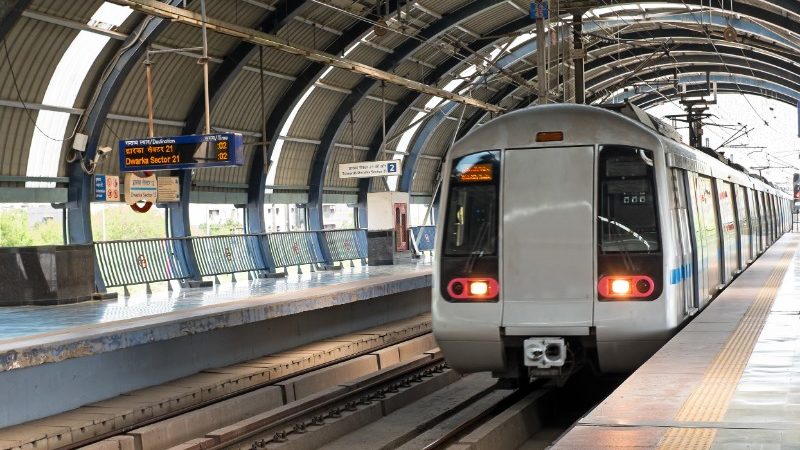
With a population of nearly 19 million people, New Delhi in India is one of the largest cities in the world – which means that getting around while you’re there can be quite difficult.
You can use a ride-sharing app like Uber, or take an auto rickshaw, yes, but because there’s so much traffic, those rides can take forever , which is why taking the Delhi Metro may be your best bet. Bonus: Hopping on the metro is also a great way to get to know the city, and it’ll save you money too.
So here’s everything you need to know about the Indian capital’s public transit system:
A Brief History
For starters, the metro system in Delhi is still relatively new; it opened in December 2002. One of the most important facts about it is that it’s the first railway system in the entire world to get a United Nations certification for reducing greenhouse gas emissions. This is huge for Delhi, and, as a result, locals are very proud of their metro.
The metro has eight main lines, divided by colour – red, yellow, blue, green, violet, magenta, and pink – plus an eighth one, the orange line, that goes directly to the airport. There are around 184 metro stations in total, both underground and above ground – but they’re all air-conditioned. That air conditioning factor certainly isn’t as big a deal as the United Nations certification, but it’s definitely up there, as Delhi heat is no joke.
SEE THE REAL INDIA ON AN INTREPID SMALL GROUP ADVENTURE NOW
Getting Around
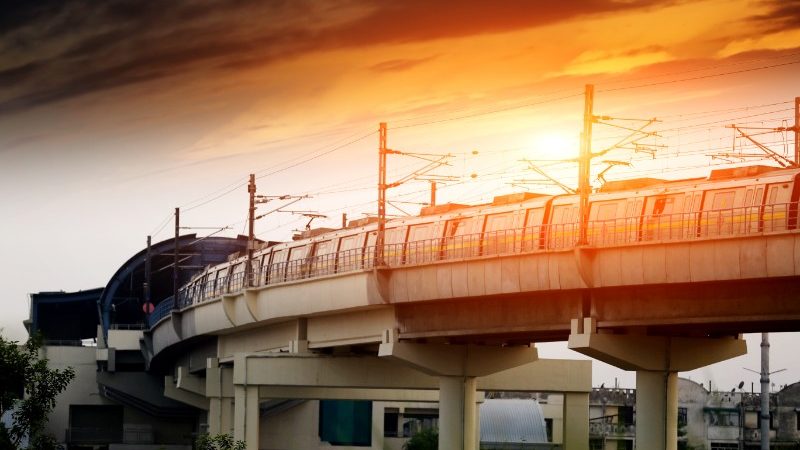
Image by Sonia Dhankhar
As you may expect from such a sprawling railway system, there are a couple of key rules and guidelines that you should know before you go:
1. To buy a ticket, which is either a card or a token, you have to go to the ticket counter at every station. Generally speaking, tokens are best for one-way trips, and cards are better if you are a frequent traveller. You can also purchase a Special Tourist Card, which gives you an unlimited number of rides for a limited amount of days. A one-day Tourist Card is 200 rupees (150 rupees + 50 rupees for the card itself, though the card is refundable), and a three-day Tourist Card is 500 rupees (450 rupees + 50 rupees for the card itself, which, again, is refundable).
2. The fare is not a set rate. Rather, it’s based on where you’re going. Unlike cities like New York, which have a set rate for a subway ride no matter where you’re going, the Delhi Metro charges you based on your distance travelled. To find out how much one ride costs, type in your departure and arrival stations here .
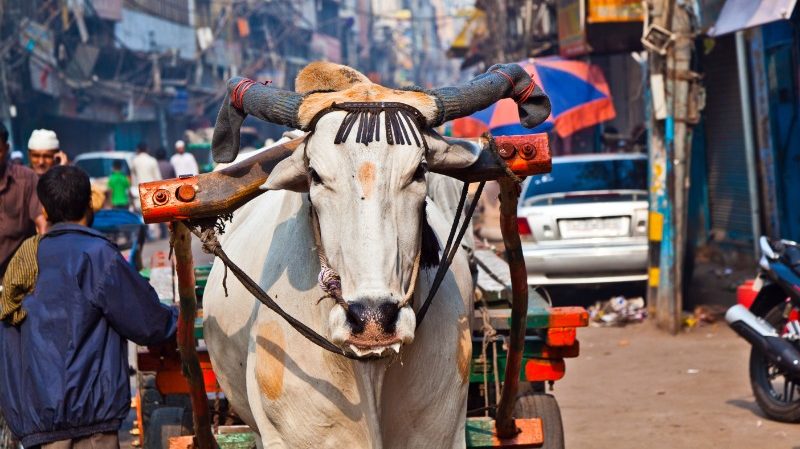
Image by Sundraw Photography
3. If possible, try to avoid peak travel times, as the metro gets very, very crowded. Locals say that peak travel time in the morning is anywhere from 9 am to 12 pm, and in the evening, it’s anytime from 6 pm to 8 pm. Of course, avoiding the metro during these times may not be possible, so if that’s the case, just be prepared to be squished – and keep an eye on your bag.
RELATED: HOW TO SOUND LIKE A LOCAL IN INDIA – YOUR GUIDE TO DELHI SLANG
4. Each train has about six to eight cars, one of which is reserved only for women. Although the metro system was opened in 2002, the women’s-only car only opened in 2010, as a response to sexual harassment complaints. Not surprisingly, though, as is often the case with gender-related initiatives, there is a bit of a debate in Delhi about the existence of the women’s-only car. Contrarians argue that it simply reinforces gender roles, whereas those in favour of the car say it’s a nice place to breathe and know that you will not be bothered by men. No matter where you stand on the debate, it’s good to know that there is one in the first place.
5. Your bag will be scanned before you board – and you can’t board at certain stations if your bag weighs more than 15 kilograms. Every metro station has an X-Ray scanning machine to check your bag before you board. And now, as of February 2018, you are not even allowed [italics] to board the Delhi Metro at more than 35 select stations if your bag weighs more than 15 kilograms. This rule has actually been in place since the metro opened, but it’s only now that the Delhi Metro Rail Corporation (DMRC) is actually enforcing it.
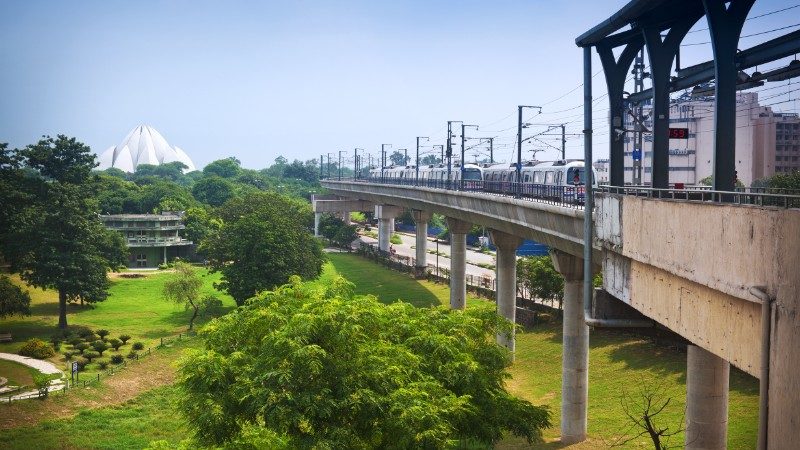
Image by O’SHI
6. You aren’t allowed to eat on the train. That said, many, though not all, Delhi Metro stations have kiosks where you can buy coffee, tea, and local snacks. Some of the stations even have entire food courts filled with popular local and international chains where you can buy full meals. (Hot tip: Go for local chains like Khan Chacha and Cafe Coffee Day, and pass on the international chains like Domino’s… because you can do better than that.)
EXPLORE ROMANTIC RAJASTHAN ON A 15-DAY SMALL GROUP ADVENTURE
Using the Delhi Metro to Get to Your Hotel from the Airport
When the Delhi Metro first opened, there wasn’t a line that went directly to the airport, but all of that changed when the Orange Line – i.e. the line to the airport – opened in February 2011. Both locals and travellers alike really love the addition, because it cuts the journey down from more than an hour to around 20 minutes (give or take). The Orange Line runs from Terminal 3 and the new AeroCity hospitality precinct to New Delhi Metro Station (which is opposite the New Delhi Railway Station). Trains run nearly every 10 minutes, from around 5 a.m. to 11:30 p.m. every day, and the trip costs 60 rupees.
And that’s not all. In May 2018, the DMRC opened a new magenta line that goes to the airport too. While it’s not an express train like the Orange Line, it still gives you even more airport-to-hotel options. The magenta line has 16 stations total – many of which interchange with other lines – and operates from Terminal 1.
RELATED: THE MAGIC OF MOVING OUT OF YOUR COMFORT ZONE IN INDIA
The Best Delhi Metro Stations for Sightseeing
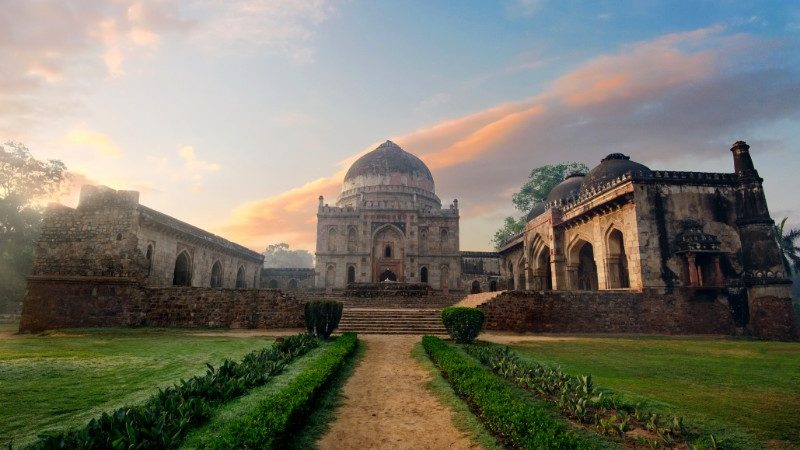
One of the coolest parts about taking the Delhi Metro is that the metro itself is a sight to be seen. That said, you can also use it to get to other awesome tourist attractions too. Here are five solid stations that will place you right in the middle of the attraction action:
1. Chandni Chowk, on the yellow line This brings you to Old Delhi, which is total chaos but a must-see. You can walk to the Red Fort from here too. There’s tons of street food around as well, so be sure to sample some – and don’t miss Karim’s .
2. Rajiv Chowk, on the yellow and blue lines When you get off at this station, you’ll be close to Connaught Place, the commercial business and financial hub of Delhi that has heaps of markets and stalls. This is where you go to get all of the Indian trinkets you want.
SUBSCRIBE TO INTREPID’S NEWSLETTER FOR TRAVEL TIPS, STORIES, OFFERS, GIVEAWAYS & MORE
3. Hauz Khas, on the yellow line Hauz Khas village is the hipster neighbourhood of Delhi. Expect to drink artisanal beer and quality coffee, visit artsy clothing and jewellery boutiques, and stroll through colourful, graffiti-covered alleyways.
4. Nehru Place, on the violet line It’s right by Lotus Temple, which is a house of worship constructed in the shape of a flower that’s one of the most popular attractions in Delhi.
5. Central Secretariat, on the yellow and violet lines Get off here to be close to the Indira Gandhi Memorial, Lodhi Garden, India Gate, the Parliament House, and more.
Now that you have all of the Delhi Metro information you need, go off and hop on that train. Your wallet – and your watch – will thank you.
Try out Delhi’s Metro on your next trip to India. Explore our range of small group adventures now .
Feeling inspired?
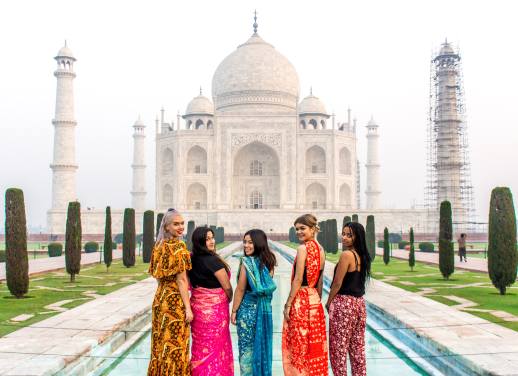
Annie Daly is a freelance journalist who lives in Brooklyn Heights, New York, with her fiance and 14 houseplants. She's written for BuzzFeed Travel, AFAR, Yahoo! Travel, SELF, Cosmo, and more. When she's not traveling, you can find her running around Brooklyn Bridge Park, cooking healthy meals, making new Spotify playlists, or just hanging out.
You might also like
Skip paris this summer and explore these 3..., all aboard the rail renaissance: 7 reasons to..., the undeniable benefits of slow travel, explore these 7 tea rituals from around the..., why travellers are choosing the galapagos off-season, over 20 years of the intrepid foundation: a..., tips and hacks for train travel in europe, why train travel is the one experience you..., everything you need to know about a night..., mind your manners: dining etiquette around the world, 5 places to escape the crowds in italy....

Want to save time & money on your next India trip?
Check out the list of travel hacks learned after +4 years in India
Delhi Metro Travel Guide: Everything You Need To Know
The Delhi Metro has been a boon in my journeys, from zipping to my hotel in Aerocity straight from the airport to quickly getting to Chandni Chowk without having to deal with traffic.
But the Metro can be overwhelming and confusing to figure out at first.
I’ve been traveling India for more than 4 years and aim to visit every state. But one place I often visit is Delhi, and the Metro has been so helpful.
Read on to learn everything you’ll need to know about Delhi’s Metro to have convenient and stress-free travels.
In this post, you’ll learn:
- Delhi Metro’s zones and lines
- Using the Airport Express Line
- How to buy tickets and Smartcards
- Must-visit Metro stations and nearby attractions
- Etiquette and safety tips
- Tips to avoid rush hour
- Using the Metro with other modes of Delhi transport
- Best food stops near Metro stations
- Best markets accessible by Metro
- Art & culture in Delhi Metro stations
- Lesser-known sights near Metro stations
- Nightlife Spots near the Metro Stations
Ready to embark on a metro ride through Delhi? Let’s dive in!
Planning a trip to India at some point? Check out my free ebook to help you save time and money, and avoid headaches. After +4 years in India, I’ve made plenty of mistakes, and this guide shares what I’ve learned so you can have a smoother trip.
Table of Contents
Understanding Delhi Metro’s Zones & Lines
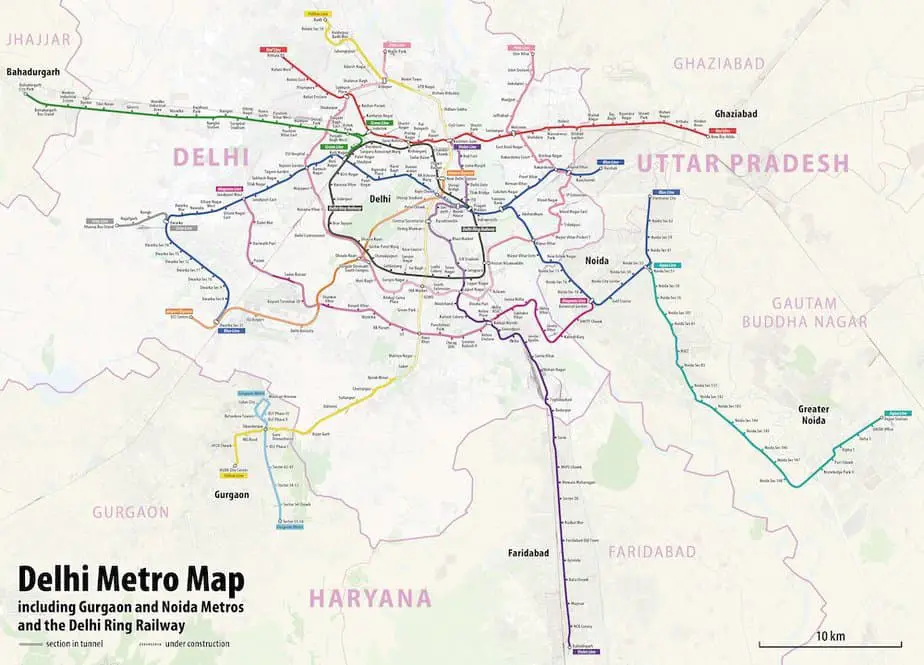
Oh, the beautiful spectrum of the Delhi Metro lines ! Each one with its own color and places to discover.
Zones and Lines
– Red Line: Takes you from Rithala to Shaheed Sthal. Along the way, don’t miss out on exploring Pitampura’s buzzing markets.
– Yellow Line: This one connects Samaypur Badli to HUDA City Centre, passing through the central areas, including the famous Chhatarpur Temple.
– Green Line: This connects Inderlok and Brigadier Hoshiyar Singh. Bonus: It’s a ride amidst some green patches!
– Violet Line: Kashmiri Gate to Ballabhgarh, it goes past the enchanting Humayun’s Tomb.
– Blue Line: Dwarka to Noida Electronic City/Vaishali. It’s the one I took for a delicious food tour in Chandni Chowk!
– Magenta Line: Janakpuri West to Botanical Garden. A must for a rendezvous with the architectural wonder that is the Lotus Temple.
– Pink Line: Majlis Park to Shiv Vihar. Zipped through this for a lazy Sunday at the Deer Park.
Pro Tip: If you’re looking to explore historical Delhi, the Yellow and Violet lines are your best friends!
This Metro Guide is just one part in my series about Getting Around India . Be sure to read about other transportation forms to best explore this beautiful country.
Navigating the Airport Express Line: A Beginner’s Dive
Ah, so you’ve just landed in Delhi, and you’re itching to start your journey in this vibrant city. But first things first: let’s get you from the airport to the city center efficiently. Enter the Airport Express Line, one of Delhi Metro’s gems.
1. Where to Find the Airport Express Line at the Airport:
As soon as you exit the baggage claim area, follow the signs for the metro. The Delhi Airport Metro Station is strategically located at Terminal 3. If you happen to land at Terminal 1 or 2, don’t fret. Regular shuttle services provided by Delhi Metro will ferry you to Terminal 3, where you can hop onto the Airport Express Line.
2. Destination Points:
The Airport Express Line directly links the Indira Gandhi International Airport and New Delhi City Center. It’ll whisk you away to the New Delhi Railway Station, passing through key stations like Aerocity, Dhaula Kuan, Delhi Aerodrome, and Shivaji Stadium. You can easily connect to other metro lines from the New Delhi Railway Station or hail a cab to your final destination.
3. Cost Comparison:
Now, let’s talk money. A one-way ticket on the Airport Express Line will cost around ₹60 to ₹120 , depending on the distance. In contrast, taking a taxi from the airport to the city center can set you back anywhere from ₹500 to ₹1,000, or even more, based on the time of day, traffic, and type of taxi.
Apart from being pocket-friendly, the Airport Express Line is also a time-saver, taking a mere 20 minutes to reach the heart of the city. In Delhi’s infamous traffic, a taxi could take you upwards of an hour (or two, on particularly congested days).
4. Can You Take Luggage On The Delhi Metro?
The Airport Express Line trains are designed with travelers in mind. They have dedicated luggage racks, so you can stash away your bags and travel comfortably. However, just like any other metro around the world, it can get crowded during peak hours, so plan accordingly.
Pro Tip: If you’re staying in Aerocity, get down at the Delhi Aerocity station. It’s a hub of swanky hotels and eateries.
There you have it! The Airport Express Line is not just a mode of transport but a rite of passage for any first-timer in Delhi. Embrace the journey, soak in the sights, and before you know it, you’ll be navigating the metro lines like a local.
Read more: Indian Airport Travel Tips
How To Buy Delhi Metro Cards & Tokens
Navigating the vast expanse of Delhi’s metro system can be a thrilling experience, especially for a first-timer. While the trains themselves are a marvel, understanding the ticketing system is crucial to ensure a smooth ride. Whether you’re in town for a few days or planning an extended stay, knowing your way around metro cards and tokens is the first step.
1. The Two Ticketing Options:
In essence, Delhi Metro offers two primary forms of ticketing: the token and the smart card. Tokens are best for one-off journeys, while the smart card is the frequent traveler’s best friend.
– How to Purchase: Walk up to the ticket counters or the Ticket Vending Machines (TVMs) located at every metro station. Select your destination, pay the required amount, and you’re handed a small round token.
– Using the Token: Place it on the entry gate sensor, wait for the green light, and voilà! You’re granted access. Once you reach your destination, drop the token in the slot at the exit gate.
Note: Tokens are only valid on the day of purchase, so ensure you use them timely.
3. Smart Cards:
– How to Purchase: These can be bought at the Customer Care Centers of any metro station. You’ll need to pay a refundable deposit of ₹50 along with the desired credit amount. You can also opt for Tourist Cards, which offer unlimited travel for either one day (₹200) or three days (₹500).
– Using the Card: Simply tap the card on the sensor at the entry gate. The appropriate fare will be automatically deducted when you tap out at your destination.
– Recharging: Run out of balance? No worries. You can recharge the card at any metro station’s Customer Care or through TVMs. They also offer an online recharge option, which is handy when you’re on the go.
Pro-tip: If you’re here for over a day or two, invest in a smart card. Smart Card holders enjoy a 10% discount on fares; during non-peak hours, the discount is a whopping 20%. If you’re going to be traveling frequently, this card is a no-brainer.
4. Fare Charts:
Wondering about the costs? Every metro station showcases a fare chart that lists prices to various destinations. If in doubt, ask the friendly staff at the ticket counter or refer to the Delhi Metro’s official website or mobile app.
Whether you’re using a token or a smart card, the essence is to enjoy the journey. As you zoom through tunnels and over bridges, watch Delhi unfurl in all its chaotic beauty. Embrace the convenience, the hustle, and the rhythm of this city’s lifeline.
Read more: What Can $100 Buy in India?
Must-Visit Metro Stations and Their Surrounding Attractions
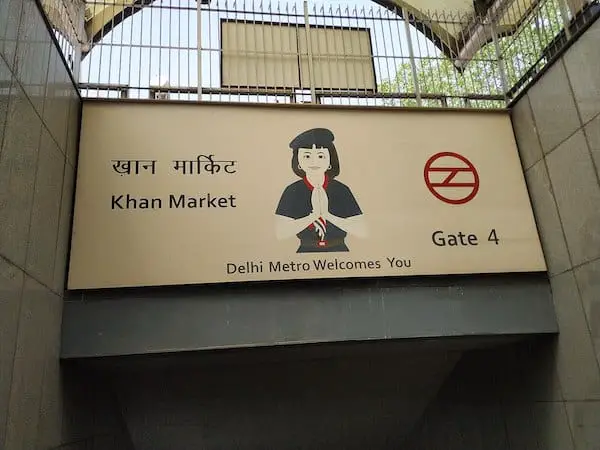
With its millennia-old history and an ever-evolving urban tapestry, Delhi has countless treasures, some of which are conveniently accessible via the metro. As part of your metro adventure, here are some stations that don’t just serve as transit points but open doors to a world of cultural and historical wonders.
1. Rajiv Chowk:
– Metro Line: Yellow and Blue Lines
– Attractions: Connaught Place (often abbreviated as CP) spreads out from Rajiv Chowk at the heart of Delhi. This British-era commercial and recreational vortex brims with shops, restaurants, theaters, and cultural spaces. The Central Park frequently hosts events and the underground Palika Bazaar are mere steps away. Stroll around to feel the pulse of modern Delhi interspersed with colonial charm.
2. Qutub Minar:
– Metro Line: Yellow Line
– Attractions: As the station’s name suggests, the UNESCO World Heritage site of Qutub Minar is nearby. The 73-meter tall tower, dating back to 1193, is an epitome of Indo-Islamic architecture. Explore the surrounding ruins and immerse yourself in a bygone era.
3. Chandni Chowk:
– Attractions: The bustling heart of Old Delhi, Chandni Chowk is a sensory overload. From the historic Red Fort to the Jama Masjid, from age-old bazaars to lip-smacking street food, this place is a journey back in time. Dive into the labyrinthine lanes to discover the essence of traditional Delhi.
4. Hauz Khas:
– Attractions: Combining the old with the new, Hauz Khas is famed for its village setting dotted with medieval history, and yet, it’s a hub of contemporary culture. Galleries, boutiques, cafes, and the serene Hauz Khas Lake make it a favorite for both locals and tourists.
– Metro Line: Yellow and Pink Lines
– Attractions: Home to Delhi Haat, an open-air food and crafts bazaar. It showcases the richness of Indian handicrafts, cuisines, and cultural performances. A haven for shopaholics and gourmets alike!
6. Akshardham:
– Metro Line: Blue Line
– Attractions: Close to the station lies the magnificent Akshardham Temple. Its intricate carvings, sprawling gardens, and mesmerizing water shows stand as a testament to India’s rich spiritual heritage.
Exploring Delhi through its metro is not just about the convenience; it’s about experiencing the diverse facets of this multifaceted city. Each station can be a starting point of a new story, a new adventure. So, swipe that card or drop that token and let the journey begin!
Read more: Best Time To Visit India’s Most Popular Destinations
Etiquette and Safety Tips For The Delhi Metro

The Delhi Metro, as expansive and efficient as it is, also demands a certain level of etiquette to ensure a comfortable journey for everyone. Whether you’re a seasoned traveler or just dipping your toes into Delhi’s urban sprawl, adhering to these guidelines will make your metro experience seamless and pleasant.
1. Boarding:
– Wait in Line: Stations often have demarcated lines. Always stand behind these while waiting. Let passengers alight before boarding to avoid unnecessary chaos.
– Mind the Gap: Watch your step as there might be a small gap between the train and the platform.
2. Reserved Spaces:
– Ladies’ Compartment: The Delhi Metro reserves a coach exclusively for women. It’s typically the first coach, and while it’s okay for women to travel in other general compartments, men should steer clear of the ladies’ section.
– Seats for Special Needs: Some seats are reserved for the elderly, differently-abled, and pregnant women. Even if they’re vacant, offering them to someone in need is courteous.
3. Personal Space:
– Keep the Volume Down: Remember to keep your volume in check whether you’re listening to music or on a call. The metro is a shared space; let’s keep it harmonious.
– No Littering: Always use trash bins provided at stations. A clean metro is a happy metro!
4. Safety Precautions:
– Hold On: The metro can get crowded, and sudden stops can happen. Always hold onto the railings, especially if you’re standing.
– Beware of Pickpockets: Like any public transport system worldwide, always be mindful of your belongings. Keep bags zipped and wallets in front pockets.
5. Metro Do’s and Don’ts:
– No Eating or Drinking: Refrain from consuming food or drinks within the metro premises.
– Follow Announcements: Always pay attention to in-train and platform announcements for any updates or vital information.
6. Interactions and Help:
– Ask, Don’t Assume: Delhiites are generally amiable. If you’re unsure about something, it’s okay to ask a fellow passenger or metro staff.
– Emergency Button: Each coach has an emergency button. Use it ONLY in genuine emergencies, and metro staff will assist promptly.
Traveling via the Delhi Metro is more than just a commute; it’s an insight into the daily life of the city’s inhabitants. While the trains bridge distances, adhering to these etiquettes bridges cultural gaps, ensuring that everyone enjoys the journey as much as the destination.
Read more: Travel Hacks for India: Learned After 4 Years
Tips to Avoid the Delhi Metro Rush
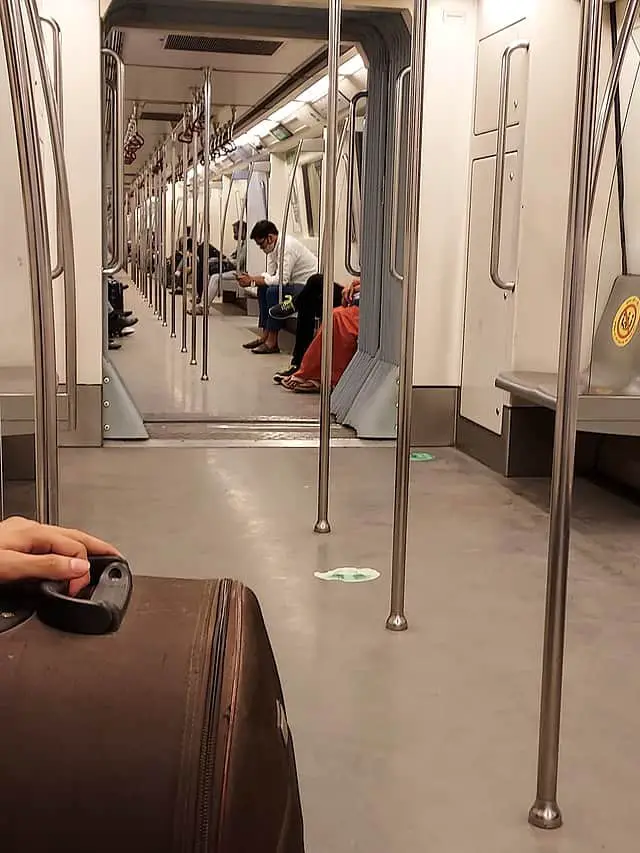
Peak hours in the Delhi Metro can often resemble scenes from adventure movies – bustling platforms, packed coaches, and the race to grab a spot. While the metro system is a marvel of efficiency, the sheer volume of passengers during rush hours can be overwhelming, especially for first-timers. Here’s how to navigate these busy times and make your commute smoother.
1. Understanding the Peak Hours:
– Morning Rush: Typically, 8:30 AM to 10:30 AM on weekdays.
– Evening Flurry: 5:30 PM to 8:30 PM is when most are heading back home or out to unwind.
– Weekends: While slightly less intense than weekday peaks, Sundays can still be busy, especially in tourist-heavy areas.
2. Opt for Off-Peak Travel:
If your schedule is flexible, plan your metro rides outside these peak times. Not only will you enjoy a less crowded journey, but you also get a 20% discount on your smart card during off-peak hours.
3. Know Your Exit:
Before boarding the train, knowing which door will be closest to your exit or transfer line is a good idea. The Delhi Metro app or signage at stations can guide you. Positioning yourself correctly can save you precious minutes and avoid the rush.
4. Be Ready for Boarding:
Have your token or smart card handy before you reach the entry gates. Fumbling in front of the gate can slow down the flow.
5. Travel Light:
If possible, avoid carrying bulky luggage during peak hours. It’s more comfortable for you and courteous to fellow passengers.
6. Stay Alert for Quick Stops:
Trains can halt suddenly. Always hold onto a railing or handle, especially if you’re not seated.
7. Avoid Last-Minute Exits:
If you realize your stop is next, start making your way toward the door a minute or two in advance. Trying to exit from the middle of a crowded coach at the last second can be a challenge.
8. Mind the Platform Screen Doors:
Some metro stations have platform screen doors for added safety. Always stand clear of these and wait for them to slide open before boarding.
9. Opt for Alternate Routes:
If one line is exceptionally crowded, check if another line or a quick interchange can get you to your destination. Sometimes, a slightly longer route can offer a much more relaxed journey.
Despite its rush hours, the Delhi Metro is still one of the most efficient ways to traverse the sprawling city. With a bit of planning, patience, and these tips, you’ll find yourself mastering the metro hustle like a seasoned Delhite in no time.
Using The Metro with Other Modes of Delhi Transport
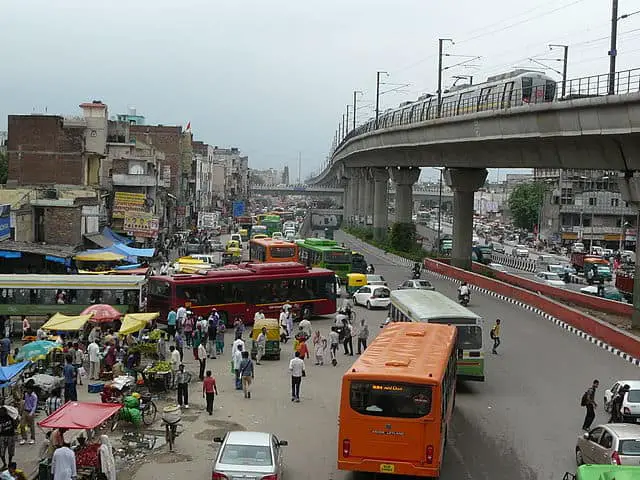
The Delhi Metro, impressive as it is, forms just one part of the city’s vast transportation network. To truly maximize your mobility and experience all that Delhi has to offer, you’ll often find yourself transitioning between the metro and other modes of transport. Here’s how you can effortlessly combine them for a fluid travel experience:
1. Metro to Auto-rickshaw:
– The Three-Wheeled Wonder: Auto-rickshaws, often simply called “autos”, are ubiquitous in Delhi. These green and yellow chariots are perfect for short distances and to reach places that are not directly accessible by metro.
– Tips: Ensure the driver turns on the meter, or agree on a fare before starting the journey. Metro stations usually have a designated auto stand nearby.
Read more: Avoid getting ripped off in a rickshaw with my script for negotiating a fair rate.
2. Cycle Rickshaws & E-Rickshaws:
– Eco-friendly and Easy: Especially prevalent in older parts of Delhi like Chandni Chowk, cycle rickshaws are human-pulled carts, while e-rickshaws are their electric counterparts.
– Tips: They’re best for very short distances. Discuss and decide on the fare upfront.
3. Metro-Feeder Buses:
– Bridge the Gap: Delhi Metro operates feeder bus services at many stations to connect areas not directly touched by the metro.
– Tips: These buses are frequent, and fares are nominal. Keep some change handy, and ask the conductor for assistance if in doubt.
4. Ola & Uber – App-based Cabs:
– Convenient and Comfortable: App-based cab services like Ola and Uber are widely used for a more personalized travel option.
– Tips: Most metro stations have strong mobile network connectivity, so you can book right as you exit. Ensure the pick-up point is clear to avoid confusion.
5. Delhi Transport Corporation (DTC) Buses:
– Widespread Network: DTC buses connect every nook and cranny of Delhi, offering a more in-depth exploration of the city.
– Tips: Buses can be crowded during peak hours. Google Maps can help identify bus routes and numbers. Keep an eye out for AC buses for a more comfortable ride.
6. Renting Bicycles and Scooters:
– Discover at Your Pace: Many areas offer bicycle and scooter rentals, especially around tourist spots. An eco-friendly and healthy way to see the sights!
– Tips: Always wear a helmet if renting a scooter. Familiarize yourself with local traffic rules and be cautious, as Delhi traffic can be unpredictable.
Interlacing the Delhi Metro with these myriad transport options allows you to truly immerse yourself in the city’s rhythm. From the swift efficiency of the metro to the leisurely pace of a cycle rickshaw, each mode offers a unique perspective of Delhi’s multifaceted charm.
Best Food Stops Near Metro Stations
One can’t explore Delhi without savoring its rich culinary heritage. Fortunately, the Delhi Metro offers easy access to some of the city’s most tantalizing treats. The metro has got you covered whether you’re seeking street-food sensations or sophisticated sit-downs. Here’s a guide to the most mouth-watering metro stops.
1. Chandni Chowk (Yellow Line):
– Feast for the Senses: Dive into the world of parathas at ‘Paranthe Wali Gali’, indulge in the legendary ‘Karim’s’ kebabs, or sweeten the deal at ‘Ghantewala Halwai’.
– Tip: Don’t miss the refreshing lassi (yogurt drink) available at various corners.
2. Rajouri Garden (Blue Line):
– Modern Meets Traditional: Here, shopping malls and street vendors live side by side. Explore ‘The California Boulevard’ for international cuisine or local stalls for spicy aloo tikki.
– Tip: Evening walks offer a plethora of snack options.
3. Nehru Place (Violet Line):
– South Indian Delight: While it’s a hub for electronics, Nehru Place hides ‘Saravana Bhavan’ and ‘Sagar Ratna’, two of the best places to get dosas, vadas, and other South Indian dishes.
– Tip: Finish your meal with a filter coffee.
4. INA (Yellow & Pink Lines):
– Dilli Haat’s Diverse Dishes: Beyond handicrafts, Dilli Haat is a melting pot of cuisines from across India. From momos from the North-East to Rajasthan’s dal baati, it’s a culinary carnival.
– Tip: The rotating state stalls provide ever-changing food options, so there’s always something new.
5. Huda City Centre (Yellow Line):
– Gurgaon’s Gourmet Gateway: The metro’s terminus leads to Gurgaon, known for upscale restaurants and cafes. Explore ‘Cyber Hub’ for everything from sushi to biryanis.
– Tip: Many places here offer craft beers, perfect for unwinding after a day of exploration.
6. Kashmere Gate (Red, Yellow, Violet Lines):
– Mughlai Magic: Close to historical sites, the area boasts age-old eateries serving delectable Mughlai cuisine. Seek out ‘Al Jawahar’ or ‘Kuremal Mohan Lal Kulfi Wale’ for a cooling dessert treat.
– Tip: The kebabs here are a must-try, especially during the evening.
Delhi’s food scene is as diverse and dynamic as its history. With each metro stop, you unveil a chapter of the city’s edible story. It’s a fusion of flavors from across the country and even the world. So, while the Delhi Metro may be your ride, let your tastebuds lead the way.
Read more: Must-Try Street Food Dishes in India
Best Markets Accessible by Metro

Delhi is a city of history, modernity, and a colorful blend of cultures, offering shopping experiences as varied as its landscape. And the Delhi Metro? It’s your chariot to these bazaars, where you can snag that perfect keepsake. Let’s unravel the shopping secrets close to metro stations, from artisanal crafts to fashionable boutiques.
1. Karol Bagh (Blue Line):
– Diverse Delights: An eclectic mix awaits – jewelry, electronics, apparel, and more. For a classic Delhi souvenir, grab some silver trinkets or embroidered fabrics.
– Tip: Ajmal Khan Road is pedestrianized, so take a leisurely stroll without worrying about traffic.
2. Rajiv Chowk (Blue & Yellow Lines):
– Connaught Place Calling: A historical landmark, its white colonnades host boutiques, bookstores, and branded outlets. Pick up handicrafts from the ‘Central Cottage Industries Emporium’.
– Tip: Dive into the underground ‘Palika Bazaar’ for electronics and affordable souvenirs.
3. Janpath (Violet Line):
– Street Shopping Star: An alley filled with colorful stalls selling jewelry, handicrafts, clothing, and more. A perfect spot for boho-chic souvenirs.
– Tip: Bargaining is an art here. Start at about half the asking price and negotiate from there.
4. Lajpat Nagar (Violet Line):
– Ethnic Enigma: ‘Central Market’ is a haven for traditional wear, textiles, and accessories. Henna artists are also aplenty, offering intricate designs.
– Tip: Try the street food here, especially the ‘paneer tikka’ and ‘golgappas’.
5. Chawri Bazaar (Yellow Line):
– Paper Paradise: Originally a hardware market, it’s now known for wedding invitations and unique paper products. An ideal stop for stationery enthusiasts.
– Tip: Explore the narrow lanes, where you’ll find quaint, age-old shops selling curiosities.
6. Kalkaji Mandir (Violet & Magenta Lines):
– Nehru Place Fabrics: Adjacent to the metro, Nehru Place isn’t just for tech. It’s a treasure trove for textiles, perfect for custom-tailored outfits.
– Tip: Visit early in the day for the best selections and less crowd.
7. Saket (Yellow Line):
– Modern Malls & More: Adjacent to the metro station are malls like ‘Select CITYWALK’, offering high-end brands, boutiques, and crafts from across India.
– Tip: Check out ‘Dilli Haat’ in Saket for handcrafted souvenirs from various states.
Shopping in Delhi is as much about the experience as the purchase. Each market, each stall, tells a story. And with the metro, these narratives are just a ride away. So, pack light and shop heartily!
Read more: Best Souvenirs from India
Art & Culture in Delhi Metro Stations

The Delhi Metro is not just a mode of transport; it’s an ever-evolving canvas celebrating India’s rich tapestry of art, history, and culture. Various stations are adorned with murals, installations, and exhibits that reflect the city’s artistic soul. Here’s your cultural map to the most enchanting metro stops:
1. Jor Bagh (Yellow Line):
– The Heritage Corridor: This station is adorned with artwork showcasing India’s prehistoric era. From ancient cave paintings to tribal art, it’s a visual treat.
– Tip: Pause at the detailed murals, each carrying a snippet of history.
2. Mandi House (Blue & Violet Lines):
– Theatre and Tunes: Celebrating Delhi’s vibrant performing arts scene, this station is decked with motifs from classical dances, instruments, and renowned theatre personalities.
– Tip: Nearby is the actual ‘Mandi House’, a hub for art and culture events. Check out local listings for performances.
3. INA (Yellow & Pink Lines):
– Crafts of India: The station is a visual representation of ‘Dilli Haat’ above ground, showcasing the diverse craft traditions of India, from Kashmir to Kanyakumari.
– Tip: After enjoying the artwork, visit the actual ‘Dilli Haat’ for live performances and workshops.
4. Qutub Minar (Yellow Line):
– Architectural Wonders: As the name suggests, the station offers glimpses of the iconic Qutub Minar and other historical monuments, encapsulating Delhi’s Mughal-era magnificence.
– Tip: The real Qutub Minar is just a short auto ride away – a must-visit!
5. Race Course (Yellow Line):
– India’s Freedom Struggle: The walls here are adorned with poignant moments and key figures from India’s journey to independence.
– Tip: A brief walk leads you to the ‘Indira Gandhi Memorial Museum’, furthering the historical journey.
6. Patel Chowk (Yellow Line):
– Metro Museum: Yes, there’s a museum dedicated to the Delhi Metro itself! It chronicles its journey from conception to realization.
– Tip: The interactive displays make this a fun visit for both kids and adults.
7. Kashmiri Gate (Red, Yellow, Violet Lines):
– Confluence of Cultures: Highlighting the essence of the Old Delhi spirit, murals and exhibits here offer glimpses of the city’s diverse communities and their traditions.
– Tip: Explore nearby areas like ‘Chandni Chowk’ and ‘Red Fort’ for a deep dive into Old Delhi’s charm.
The Delhi Metro is not just about reaching destinations; it’s about the journey, where every station offers a chapter from Delhi’s vast cultural book. So, next time you’re aboard, take a moment to appreciate these art-laden stops, making your commute a cultural excursion.
Lesser-Known Sights Near Metro Stations

Delhi, the grand old city of legends, is brimming with tales waiting to be told. While the iconic landmarks like India Gate and Red Fort are frequented by many, the city hides pockets of serenity and stories often overlooked. Thanks to the Delhi Metro, these lesser-known spots are accessible to those eager to veer off the beaten path. Let’s uncover these secrets!
1. Khan Market (Violet Line):
– Sunder Nursery: A short walk or cycle rickshaw ride from the bustling Khan Market leads to this oasis. Rejuvenated recently, it’s a heritage park with Mughal-era monuments, serene lakes, and lush gardens.
– Tip: Perfect for picnics, early morning jogs, or birdwatching.
2. Green Park (Yellow Line):
– Hauz Khas Village Ruins: While the Hauz Khas Village is known for its hip cafes and boutiques, the adjoining medieval ruins and reservoir offer a picturesque walk.
– Tip: Stay till sunset. The reservoir view is mesmerizing!
3. JLN Stadium (Violet Line):
– Sanskriti Museums: A set of three museums dedicated to Indian textiles, terracotta, and everyday crafts. It’s a quiet enclave offering a deep dive into India’s artisanal heritage.
– Tip: They also offer workshops. Check their schedule!
4. Govind Puri (Violet Line):
– Tughlaqabad Fort: An impressive 14th-century fortification representing the might and ambitions of its founder, Ghiyas-ud-din Tughlaq. While in ruins, its vastness evokes awe.
– Tip: Wear comfy shoes. There’s a lot of ground to cover.
5. Udyog Bhawan (Yellow Line):
– National Gallery of Modern Art: Though not exactly hidden, the nearby India Gate often overshadows it. This gallery houses masterpieces by renowned Indian artists.
– Tip: Their curated walks offer rich insights into the exhibits.
6. Pragati Maidan (Blue Line):
– Purana Qila (Old Fort): With its massive ramparts, boat rides, and a sound & light show, this often-overlooked fort is steeped in history.
– Tip: The Delhi Zoo is adjacent, so you can club the visits.
7. Mayur Vihar Phase-1 (Blue Line):
– Sanjay Van: A sprawling city forest, it offers walking trails amidst dense foliage, dotted with lakes and Mughal-era relics.
– Tip: Carry binoculars. It’s a haven for birdwatchers!
Delhi’s layers of history, culture, and nature are wrapped in a myriad of colors and sounds. While the famous sights command attention, these lesser-known treasures provide a soulful respite. So, let the Delhi Metro be your compass to these hidden wonders, and let every journey be a tale of discovery.
Read more: Offbeat Indian Destinations To Chill
Nightlife Spots Near Metro Stations
The sun might set on Delhi, but the city’s spirit shines even brighter at night. From tranquil lounges to buzzing nightclubs, Delhi’s nightlife has something for everyone. And guess what? The Delhi Metro’s central lines place many of these hotspots within easy reach. So, if you’re planning a night to remember, here’s where the metro can take you:
1. Rajiv Chowk (Blue & Yellow Lines):
– Connaught Place (CP): The heart of Delhi, CP’s Georgian architecture transforms under the night sky. There’s no dearth of choices, from quiet coffee shops to pulsating pubs.
– Tip: ‘Vault Cafe’ offers private vaults for groups, while ‘The Beer Cafe’ boasts an extensive brew menu.
2. Hauz Khas (Yellow Line):
– Hauz Khas Village: A unique blend of modern bars overlooking ancient ruins, this place has a bohemian vibe. The rooftop establishments provide enchanting views of the historic Hauz Khas complex.
– Tip: ‘Social’ offers a fusion of work and play, perfect for both early evenings and late nights.
– Epicuria Food Mall: More than just a food hub, it’s a vibrant nightlife venue with an array of bars, lounges, and restaurants.
– Tip: ‘Lord of the Drinks’ is renowned for its cocktails, while ‘Flyp@MTV’ often hosts live performances.
4. Akshardham (Blue Line):
– Gardens of Five Senses: Not your conventional nightlife spot, but it’s beautifully lit up in the evenings, offering a tranquil atmosphere amidst themed gardens.
– Tip: The adjacent ‘Fio Country Kitchen and Bar’ is ideal for a romantic dinner.
5. Malviya Nagar (Yellow Line):
– Select CITYWALK Mall, Saket: A short auto ride away, this mall transforms into a nightlife hub with bars, multi-cuisine restaurants, and occasional live shows.
– Tip: ‘The Piano Man Jazz Club’ is a haven for jazz lovers.
6. Sikanderpur (Yellow Line):
– Cyber Hub, Gurugram: A few metro stops away, Cyber Hub is the pulse of Gurugram’s nightlife. It boasts an extensive range of global cuisines, breweries, and bars.
– Tip: ‘Sutra Gastropub’ is known for its vibrant ambiance and DJ nights.
7. Kashmere Gate (Red, Yellow, Violet Lines):
– Majnu Ka Tilla: This Tibetan settlement offers cozy cafes with a distinct Tibetan-Buddhist vibe. Perfect for a serene evening.
– Tip: Try Tibetan delicacies like momos and thukpa at the various eateries.
Delhi unveils a different shade of its multifaceted personality as the evening shades fall. So, if you’re looking to dance the night away, share a quiet meal, or simply soak in the city’s nocturnal vibes, the Delhi Metro is your trusted ally.
Read more: Why is Alcohol Taboo in India?
Wrapping Up Your Delhi Metro Adventures: A First-Timer’s Handbook
For every traveller setting foot in the heart of India, the Delhi Metro emerges as a lifeline, effortlessly weaving through the city’s historic relics and contemporary marvels.
To kickstart your journey, remember the swiftness of the Airport Express Line , bridging the gap between the international skies and the bustling city, not just economically but efficiently. And as you navigate deeper into Delhi’s rhythm, the ease of metro cards and tokens comes to the rescue, offering smooth, hassle-free commutes and the chance to embrace Delhi’s vibrant mosaic of art, culture, and hidden gems.
Equally fascinating is the metro’s dual role as both a connector and a curator. Beyond its prime function as a transportation medium, it’s a silent storyteller, with stations like Jor Bagh and Mandi House narrating tales of India’s rich heritage.
Whether you’re hunting for lesser-known treasures near Khan Market or dancing the night away in Connaught Place , the metro puts the city’s vast expanse within arm’s reach, making every journey an exploration and every stop, a story.
In conclusion, our Delhi Metro Travel Guide is more than just a navigation manual; it’s your passport to experiencing Delhi in its true essence. As a first-timer, let the metro’s tracks guide you, for they lead not just to destinations but to the soul of a city waiting to be discovered. So, bookmark this guide, step aboard, and let the adventures begin – with every metro ride, Delhi unfurls a little more, beckoning with its myriad hues and tales. Safe travels!
Benjamin Jenks
Traveler, Filmmaker, and Lover of India. I've been living, writing and sharing what I've learned about traveling in India since 2018. Learn more about me here or Youtube .
Recent Posts
Things To Do in Aizawl, Mizoram
Aizawl is a lesser-known hill station in India because it's over 1600 km (1000 miles) by air from Delhi and much more by bumpy roads. However, if you like off-the-beaten-path destinations and...
Agartala: Things To Do, Eat, & Places To Stay
No one goes to Agartala and Tripura, so if you go, you will be in special company. I stayed in a homestay outside the city, and the people’s jaws dropped as I walked by. Surprisingly, I had...

- Search Metro Routes
- Metro Station Near Me
- Delhi Metro
- Rapid Metro
- Jaipur Metro
- Mumbai Metro
- Namma Metro
- Hyderabad Metro
- Chennai Metro
- Kochi Metro
- Kolkata Metro
- Lucknow Metro
- Noida Metro
- Nagpur Metro
- Ahmedabad Metro
- Kanpur Metro
- Navi Mumbai Metro
- Mumbai Monorail
- India Travel Guide
- Places to visit in Agra
- Places to visit in Ahmedabad
- Places to visit in Bangalore
- Places to visit in Bhopal
- Places to visit in Chennai
- Places to visit in Coimbatore
- Places to visit in Delhi
- Places to visit in Gurgaon
- Places to visit in Guwahati
- Places to visit in Hyderabad
- Places to visit in Indore
- Places to visit in Jaipur
- Places to visit in Kanpur
- Places to visit in Kochi
- Places to visit in Kolkata
- Places to visit in Kozhikode
- Places to visit in Lucknow
- Places to visit in Meerut
- Places to visit in Mumbai
- Places to visit in Nagpur
- Places to visit in Navi Mumbai
- Places to visit in Noida
- Places to visit in Patna
- Places to visit in Pune
- Places to visit in Varanasi
- Places to visit in Vijayawada
- Places to visit in Visakhapatnam
- Metro in India
- Delhi Metro Map
- Delhi Metro Guide
- Delhi Metro News
- Privacy Policy
Search Route
Delhi Metro Route
The Delhi Metro is a fast transport system serving the cities of Delhi and NCR in India which includes the cities of Ghaziabad, Faridabad, Gurgaon, Noida, Bahadurgarh and Ballabhgarh. Presently there are 231 active stations in Delhi Metro network. Find important and useful information like Delhi Metro route, metro lines, service operation timings, first train, last train, route map, fare chart, top attractions near metro station, metro station nearby, news and more.
Delhi Metro Lines & Terminal Stations 2024
Delhi metro route map 2024.
Official Website 🔗 | Official Map 🔗
Delhi Metro Fare Chart 2024
- 10% discount continues on every journey made by the passengers using Smart Card.
- An additional 10% discount will also be given to the passengers using smart card who exit from Metro system during off peak hours, i.e.
- Start of revenue services to 08:00 AM.
- From 12 Noon to 05:00 PM.
- From 09:00 PM to closing of revenue services.
- The discount is applicable from Monday to Saturday only except National Holidays.
- Tourist Card for 1 day and 3 days validay will be available for Rs.200/- and Rs. 500/- respectively. This includes refundable security deposit of Rs. 50/-.
- Install DMRC Travel APP (Visit the official app store for your device, such as the Apple App Store for iOS or the Google Play Store for Android. Search for "DMRC Travel App" or Click on https://qrticket.dmrc.org/qrapp)
- Login using your valid credentials
- Proceed to Book Tickets (QR ticket)
- Select Source and Destination
- Select number of passengers
- Proceed for payment
- Get the QR-code/ticket
- Present the same QR code on the gate scanner to make entry & exit
- Validity of QR based ticket: Can be purchased only after the last purchased tickets have been exited with or have expired after end of business day.
- Passenger should raise ticket in support section of DMRC Travel App or
- Passenger should raise complain with Name, Email, Order ID & Transaction Id on [email protected]
- In case Amount has been paid and QR Ticket is not generated passenger should raise complain and amount will be refunded in 3 to 7 Business days.
- In case of not travelling due to technical issue, passenger should raise complain within 1 hour of buying the ticket.
- Delhi Metro QR Code-based Tickets Now Available On IRCTC App and you can now easily get QR code-based tickets for DMRC rides too. Just use IRCTC’s Electronic Reservation Slip (ERS) and pay a small fee of Rs 5.
Interesting Facts about Delhi Metro
- Delhi metro managed by and owned by Delhi Metro Rail Corporation a joint venture between Govt. of NCT and Govt of India.
- Its first operation started in 2002 from Welcome station to Tis Hajari Station on red line.
- Delhi metro is busiest and largest metro system in India with most number of stations.
- Delhi metro serving its transit system not only to Delhi city but also NCR cities including Gurgaon, Noida, Faridabad, Ghaziabad and Bahadurgarh.
- Currently Delhi metro has 10 active metro lines and contains almost 350 km of tracks.
- Delhi metro has various platform system including underground, elevated and ground level.
- Delhi metro consists of radial lines, circular line and semi-circular line.
- Delhi metro trains runs at upto 80km/h and stops at each stations for 20 sections normally.
- Delhi metro trains have various numbers of coaches like 4, 6 or 8 coaches, have a frequency of 1-4 minutes during peak hours and 5-10 minutes during non-peak hours.
- Hauz Khas metro station (Pink Line), 29 metres below the ground, is the deepest station while the crossing of Pink and Orange Lines in Dhaula Kuan metro station is the highest point on the system, 23.6 km above the ground.
- Elattuvalapil Sreedharan (an Indian civil engineer and a retired IRSE officer), first Managing Director of Delhi Metro, is popularly called the Metro Man.
About Delhi Metro
- The concept of mass rapid transit for New Delhi first emerged from a traffic and travel characteristics study that was carried out in the city in 1969.
- In 1984, the Urban Arts Commission came up with a proposal for developing a multi-modal transport system, which would consist of constructing three underground mass rapid transit corridors.
- Government of Delhi jointly set up a company called the Delhi Metro Rail Corporation (DMRC) on 3 May 1995.
- Physical construction work on the Delhi Metro started on 1 October 1998.
- The DMRC then hired the Hong Kong MTRC as a technical consultant on rapid transit operation and construction techniques.
- The Delhi Metro Construction proceeded smoothly, except for one major disagreement in 2000.
- The first line of the Delhi Metro, the Red Line, was inaugurated by Atal Bihari Vajpayee, the then Prime Minister of India on 24 December 2002.
- Delhi Metro stations began to open progressively from 25 December 2002 to 11 November 2006 in Phase I on Red Line, Yellow Line and Blue Line.
- In Phase II, Delhi metro stations progressively became operational from 4 June 2008 to 27 August 2011. In this time period Delhi, Haryana, and Uttar Pradesh states are easily connected.
- Delhi Metro in Phase III construction work started in 2011 with 2016 being the planned deadline. But work for the original was completed in March 2019 and fully completed in on 18 September 2021 with the opening of the Grey Line.
- The construction work of Delhi Metro Phase IV started in March 2019 with 3 priority corridors, after the completion of Phase IV, the length of Delhi Metro will be more than 450 km.
- Delhi Metro was planned to be built in phases spread over approximately 20 years with each phase having a target of five years to be completed and the end of one phase marking the beginning of another.
Delhi Metro News & Updates 2024
More Delhi Metro news and updates ..
Delhi Metro FAQs
𝒬 . What items are not allowed in Delhi metro?
The list of prohibited items in Delhi metro:
- Sharp Objects: Knife, Sword, Meat cleavers, etc.
- Explosive Materials: Gunpowder, Fireworks, Hand grenades, Plastic explosives etc.
- Flammabels items: Paints, Petroleum, Aerosol, Wet batteries, etc.
- Offensive items: Blood, carcasses of dead Animals, Unsealed row meat/fist, plants/sampling, skeletons, bones, rags, etc.
- Pets: pets includes birds and others.
This list is time to time updated by Delhi metro.
𝒬 . How much luggage is allowed in Delhi metro?
In Airport Express Line:- Two bags containing personal belongings not exceeding 90 cm x 75 cm x 45 cm in size and 32 Kg in gross weight is permitted. Baggage in the form of bundles is not permitted.
𝒬 . Can I carry alcohol/tobacco/cigarettes in Delhi metro?
- Alcohol: Two sealed bottles of alcohol are allowed on Delhi Metro trains.
- Cigarettes/Tobacco: One packet of cigarettes and one lighter/matchbox per passenger is allowed.
Traveling with alcohol, tobacco and cigarettes is allowed in Delhi Metro, but consumption of all these is prohibited in Delhi Metro.
𝒬 . Can I eat or drink inside Delhi metro?
𝒜 . Delhi Metro coaches often carry announcements reminding passengers that eating and drinking is prohibited in the Delhi Metro. This is a rule announced by Delhi Metro.
𝒬 . Why food is not allowed in Delhi metro?
𝒜 . Eating is not allowed in the Delhi Metro as an effort to keep the stations and trains clean. “Officials at stations and trains will keep an eye on passengers; They can carry food, but will not be allowed to eat it.
𝒬 . Is free drinking water is available at Delhi metro stations?
𝒜 . Drinking water facility is available @ Rs.2 per glass through kiosks at almost all metro stations of Delhi Metro and where the said facility is not available, passengers can ask for drinking water from the staff members available at such metro station.
𝒬 . Is photography permitted in Delhi metro?
𝒜 . No. In Delhi metro photography is not permitted.
𝒬 . Are there ladies coaches in Delhi metro? If yes, who besides women can use them?
𝒜 . Yes, DMRC has introduced one separate ladies coach in each train to ensure safe rides for women. Male Children up to the age of 12 years are only allowed to travel in ladies coach if accompanied by a women passenger.
𝒬 . What are criteria for ticket charges of a child in Delhi metro?
𝒜 . Children upto 3 feet (90 cms) height are allowed to travel free if accompanied with adult. The child is to be carried in arms (above the gate flap level) to avoid possibility of flaps hitting the child while Entry/Exit at AFC gates. Children above 3 feet (90 cms) will be charged full fare.
𝒬 . Can I carry bicycle in Delhi Metro?
𝒜 . Bicycles are allowed on Delhi Metro, but only on the first and last coaches of the train. Please note that folding bicycles are allowed in all coaches. Delhi Metro has a robust security system in place, including CCTV surveillance, security personnel, and baggage scanners at the entry points.
Other Metro Rail Services in India
Top attractions of delhi city.
- Subscribe to our RSS Feed
- Follow us on Twitter
- Join our Facebook Group
- Quick Snapshot
- Information & Map
- Construction Updates
- Yellow Line (Line-2)
- Aqua Line (Line-3)
- Red Line (Line-7)
- Jaipur Metro Neo
- Nashik Metro Neo
- Warangal Metro Neo
- RRTS Overview
- Delhi – Meerut Line
- Delhi – Alwar Line
- Delhi – Panipat Line
- Ghaziabad – Jewar Line
- Hyderabad Airport Express Line
- Construction Update
- Mumbai – Ahmedabad HSR
- Delhi – Varanasi HSR
- Delhi – Ahmedabad HSR
- Delhi – Amritsar HSR
- Mumbai – Nagpur HSR
- Mumbai – Hyderabad HSR
- Chennai – Mysore HSR
- Varanasi – Howrah HSR
- Contract News
- Agra – Gwalior Expressway
- Amritsar – Bathinda Expressway
- Delhi – Amritsar – Katra Expressway
- Delhi – Dehradun Expressway
- Delhi – Jaipur Super Expressway
- Delhi – Meerut Expressway
- Delhi – Mumbai Expressway
- Delhi UER 2 Expressway
- Dwarka Expressway
- Ludhiana – Bathinda Expressway
- Ludhiana – Rupnagar Expressway
- Sirhind – Sehna Expressway
- Sohna Elevated Road
- Trans-Haryana Expressway
- Ballia Link Expressway
- Bareilly – Gorakhpur Expressway
- Bundelkhand Expressway
- Ganga Expressway
- Gorakhpur Link Expressway
- Kanpur – Lucknow Expressway
- Kanpur Outer Ring Road
- Purvanchal Expressway
- Bangalore – Chennai Expressway
- Bangalore Peripheral Ring Road
- Bangalore Satellite Town Ring Road
- Bangalore – Mysore Expressway
- Bangalore – Pune Expressway
- Bangalore – Vijayawada Expressway
- Chennai Peripheral Ring Road
- Chennai Port – Maduravoyal Expressway
- Chennai – Salem Expressway
- Chennai – Surat Expressway
- Chittoor – Thatchur Expressway
- Coimbatore – Karur Expressway
- Hyderabad Regional Ring Road
- Khammam – Devarapalli Expressway
- Thiruvananthapuram Outer Ring Road
- Amas – Darbhanga Expressway
- Buxar – Bhagalpur Expressway
- Durg – Arang Expressway
- Gorakhpur – Siliguri Expressway
- Odisha Capital Region Ring Road
- Patna – Kolkata Expressway
- Raxaul – Haldia Expressway
- Varanasi – Kolkata Expressway
- Ahmedabad – Dholera Expressway
- Ahmedabad – Tharad Expressway
- Chambal Expressway
- Mumbai – Delhi Expressway
- Narmada Expressway
- Pune – Bangalore Expressway
- Surat – Chennai Expressway
- Zuari Bridge
- Airoli – Katai Naka Freeway
- Jalna – Nanded Expressway
- Konkan Expressway
- Mumbai Coastal Road Project
- Mumbai Trans Harbour Link
- Mumbai – Nagpur Expressway
- Mumbai – Pune Exp’s Missing Link
- Nagpur – Goa Expressway
- Nagpur – Chandrapur Expressway
- Nagpur – Gadchiroli Expressway
- Nagpur – Gondia Expressway
- Pune – Aurangabad Expressway
- Pune – Nashik Expressway
- Pune Inner Ring Road
- Pune Ring Road
- Sewri – Worli Elevated Corridor
- Virar-Alibaug Multimodal Corridor
- Ambala – Kotputli Economic Corridor
- Amritsar – Jamnagar Economic Corridor
- Bareilly – Ludhiana Economic Corridor
- Bhopal – Kanpur Economic Corridor
- Hyderabad – Raipur Economic Corridor
- Indore – Hyderabad Economic Corridor
- Kharagpur – Siliguri Economic Corridor
- Mysore – Madikeri Economic Corridor
- Nagpur – Vijayawada Economic Corridor
- Raipur – Vizag Economic Corridor
- Surat – Solapur Economic Corridor
- Solapur – Chennai Economic Corridor
- Ballari Airport
- Dholera International Airport
- Chennai New Airport
- Dhanbad Airport
- Goa – Mopa International Airport
- Hassan Airport
- Hosur Airport
- Itanagar Hollongi Airport
- Karwar Airport
- Kota Airport
- Mandi Airport
- Navi Mumbai International Airport
- Nellore Airport
- Noida International Airport
- Palghar Airport
- Pune New Airport
- Puri Airport
- Rajkot Hirasar Airport
- Shivamogga Airport
- Silchar Airport
- Vijayapur Airport
- Vizag Bhogapuram Airport
- Ambikapur Airport
- Ayodhya Airport
- Bengaluru Airport
- Delhi IGI Airport
- Gaya Airport
- Halwara Airport
- Hisar Airport
- Port Blair Airport
- Anji Khad Bridge
- Dhubri – Phulbari Bridge
- Kachchi Dargah – Bidupur Bridge
- Okha – Beyt Dwarka Signature Bridge
- Delhi IGI Air Train
- Rishikesh – Karnaprayag Rail
- Contracts & Updates
- Sela Tunnel
- Z-Morh Tunnel
- Zojila Tunnel
- Vadhavan Port
- Misc. Updates
- Ayodhya Ram Mandir
- Bengaluru Airport City
- Hyderabad Aerocity
- New Parliament Building
- National Urban Transport Policy 2014
- Metro Rail Policy 2017
- MoHUA’s Metrolite Specifications 2019
- MoHUA’s MetroNeo Specifications 2020
- Geotechnical Investigations
- How Tunnels are Built
- Viaduct: Piling Process
- Secant Piling (UG Stations)
- Pier Components
- Viaduct Construction (Segments)
- Cantilever Bridge Construction
- Story of India’s Metroman
Delhi Metro – Information, Route Maps, Fares, Tenders & Updates
Menu: News & Construction Updates | Overview | Phase 1 Info | Phase 2 Info | Phase 3 Info | Phase 4 Info | Phase 5 Info | Metrolite Project
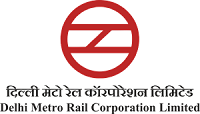
Information
Delhi Metro is an urban Mass Rapid Transit System (MRTS) built with 10 lines and 254 stations to serve India’s capital along with other towns in the National Capital Region (Gurgaon, Noida and others) by the Delhi Metro Rail Corporation (DMRC).
Construction for its 65.1 km Phase 1 started in 1998 and ended in 2006. Its first section to open was the Shahdara – Tis-Hazari section of the Red line, in 2002. Construction on the 124.93 km Phase 2 was completed in 2011, while construction on the 162.495 km Phase 3 project was completed in 2023.
DMRC began the bidding process for the construction of the 65.1 km (and growing) Phase 4’s new lines in mid-2019, and work on its first section started on December 30, 2019. When Phase 4 is completed in 2027 (estimated), Delhi’s metro network will become approximately 450 km long. Additional phases have not yet been formally planned or announced.
System Specifications
- Top Speed : 80 kmph
- Average Speed : 34 kmph
- Track Gauge : Broad Gauge: 1676 mm (lines 1-4) and Standard Gauge: 1435 mm (lines 5-9)
- Electrification : 25 kV, 50 Hz AC OHE
- Signalling : Cab Signalling/Distance to Go (lines 1-6), CBTC (lines 7-9)
Key Figures
Operational: 351.28 km | Under Construction: 65.1 km| Approved: 20.76 km | Proposed: 35.76 km
- Daily Ridership : 68.16 lakh/day (July 2023)
- Rolling Stock : 2214 coaches by Rotem, BEML, Bombardier and CAF (see detailed table at the bottom)
Operational Lines ( Phase 1 , Phase 2 , Phase 3 )
- Line-1 – Red Line: Rithala – Shaheed Sthal (34.69 km, 29 stations)
- Line-2 – Yellow Line: Samaypur Badli – HUDA City Centre (49.31 km, 37 stations)
- Line-3 – Blue Line: Dwarka Sec 21 – Noida Electronic City (56.61 km, 50 stations)
- Line-4 – Blue Line: Yamuna Bank – Vaishali (8.74 km, 8 stations)
- Line-5 – Green Line: Mundka – Brigadier Hoshiyar Singh (29.64 km, 23 stations)
- Line-6 – Violet Line: Kashmere Gate – Raja Nahar Singh (46.63 km, 34 stations)
- Line-x – Airport Express Line: New Delhi – Yashobhoomi Dwarka Sec-25 (24.58 km, 7 stations)
- Line-7 – Pink Line: Majlis Park – Shiv Vihar (58.43 km, 38 stations)
- Line-8 – Magenta Line: Janakpuri West – Botanical Garden (38.235 km, 25 stations)
- Line-9 – Grey Line: Dwarka – Najafgarh (4.295 km, 3 stations)
Under Construction Lines ( Phase 4 )
- Line-7 – Pink Line: Mukundpur – Maujpur (12.558 km, 8 stations)
- Line-8 – Magenta Line: Vikaspuri Park Ramp – RK Ashram (29.92 km, 22 stations)
- Line-10 – Golden Line : Aerocity – Tughlakabad (23.622 km, 16 stations)
Approved Lines ( Phase 4 )
- Line-10 – Golden Line Spur : Lajpat Nagar – Saket G-Block (8.385 km, 8 stations)
- Line-11 – Green Line : Inderlok – Indraprastha (12.58 km, 10 stations)
Proposed Lines: Pending Approvals ( Phase 4 )
- Line-1 – Red Line: Rithala – Narela (21.73 km, 15 stations)
- Line-1 – Red Line: Narela – Kundli (4.86 km, 3 stations)
- Line-3 – Blue Line: Noida Sector-62 (Electronics City) – Sahibabad (5.11 km, 5 stations)
- Line-4 – Blue Line: Vaishali – Mohan Nagar (5.06 km, 4 stations)
Delhi Metro’s Route Map (Operational Network)
Delhi Metro’s PDF map for download will be made available when DMRC releases it. The embedded map below shows the exact location of all stations and can be zoomed into!
An official PDF route map of Delhi Metro will be added here when available.
Delhi Metro’s Future Network: Phase 1-4 Route Map
Key for map below: Phase 1 | Phase 2 | Phase 3 | Phase 4
Delhi Metro Fare Chart (Ticket Prices)
Fares on the Delhi Metro are calculated based on distance traveled and dependent on type. Fares were last revised on October 1, 2017 based on the suggestions of the 4th Fare Fixation Committee setup in May 2016.
• RFID Token (best for single one-way journeys) – Minimum fare is Rs. 10 and maximum is Rs. 60.
• Smart Card (best for multiple journeys) – minimum amount payable at the time of purchase of a new card is Rs 150, which includes a refundable security deposit of Rs. 50. Users can subsequently recharge/load a minimum of Rs. 200 up to a max of Rs. 3000.
• Tourist Pass – 2 types available for travel on all lines except the Airport Express Line. (1) 1 Day Unlimited Rides Card : available for Rs 200 (Rs 150 + Rs. 50 refundable security deposit) (2) 3 Day Unlimited Rides Card: available for Rs 500 (Rs. 450 + Rs 50 refundable security deposit)
Delhi Metro’s fare calculator is simple and can be viewed here .
Delhi Metro Rolling Stock
As of March 2019, DMRC operated a total of 2214 coaches (1352 broad gauge and 862 standard gauge). In June 2021, DMRC invited tenders for procuring another 288 coaches for Phase 4.
Delhi Metro Tenders
Latest Delhi Metro (DMRC) tender notices can be viewed on the DMRC’s website . News on these notices, their bidders, awarded tenders and contracts are covered in further detail on the news & construction page.
Delhi Metro History (Key Dates)
Phase 1 • 25 Dec 2002: Shahdara – Tis-Hazari ( Red Line ) – 8.3 km • 03 Oct 2003: Tis Hazari – Inder Lok ( Red Line ) – 4.1 km • 31 Mar 2004: Inder Lok – Rithala ( Red Line ) – 8.9 km • 19 Dec 2004: Vishwa Vidyalaya – Kashmere Gate ( Yellow Line ) – 4 km • 03 July 2005: Kashmere Gate – Central Secretariat ( Yellow Line ) – 7 km • 31 Dec 2005: Dwarka – Barakhamba ( Blue Line ) – 22.9 km • 01 Apr 2006: Dwarka – Dwarka Sector 9 ( Blue Line ) – 6.5 km • 11 Nov 2006: Barakhamba – Indraprastha ( Blue Line ) – 4.0 km
Phase 2 • 04 Jun 2008: Shahdara – Dilshad Garden ( Red Line ) – 3.1 km • 04 Feb 2009: Vishwa Vidyalaya – Jahangirpuri ( Yellow Line ) – 6.4 km • 10 May 2009: Indraprastha – Yamuna Bank ( Blue Line ) – 2.1 km • 13 Nov 2009: Yamuna Bank – Noida City Centre ( Blue Line ) – 13.1 km • 08 Jan 2010: Yamuna Bank – Anand Vihar ( Blue Line ) – 6.3 km • 03 Apr 2010: Inderlok – Mundka ( Green Line ) – 15.1 km • 21 June 2010: Qutub Minar – Huda City Centre ( Yellow Line ) – 14.5 km • 03 Sept 2010: Central Secretariat – Qutub Minar ( Yellow Line ) – 12.5 km • 03 Oct 2010: Central Secretariat – Sarita Vihar ( Violet Line ) – 15 km • 30 Oct 2010: Dwarka Sector 9 – Dwarka Sector 21( Blue Line ) – 2.8 km • 14 Jan 2011: Sarita Vihar – Badarpur ( Violet Line ) – 5.1 km • 23 Feb 2011: New Delhi Railway Station – Dwarka Sec 21 ( Airport Express Line ) – 22.5 km • 14 July 2011: Anand Vihar – Vaishali ( Blue Line ) – 2.6 km • 27 Aug 2011: Kirti Nagar – Ashok Park Main ( Green Line ) – 3.3 km
Phase 3 • 26 Jun 2014: Central Secretariat – Mandi House ( Violet Line ) – 3.03 km • 08 Jun 2015: Mandi House – ITO ( Violet Line ) – 0.972 km • 06 Sept 2015: Badarpur – Escorts Mujesar ( Violet Line ) – 13.875 km • 10 Nov 2015: Jahangirpuri – Samaypur Badli ( Yellow Line ) – 4.489 km • 28 May 2017: ITO – Kashmere Gate ( Violet Line ) – 5.17 km • 25 Dec 2017: Botanical Garden – Kalkaji Mandir ( Magenta Line ) – 12.64 km • 14 Mar 2018: Majlis Park – South Campus ( Pink Line ) – 21.57 km • 29 May 2018: Janakpuri W – Kalkaji Mandir ( Magenta Line ) – 25.26 km • 24 June 2018: Mundka – Brigadier Hoshiyar Singh ( Green Line ) – 11.182 km • 19 Nov 2018: Escorts Mujesar – Raja Nahar Singh ( Violet Line ) – 3.205 km • 6 Aug 2018: Durgabai Deshmukh South Campus – Lajpat Nagar ( Pink Line ) – 8.1 km • 31 Oct 2018: Trilokpuri Sanjay Lake – Shiv Vihar ( Pink Line ) – 17.8 km • 31 Dec 2018: Lajpat Nagar – Mayur Vihar Pocket 1 ( Pink Line ) – 9.7 km • 9 Mar 2019: Dilshad Garden – Shaheed Sthal/New Bus Adda ( Red Line ) – 9.41 km • 9 Mar 2019: Noida City Centre – Electronic City ( Blue Line ) – 6.675 km • 4 Oct 2019: Dwarka – Najafgarh ( Grey Line ) – 4.295 km • 6 Aug 2021: Mayur Vihar Pocket 1 and Trilokpuri- Sanjay Lake ( Pink Line ) – 1.38 km • 18 Sept 2021: Najafgarh – Dhansa Bus Stand ( Grey Line ) – 1.218 km
…..more to be added in 2023! Click on ‘News & Construction Updates’ below for project news, progress and updates.
Delhi Metro Short Film
Page last updated: March 22 , 2024. Have a question or spot an error? Let me know here .
Riding the Metro: the Best Way to Get Around Delhi
Suzanne wanders delhi contains affiliate links.if you make a purchase using one of the links below, i may receive compensation at no extra cost to you. i only recommend products and services i use and trust. read my disclaimer for more information..
Most visitors are surprised to find out that Delhi has a fantastic metro system. I live in Delhi and take the metro all the time. Although it’s a massive network, it’s extremely easy to use and everything is in English. Mastering the metro is simple and will save you time and money. Delhi is so traffic clogged, riding the metro is the best way to get around.
The Delhi metro is differently-abled friendly with elevators, extra wide pay gates, ramps, tactile paths, handrails along stairs and accessible toilets. The Delhi metro is also an environmentally friendly system and has won many awards for its green initiative. No wonder it is known as the lifeline of the city.
If it’s your first trip to Delhi, read my complete guide and suggested itineraries for first time visitors .
The Network

Currently the metro is 391 km long and has 286 stations. It’s a newer system, the first lines started operating in 2002. The network is continually under expansion and is forecast to be the third largest metro network in the world by 2026.
Including the airport express line and the networks that service the suburbs of Noida and Gurugram, there are 12 lines. It pretty much goes everywhere you could want which is why riding the metro is the best way to get around Delhi.
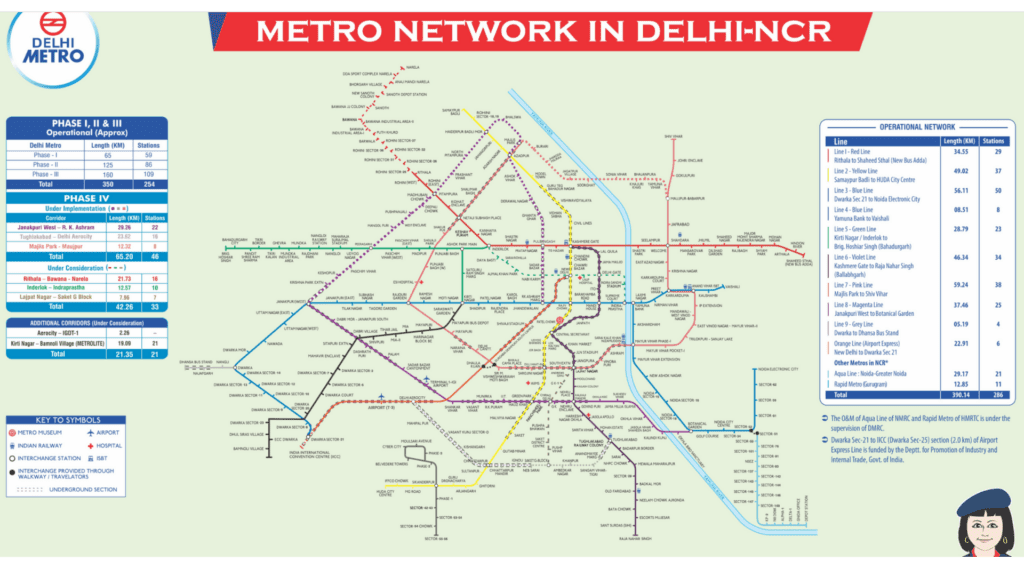
Hours of Operation and Fares
The Delhi metro runs between 6:00 am and 11:00 pm.
Single fares range from INR 10 to INR 60 depending on the distance. There is a 10% discount for metro card users and a 10% discount during off-peak hours and weekends. Children under 3 feet travel free. The cheap fares are one of the reasons riding the metro is the best way to get around Delhi.
The Best Free App for the Delhi Metro and Planning Your Route
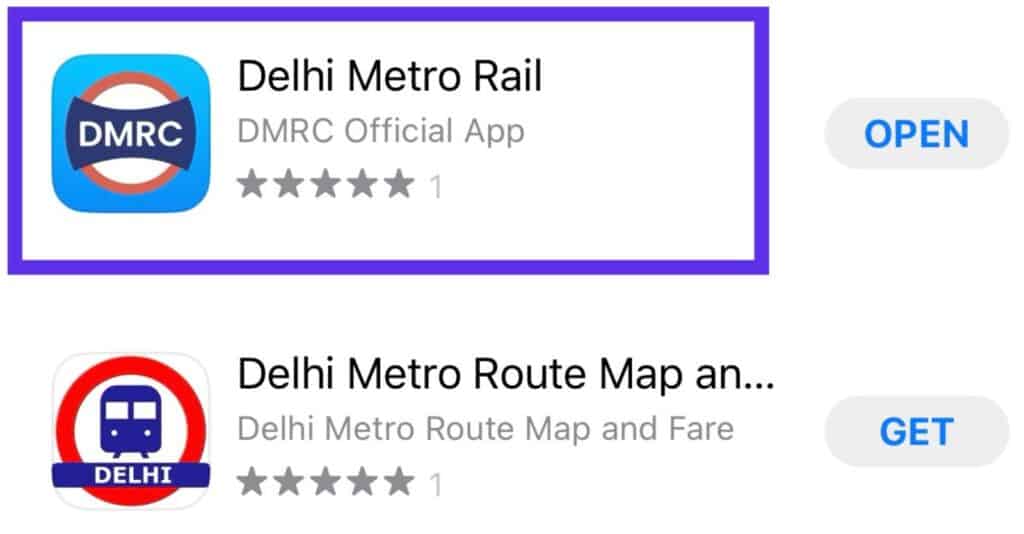
Delhi Metro Rail has an app you can load onto your smart phone to help navigate the system. The most helpful features are the interactive route map and the route finder.
There is also a route planner on the official Delhi metro website:
https://www.delhimetrorail.com/
It’s All Colour Coded
Everything on the metro is colour coded making it easy to navigate. This is another reason riding the metro is the best way to get around Delhi.
Train lines are named by colour, each train has a coloured stripe on its exterior indicating which line it operates on, signs painted on the floors are colour coded, and pink seats in each carriage designate seating for women only.
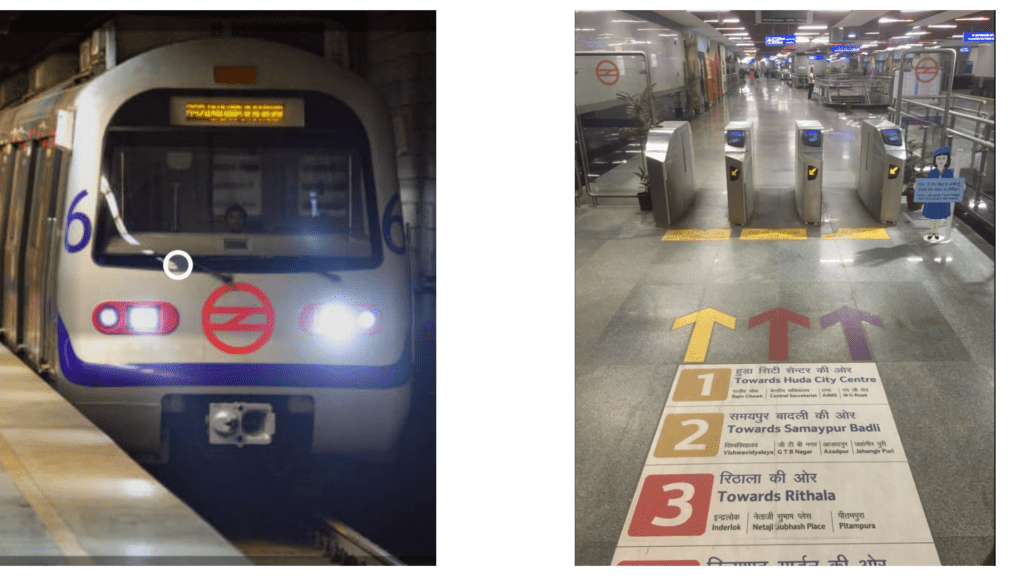
The floors are painted with coloured footprints indicating directions to different train lines. It’s impossible to get lost.
Buying the Fare – Tokens and Metro Card
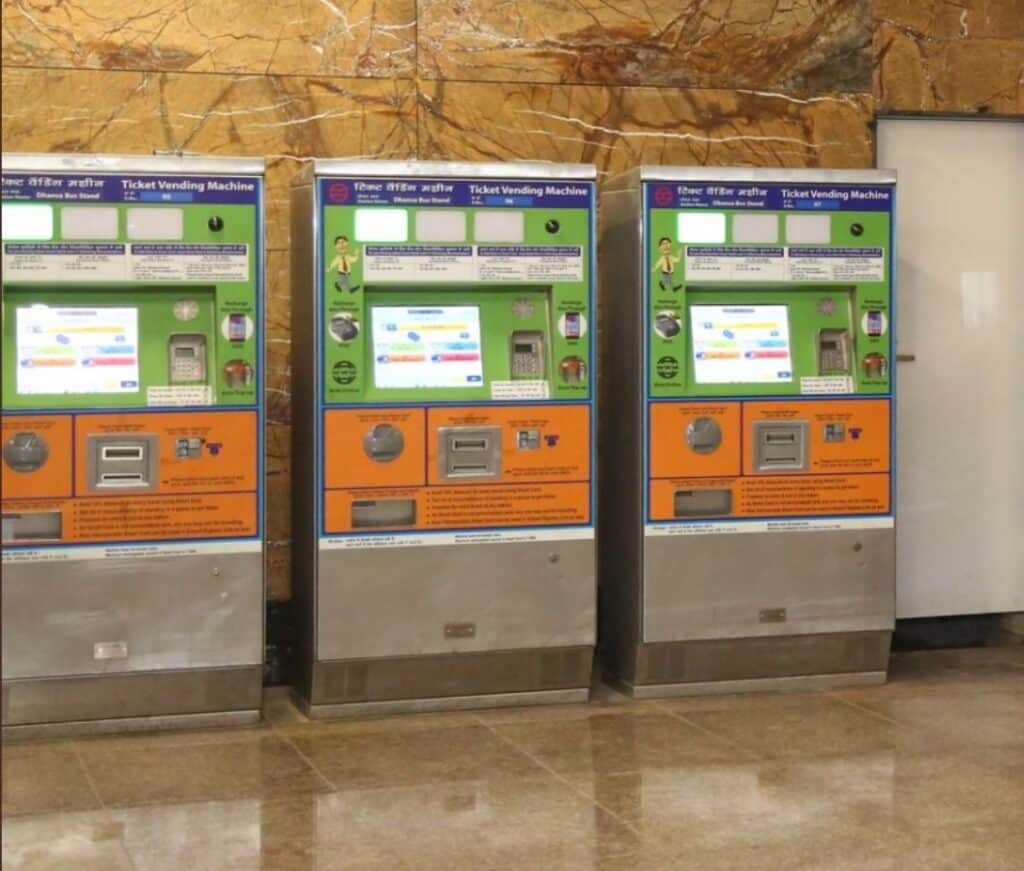
You can pay for your fare with tokens or a metro card. Both of these can be purchased at the ticket windows in the station. Tokens can also be purchased using the automated ticket machines in each station.
Metro cards must initially be purchased from the ticket window but can be topped up at the automated ticket machines after.
Tokens are valid for a single, one way journey and must be used on the day of purchase. The token must be used at the station purchased, which means you cannot buy two and use one later for the return trip.
Tell the clerk which station you are traveling to and they will issue you a single journey token. If using the ticket machine, just enter the name of the station and it will calculate your fare and issue the token.
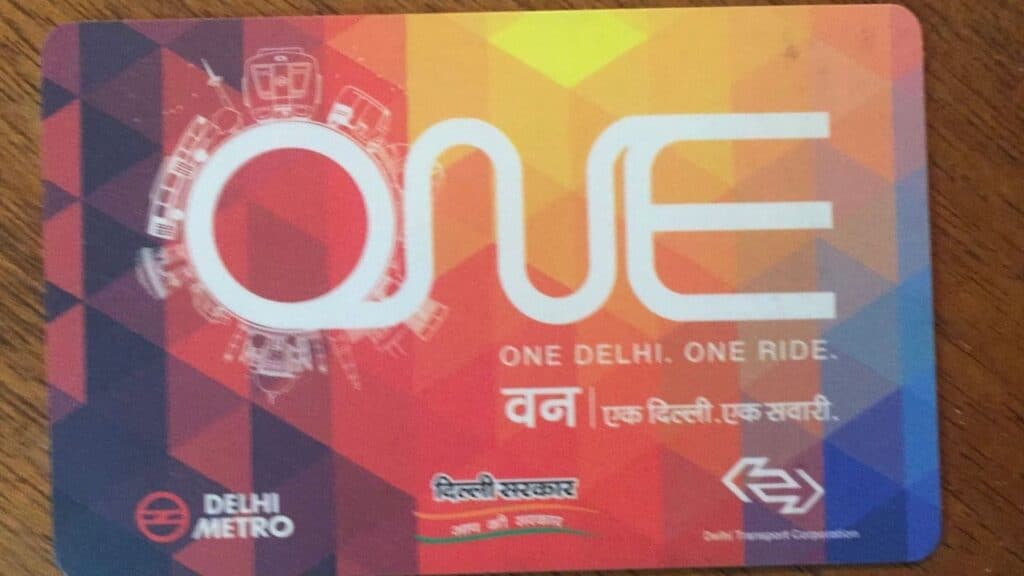
If you are planning to use the metro more than two or three times I recommend getting a metro card. It’s more convenient than buying a token for each trip and enables you to enter all gates of the metro, not just the ones with a ticket window or machine.
There is a INR 50 refundable deposit for the card and you have to put INR 200 on it initially. After that it can be topped up by INR 100s to a maximum of INR 3000. Any balance remaining is completely refundable minus a INR 5 processing fee.
Tourist Cards
Tourist cards are available for 1 day (INR 200) or 3 day (INR 500) with unlimited metro rides, except on the Airport Express (orange) line, the rapid metro Gurugram and the Aqua line (Noida-Greater Noida).
This includes the INR 50 refundable deposit for the card. If you want your deposit back at the end you can do this at the ticket window. They will deduct at INR 5 processing fee.
Insider tip: I don’t recommend the tourist cards unless you are planning to ride the metro for long distances multiple times in one day. The regular metro card is a better deal, and you can use the regular card on the Airport Express line and the Gurugram and Noida lines.
Getting Through Security at the Metro
Delhi has a lot of security. Bags have to be scanned and people get screened with a metal detector before entering malls, hotels and many attractions. The Delhi metro is no different. Before you can pay your fare and make your way to the platform you must go through security.
First, place your bags and/or purse on the security conveyer belt (just like at the airport). You do not need to remove electronic devices or anything from your bags. Just put them down as they are. I don’t leave my mobile in my bag, I carry it with me.
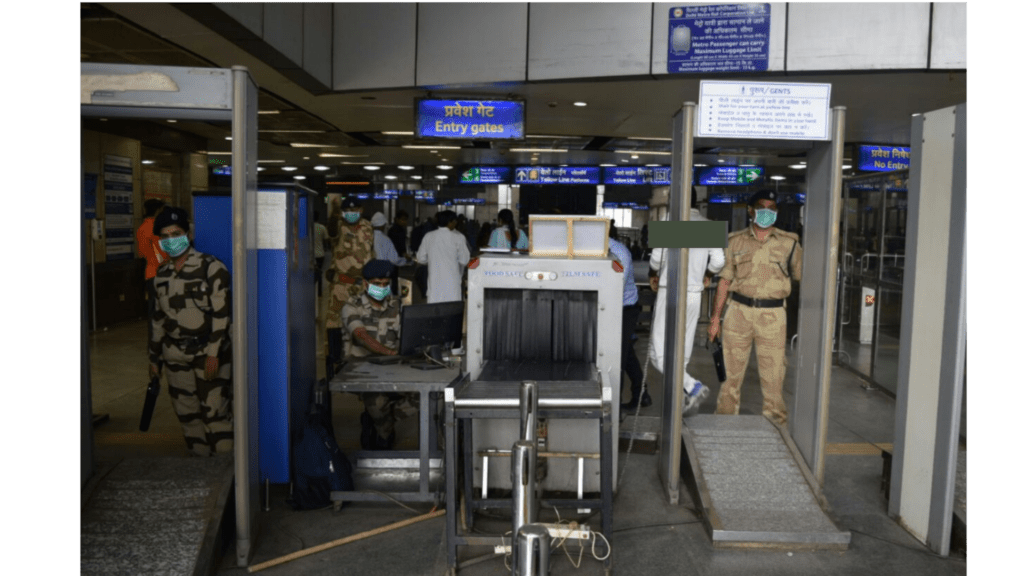
Second, get into the security line. There are separate lines for men and women. You do not need to remove anything.
The men’s is on the right, the women’s is on the left (usually). The women’s security area is sectioned off for modesty and policed by female security guards. When it’s your turn, go into the booth, stand on the platform, raise you arms into a T and let security scan you.
Then pick up your bags and make your way toward the platforms. It sounds lengthy, but it moves fast.
What is Not Allowed on the Delhi Metro
Sharp objects are not allowed on the Delhi metro. I was with a seamstress friend of mine when her fabric shears were nearly confiscated. Security gave her a pass, but I think this was because she was a foreigner and managed to explain the situation in broken Hindi.
Pets are not allowed on the Delhi metro. As a small dog owner, this is the only thing I don’t like about the metro. My life would be so much easier (and cheaper) if he could ride the metro!
Photography and eating is also prohibited in the metro. As of June 30, 2023, passengers are permitted to bring up to 2 unopened bottles of alcohol on the metro.
Paying and Getting to the Platform
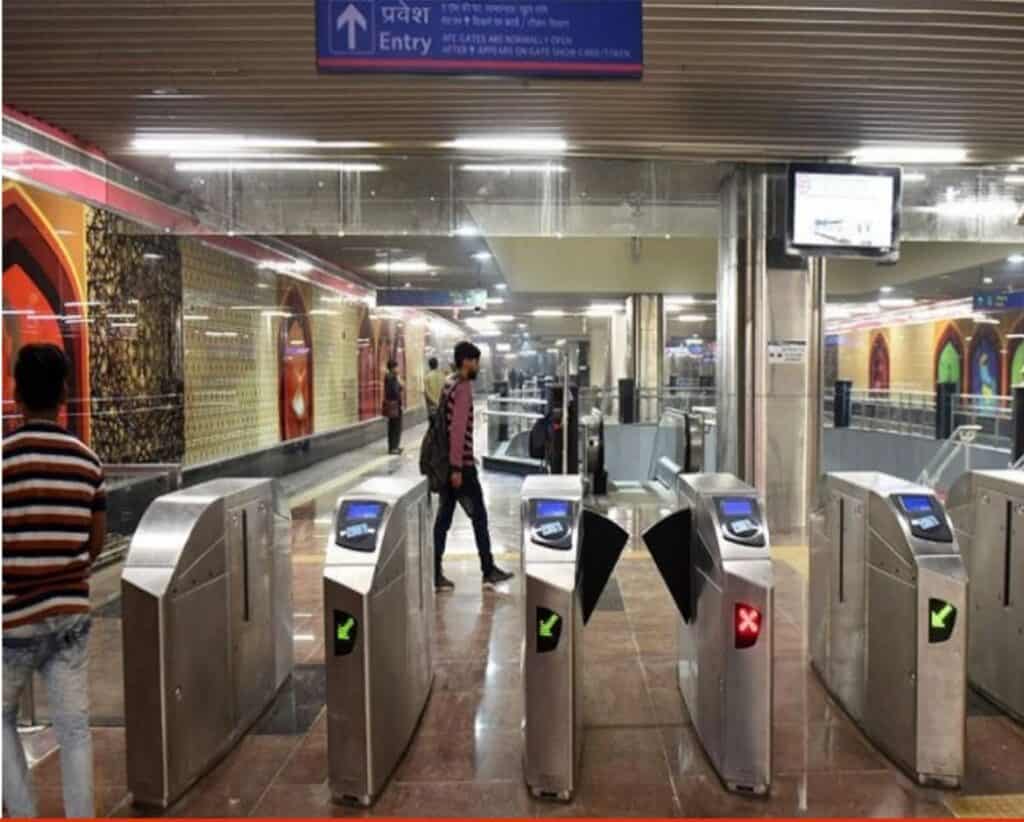
To pay your fare, simple scan your metro card or token on the reader at the top of the automated fare collection machine. If you’re using a metro card, the reader will display the remaining balance. Quickly go through while the flaps are open.
Follow the directional signs and make your way to the train platform. Keep your token or metro card handy because you will need it to exit the metro system.
Exiting the Metro
Drop your token into the automated fare collection machine. If using a metro card, scan it at the top of the machine like you did when entering the metro.
You do not need to go through security again. Most stations have multiple entrance and exit gates that will be well signed. To save time and avoid the possibility of having to cross busy Delhi streets, know which gate you need to exit to reach your destination.
Women’s Carriages
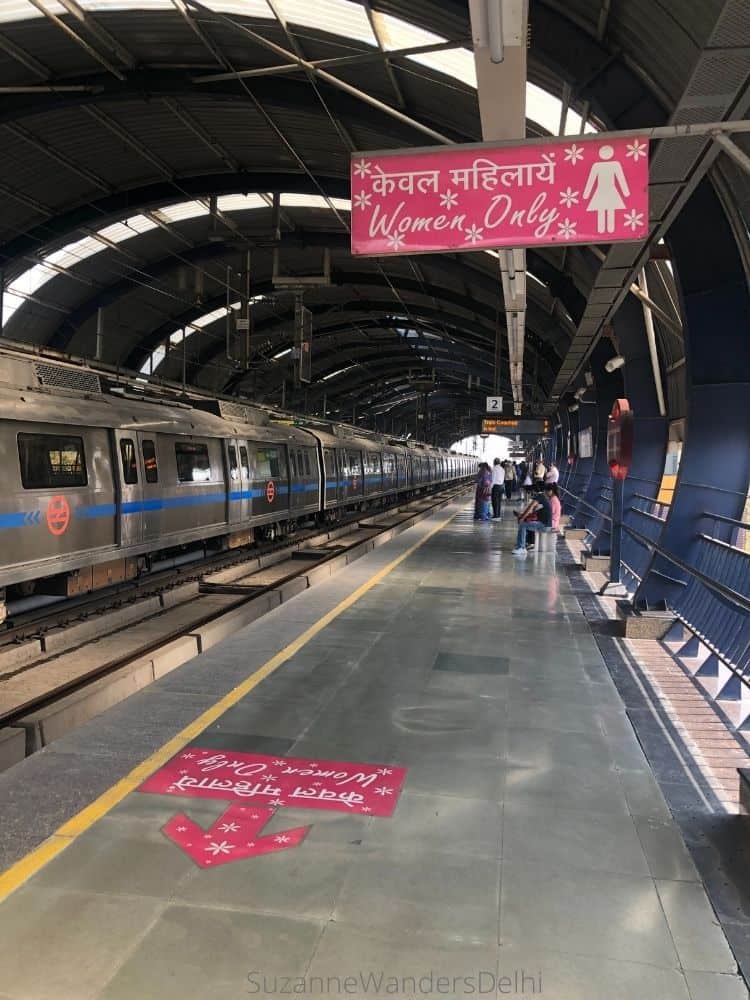
Each train has a women’s only carriage. It is the first carriage in the direction the train is moving.
If you are a woman traveling without a male companion, I recommend riding in these carriages. They are usually not as crowded and if they are crowded at least you will be squished up against other women.
The location of the women’s carriage is easy to spot on the platform, just look for the bright pink sign with flowers.
If you’re a man and you find yourself in a carriage with all pink seats, you’re in the women’s carriage. Just walk through the carriage to the next one as quickly as possible. If you’re a foreigner you’ll probably be forgiven, but if you’re an Indian man who should know better, you will be harshly redirected and scolded by the female passengers.
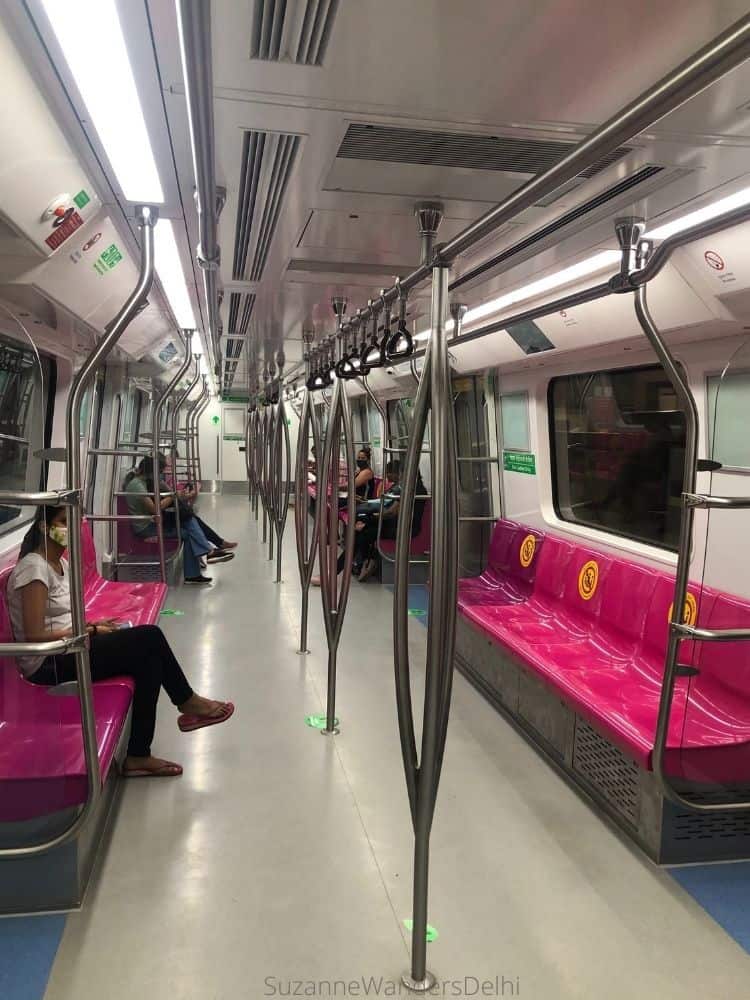
As a female I have always felt completely safe riding the Delhi metro, another reason it’s the best way to get around Delhi.
Airport Express Line
It’s easy to get to all terminals of the airport using the metro. The Orange Line is the Airport Express Line and it stops at Indira Gandhi International Airport, Terminal 3.
These trains operate from 5:30 am to 11:30 pm daily. It takes 23 minutes to travel from New Delhi station to the airport. You can use a regular metro card and the fare is INR 10 – INR 60, depending on which station you board at. There are racks for luggage.
If you are flying out of Terminal 2 you can easily walk there from Terminal 3. It’s well signed and less than 5 minutes. There are also shuttle buses.
If you are traveling to Terminal 1, the Airport Express line does not stop there (though you could take the airport shuttle bus between terminals). Instead, take the Magenta line to T-1 IGI Airport station. See my complete guide on how to get into Delhi from the Indira Gandhi International Airport .
Which Metro Stations are Closest to the Train Stations
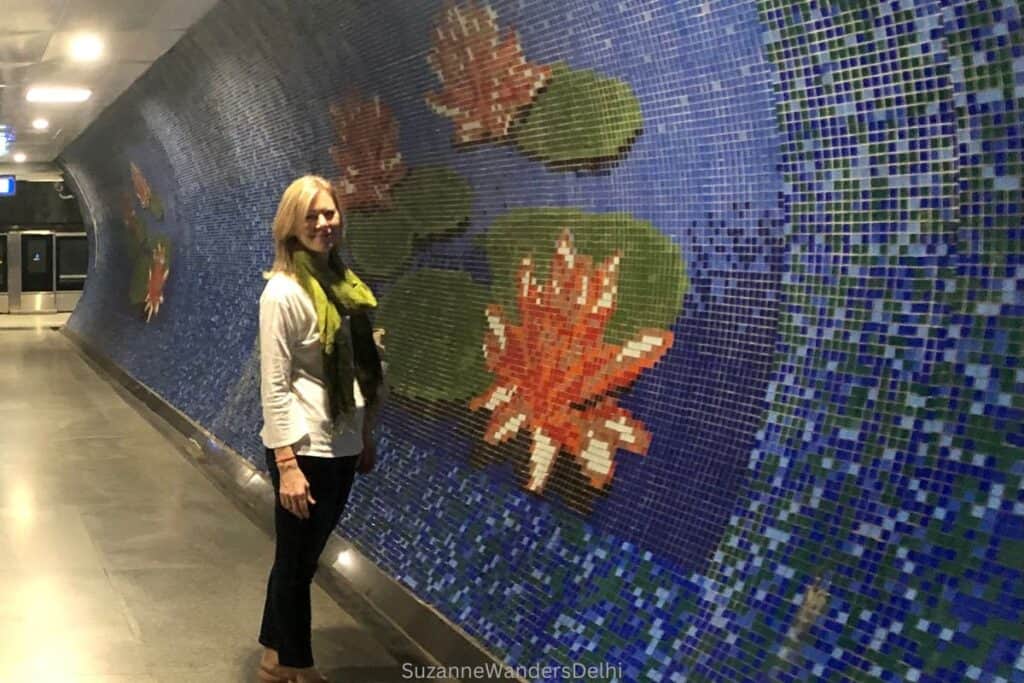
Delhi has five major train stations. If you are taking a day trip or traveling to your next destination, chances are you will travel from one of these stations:
- Old Delhi Railway Station (DLI) – Chandni Chowk metro station (Yellow Line)
- New Delhi Railway Station (NDLS) – New Delhi metro station (junction of Yellow and Orange Lines)
- Hazrat Nizamuddin Railway Station (NZM) – Hazrat Nizamuddin metro station (Pink Line)
- Anand Vihar Railway Station (ANVT) – Anand Vihar metro station (junction of Pink and Blue Lines)
- Delhi Sarai Rohila Railway Station (DEE) – Shashtri Nagar metro station (Red Line)
Visit the Metro Museum
The Patel Chowk metro station (on the Yellow Line) is home to the Metro Museum . I wouldn’t make a special trip just to see the museum but it’s definitely worth a look if you’re traveling on the Yellow Line.
The most surprising thing I learned at the museum was that the metro system was constructed in accordance with Vedic Hindu principles, though this really shouldn’t have surprised me given how spiritual India is.
The museum is open 10:00 am – 11:00 pm daily. Admission is free if you’re traveling on the metro, or INR 10 if you are not.
The Wrap-up on Riding the Metro: the Best Way to Get Around Delhi
Now you are are ready to ride the metro trains like a pro and get everywhere you need to go easily. You shouldn’t need any more convincing about why riding the metro is the best way to get around Delhi, but did I mention it’s air conditioned? See you on the rails!

Don’t forget travel insurance! It’s always a good idea to carry travel insurance just in case something goes wrong. I really like and use SafetyWing
Share on Social:
Suzanne Hooker is the owner and author of Suzanne Wanders Delhi, a blog that helps travellers explore Delhi, India. Suzanne lives in Delhi and is passionate about changing negative misconceptions about the city. When she isn't exploring and writing about Delhi, she is slow travelling through other parts of the world with her dog.

Similar Posts
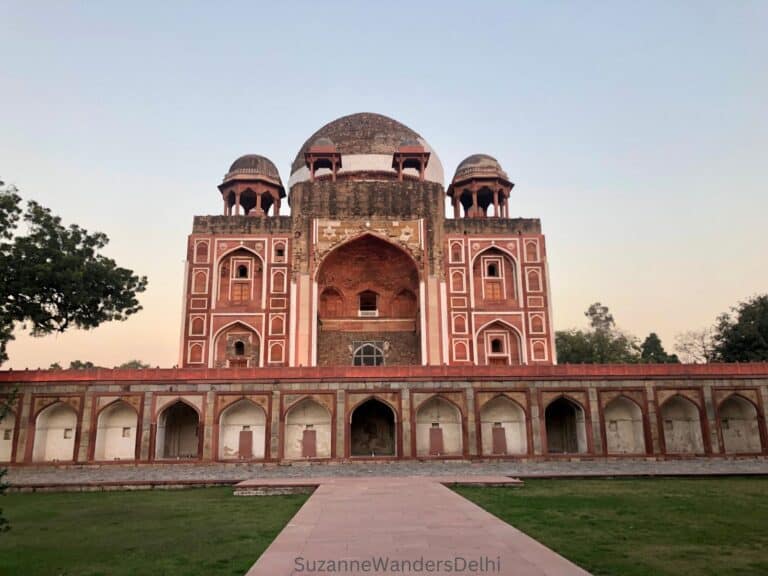
Is Delhi Worth Visiting? 10 Reasons to Go
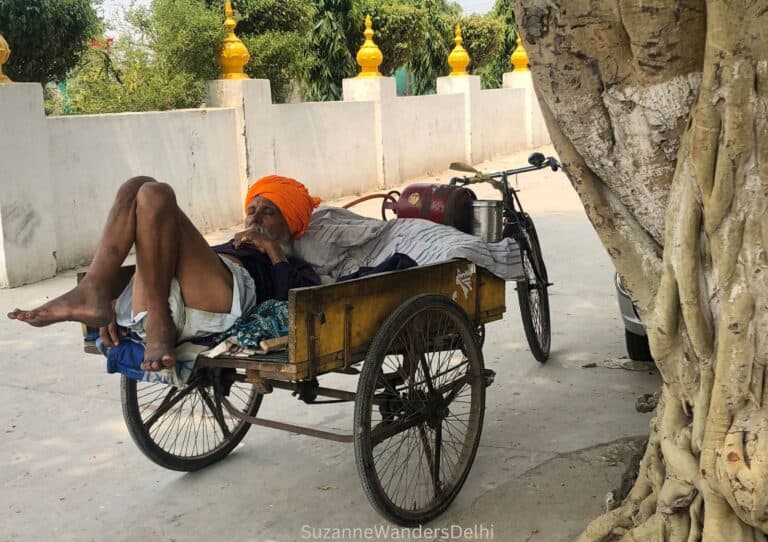
First Time in Delhi: Complete Guide and Itineraries for Delhi
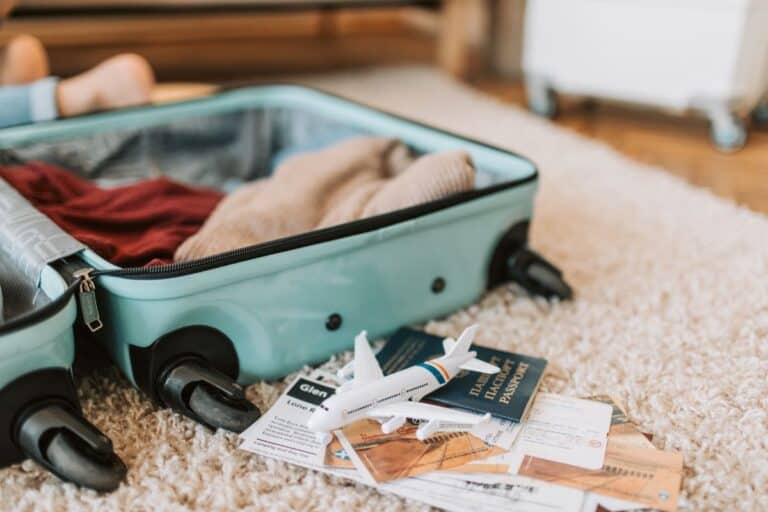
What to Wear in Delhi, India and Packing List – Tips from an Insider
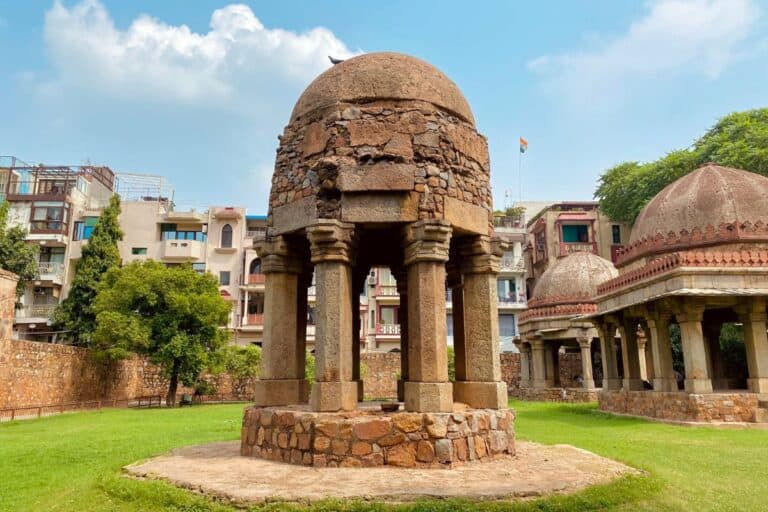
Delhi vs New Delhi: What is the Difference?
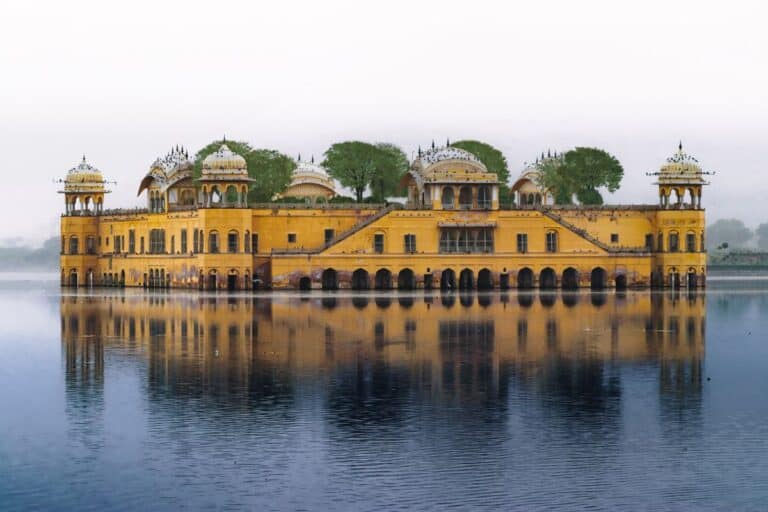
Delhi to Jaipur: The Best Travel Options by an Expert 2024
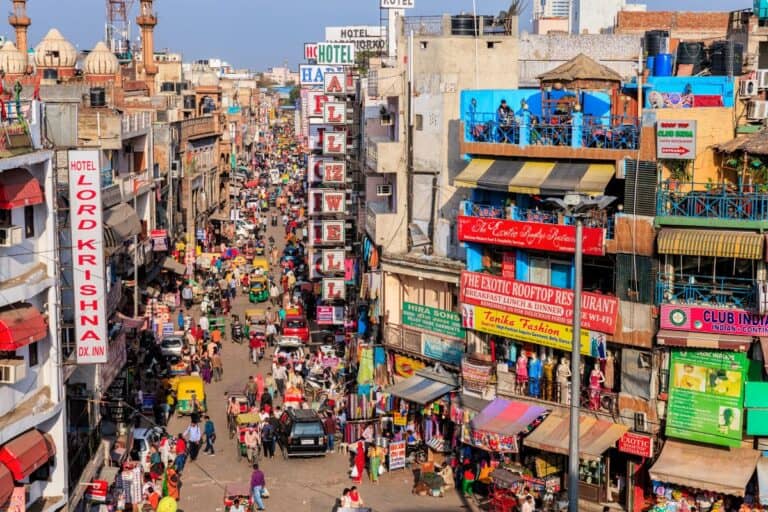
Is Paharganj Safe for Tourists?
Culturally Immersive & Responsible Travel
Does and Don’ts of Delhi Metro Rail: An Insider’s Guide (Updated after Unlock, 2020)
About this blog: Delhi metro is a fantastic solution to the never ending traffic jam and increasing pollution in the Indian capital. Connecting a substantial distance from Gurgaon to Noida, and Faridabad to Ghazibad, the Delhi metro route is a cheap and reliable way to commute to work in Delhi NCR. The cherry on the cake of the Delhi Metro route is the addition of Express Airport Metro Line. In this guide, we will tell you easy hacks and common etiquette for commute using the Delhi Metro Line! Delhi Metro is a safe choice for solo women travelers as well. This Delhi Metro rail guide also has information on things to do to ride the rail after lockdown is over.
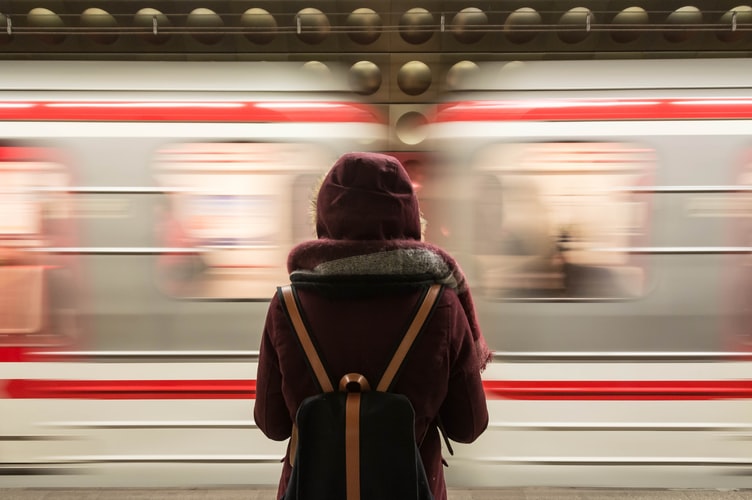
A similar travel guide for Kolkata Metro rail is here !
The iconic Lal Killa, better known as the Red Fort, Humayun’s tomb, the delicacy of Mughal kitchen from Karim’s at Jama Masjid, I would have known/seen none of it, had there been no Delhi Metro Line!
Right at the capital city of India, Delhi metro line is a network of air conditioned, clean and dainty train stations strategically located near the important tourist and business hub of New Delhi and connects a massive area stretched between the satellite towns and the real city.
The thought of using Delhi Metro for everyday commute might be intimidating at first, however this guide aims to simplify the extensive route and help you with a general overview of New Delhi metro system!
To help you use the Delhi Metro on a regular basis, I have got you covered on the following questions!
Updated on September, 2020: Post Lockdown opening up of Delhi Metro & Safety Protocols
After a hiatus of 169 days, Delhi metro has resumed services in the NCR region. From September 7 to 12, every line of Delhi metro has restarted daily operation with strict protocol implemented. Here is everything you need to know about riding Delhi Metro Rail during the unlock period. These constitute to be part of safety protocol being in place to make Delhi metro Journey a safe experience for the passengers and the staffers.
- Delhi Metro Rail is operating from 6 am to 11 pm, everyday. Regular timing.
- Not all Delhi metro rail gates will be open for passengers for making an entry to the station. For example, stations like Rajiv Chowk, Kashmiri Gate, Central Secretariat, Hauz Khas will have two gates open for passengers entry. (Of a total of 671 gates of Delhi Metro, only 257 will remain open during this period. that is 38% of the entry points).
- There will be separate gates for entry and exit to the stations.
- Thermal screening to be performed on every passenger before entering the Delhi Metro. In case of fever or high temperature, the passenger will be escorted to the nearest medical center and will be subjected to quarantine in case Covid test comes positive.
- At an average, 1500 passengers used to avail services of Delhi metro from 6 coaches. Only an estimated 300 passengers (20% of usual capacity) will be allowed to travel by Delhi Metro at any given point of time.
- Passengers will be allowed in only if they are wearing a mask and a set of gloves.
- Aarogya Setu app has not been made mandatory any longer but highly encouraged by the officials.
- Use of Smart Card has been mandatory to ride the Delhi metro. Cashless transaction is practiced for the time being. SO do not expect to buy token.
- Recharging smart card can be done with Debit card/ credit card and e-wallets like Paytm and new smart cards ‘Autope’ which can be linked with bank accounts. New cards, linked to bank account, has an option to set a standing instruction to top up as the amount goes down to INR 100 (minimum balance of a smart card).
- Strict social distancing norms have been imposed at every station of Delhi Railway. Stickers have been placed on the seats and station. Volunteers, CCTV camera are install in place to regulate the situation. Audi-visual guides are placed at every station.
- Only three passengers are allowed in the lift at a time.
- Alternate seats will be left vacant. At least one meter of distance is to be maintained between two standing passengers.
- Overcrowding is strictly not allowed in the Delhi Metro station after in re-opens service. Entry gate, ticket counters, customer service center, ticket vending machines, AFC gates (for entry and exit), lift, escalators, and platforms are kept under vigil to control any unwanted situation.
- Trains will stop longer for 45 seconds at every station to ensure social distancing is maintained while boarding and disembarking coaches.
- To prioritize fresh air intake inside the coaches, trains will stop for 45 seconds at the terminal stations.
- Passengers are informed to account for 10 to 15 minutes of extra travel time due to increased security measures.
- Parking at the Metro station is allowed.
- Feeder buses services has not been resumed so far.
- At night, the entire train and station will be sanitized. Sanitation will be an ongoing task at an interval of 4 hours at the station, lift buttons, handrails (any place that may attract human contact) and the public toilet.
- Passengers are allowed to carry small bottles of sanitizer bottle (30 ml). Please refrain from carrying metallic things in your luggage.
Ministers have requested passengers not to travel during peak hours unless essential. With daily Coronavirus cases reducing at the Delhi NCR region, local business is banking on the Delhi Metro Rail to revive economic activities. Shops operating at the metro stations will be resuming services as well.
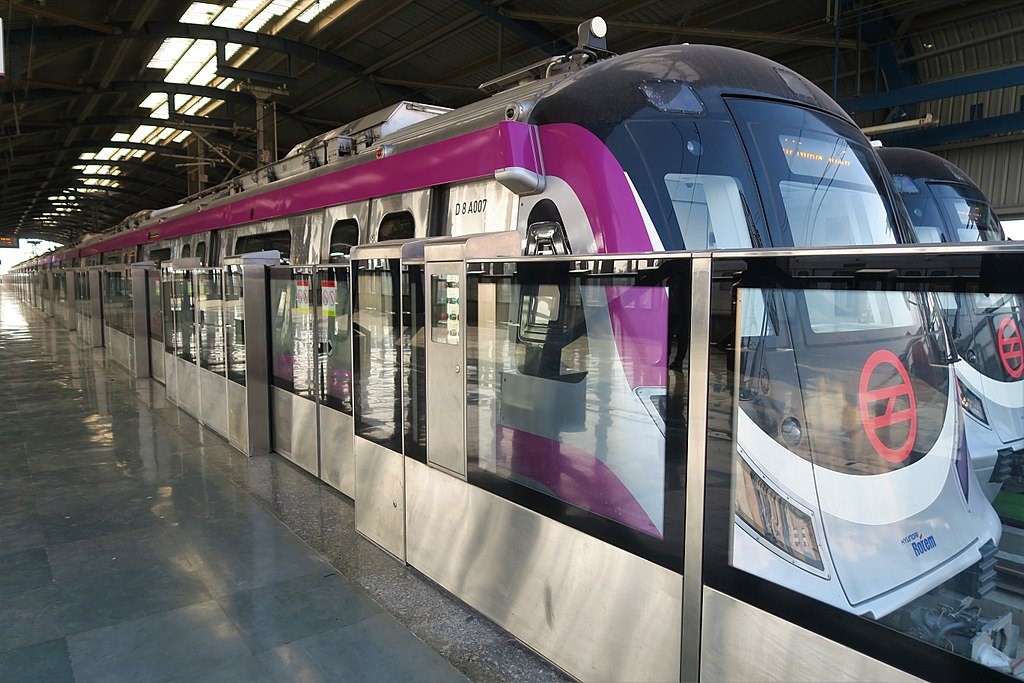
The New Delhi Metro: the Safest way to Commute for Tourists in Delhi?
Since there is a guard at every coach and security check at the entry point, the Delhi Metro is so far the safest way to travel in the city, even at the wee hours of the day. CCTV Camera surveillance is on place. People are largely respectful except for the peak hours. there is an unnerving crowd however that is manageable too! Besides, I personally venture out at night in Delhi by using the one and only Metro link! Pity they do not operate overnight!
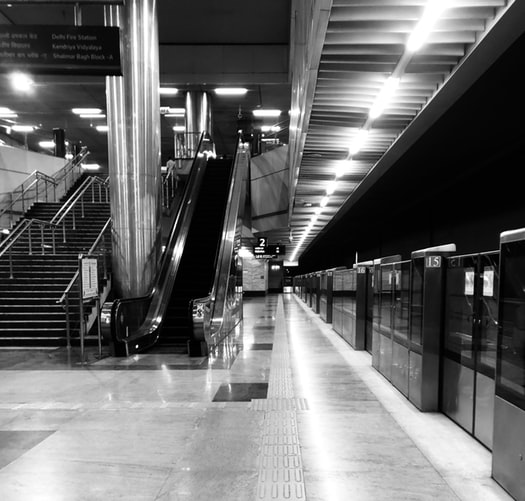
The norm to have a designated coach only for female travelers is highly regarded.
Entry to the New Delhi Metro line is strictly permitted basis on undergoing a scan. Scan is performed on the individual as well as luggage. Sniffing Dogs are taken out for rounds on certain occasions.
However, due to an incredible crowd pull, pick pocket is a regular nuisance at Delhi metro. Keeping an eye on our belongings and mobile is the only practical solution I found for this one!
Read more of my India travel stories here!
Finding a Metro Station: Where is the next Delhi Metro Ride Awaiting?
The New Delhi Metro station connects close to 184 station from Delhi and the suburb area. The air conditioned coaches run efficiently at an interval of 10 minutes and helps millions of people travel safely and smoothly. The network is growing everyday with more station coming on board.
If you are not staying right in front of a Metro station in Delhi, you may use a DTC bus, metro feeder bus, auto rickshaw and cycle rickshaw to reach the nearest Delhi Metro sign.
The nonlinear metro line is further divided into five color coded routes and one express airport link, running underground, on the ground or on elevated platform.
Delhi Metro Link: Know before you go!
While train coaches are wheelchair-accessible, along with most of the stations, some entrances have only stairs for access. The elevator needs to be hunted down. An escalator however shall be connecting the different levels.
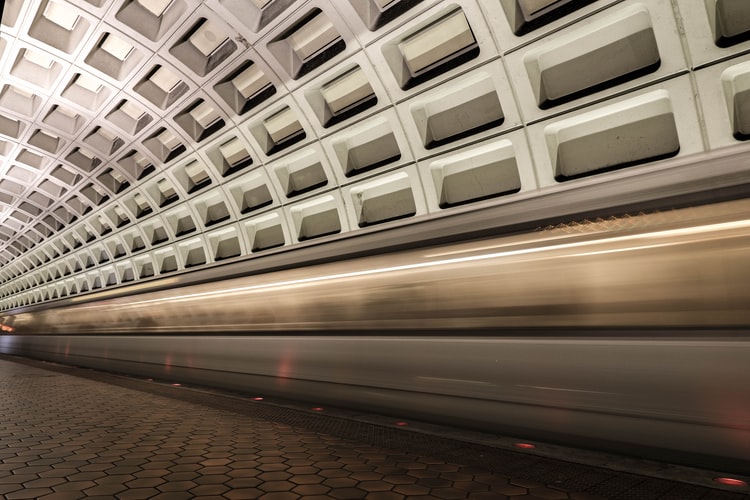
Delhi Metro Link runs fully air conditioned coaches. Ladies and Old citizens have a reserved seat on every coach.
There is electronic board display and bilingual PA service (Hindi and English) at every train.
The trains have 6 to 8 coaches, with the last one generally being reserved for womenfolks. Kids up to 12 years are allowed to travel in the women boggy.
There are special trains run at Delhi metro where the entire carriage is reserved for women passengers. It is announced on PA system.
Research papers prove Delhi Metro is largely a pollution free mode of transport, celebrating green energy and thus hailed high by the United Nations.
Thinking of carrying that bottle of imported liquor for your friend’s birthday and traveling by Delhi Metro? Stop!
Eating food at the metro stations, photographing the interiors (hence all my pictures in this blog are for reference and used from Stock photos) and carrying alcohol, even sealed liquor bottle is prohibited. The latter is considered as a punishable offence.
Ticketing at the Delhi Metro Rail: Easy hacks for traveling on Cheap Fare on the Delhi Metro Line!
Every Metro station in Delhi is well equipped with a customer service/help counter where your questions/queries will be resolved.You can always ask the man in uniform (the police) for help.
Massive display boards are in place to help you guide through the complex network of Delhi metro. There are 5 color coded lines which maps the distant parts of the city.
The price range of Delhi metro varies from Rs 8 to Rs 50 . There are designated ticket counter where producing exact change will ensure faster transactions for a ticket, the “Exact fare Counters!”
I recall studying those maps at the beginning of each journey. However, time has changed and now you can get access to those details in a smart phone app: Delhi Metro Rail . You also have a detailed map of Delhi Metro on the app.
Public announcement service in Hindi and english will keep you updated with arrival and departure of the next carriage.
You can stand in a queue and book tickets for destinations, if old school is your style. There are separate queue for male and female commuters.
However, these days, there are automated vending machines. You shall be given a coin like ticket. The ticket price varies based on distance, unlike the one in NYC subway where a set price is the norm.
The coin like ticket needs to be swiped at every turnstile counter as you are about to enter the station. It is to be returned/ simply inserted into the machine as you are leaving the metro premises to be reused by another passenger.
In case the token does not work, ask help from a guard. They are there to help.
In case you need special assistance, or are on a stretcher, a gate will be open for you upon request.
Children below 90 cm (2.9 ft) can duck at the turnstile. You can save on the ticket money for them!
If a commuter is found traveling without a ticket, a fine of INR 50 will be imposed. Walking on the metro tracks on the other hand can bring INR 500 charge and 6 months in prison. You do not want to do that, trust me!
Be smart and get a smart card to ride the Delhi metro!
Regular commute is Delhi Metro can be turned into a cakewalk with a smart card. The Delhi Metro Smart Card comes with an extra 10% discount. It can be recharged for as low as INR 100 and Rs 50 security deposit.
The security deposit will be refunded as you give back the smart card. The smart card is active for an entire year after being issued or being recharged, whichever is the last activity.
The smart card for Delhi Metro can be recharged online . The first smart card needs to be bought at the customer care booth present at every station and does not need any documentation.
A single swipe with the Delhi Metro Smart Card will ensure you stay inside the Metro Premises for upto 180 minutes. Plan your trip accordingly. More details here .
Students ID is Delhi Metro can fetch you special privileges.
The Delhi university student Id card has bar code which can be used as the token. During peak hours, students can avail a discount of 45% and non peak hours, they will be getting 20% discount.
The Tourist Card at Delhi Metro and Why you Need to Use it!
If you are a tourist in Delhi, I highly recommend buying the Tourist card. At INR 200 you are entitled to unlimited rides at the Delhi Metro for a day . The Metro network runs effectively connecting many historical landmarks of the city. On a self guided tour in Delhi, the Delhi metro tourist card is your best budget bait.
You may extend the Metro tourist card for three consecutive days. The price is INR 500. An Uber will charge you a few 10 times of that!
In case you are staying in Delhi for longer, the 3 day long tourist card is what I recommend.
You are required to pay a 50 rs security deposit for the card (included in the prices mentioned above), which will be refunded to you at the end of the travel period.
How to Survive the Peak hours at Delhi Metro and why you should avoid that!
A few million people travel by the Delhi Metro. Yes, read that again!
Such is the might of a train line that connects obscure suburbs of the great Indian plain to the heart of Indian capital.
Trains run at an interval of 10 minutes. It fastens up to a few minutes at rush hour.
At the peak hours, from 8am to 10 am , you are likely to be assimilated in a humongous living mass of people, living, thriving, moving. Metro marshal don’t let their guard down for a moment at important junctions like the Rajib Chowk or the Yamuna bank, helping people to get down from the metro or to embark on a new journey.
It is unnerving, but you will get used to eventually. Just move with the crowd, fasten up with impending footsteps. There is no room for stopping for a while and breath! New Delhi moves at a lightening speed!
However, their is a sweeter deal just in case you are looking forward to make life a wee bit easier. Take the metro at the off-peak time window, and you will enjoy a 20% discount on your smart card journey.
If not the money, do it for a hassle free travel. Just writing about the rush hour and recalling the maddening crowd gives me an adrenaline rush! I did it and I am living, to write off the experience: that is nothing less than a wonder!
The Delhi Metro runs from 5:30 am to 11:30 pm. At midnight, there is no service by the Delhi Metro.
There are certain occasions, festivals and political rallies which might affect these hours. For example, during Holi, Metro starts operating from 2 am. If you are in doubt, just google, “Delhi metro News”.
A Map of Delhi Metro or the App?
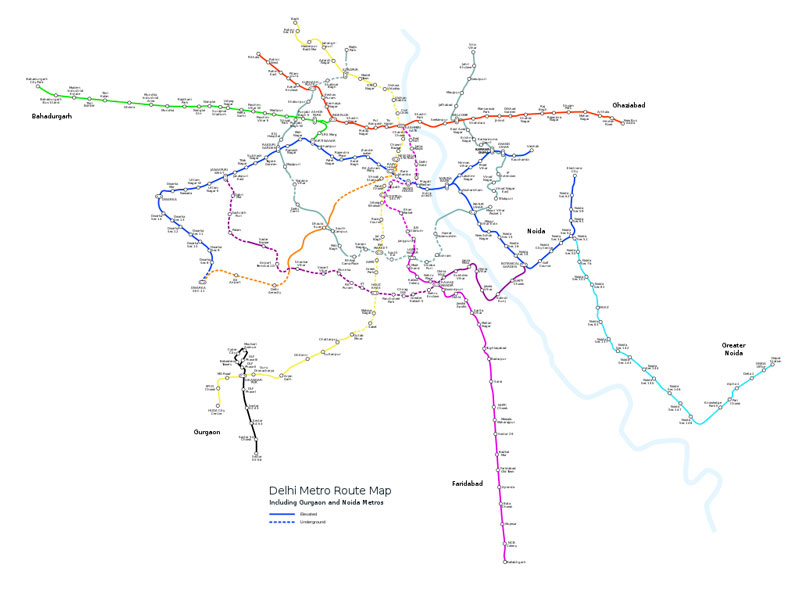
This Map is for the starter, use the app: Delhi Metro Rail. Highly recommended!
Understanding the color coded 5 metro routes of Delhi!
Delhi metro use color codes to highlight different routes. While, human brains are best wired to understand the magic underlying such complex network by a simple glance at the inforgraphic (the color coded map available at every station and on the app) I will try to list down the areas covered by each metro line! Please note, these metro routes are mostly interconnected, thus if your destination branches out at an obscure end, worry not. You can change the route where a different colored line is approaching.
How to change to a different color Metro Line in Delhi?
For example, you are traveling on the Red route. However your destination is on Green line. The Red and the Green route do not merge together. So you look out for the next route that the red line merges with, say yellow line. You will look if the yellow line merges with Green line anywhere.
If it does, bingo!
You change from red to yellow route at the next station, Travel by the yellow station. Get down where the yellow merges with green and continue towards your destination!
You need to change thrice, but still can use the metro network to reach your destination.
The Red Line of Delhi Metro
(Rithala to Shaheed Sthal New Bus Adda (Ghaziabad)
The first route where Delhi metro ever ran, the Red Line is an elevated train line. it connects Dilshad garden and Rithala. In the course, it joins with the Yellow Line at Kashmere Gate and the Green Line at Inderlok.
The Yellow Line of Delhi metro
(Huda City Centre to Samaypur Badli)
The yellow line connects the north of the city to the south. it also merges with the rapid metro of Gurugram. En route, the Red, Blue and Violet lines comes. and comes the important stations like Old Delhi and New Delhi railway stations. this is the best metro route for Delhi Sight seeing for a tourist. For airport, you just need to get down at the new Delhi Rail station and catch the Airport link.
The Blue Line on Delhi metro
(Dwarka Sector-21 to Vaishali/Noida Electronic Centre)
Connecting Dwarka Sector 21 and Noida City Center, the Blue Line is one of the longest of Delhi metro network with close to 44 stations in between. It interconnects with Green, Yellow, and Violet lines and touches the Airport metro in the path.
A small line branched out from the Blue line that connects Vaishali to Yamuna Bank
The Green Line on Delhi Metro
Kirti Nagar/Inderlok to Brig. Hosihar Singh
The shortest of Delhi metro route that connects the West of Delhi (Punjabi Bagh, Paschim Vihar, Nangloi and Mundka, majorly residential area) with red and blue routes.
The Violet Line on Delhi metro
The Violet line connects the central Delhi to the southern parts and runs further to Faridabad.
It branched out to the Heritage line , also my favourite metro route in Delhi which connected the old gems of Purani Dilli. It is an underground line has three stations giving direct access to Delhi Gate, Jama Masjid and the Red Fort in Old Delhi. Plus, the Kashmere Gate station provides an interchange between the Violet, Red, and Yellow lines.
The Pink Line of Delhi Metro
Runs from Majlis Park to Shiv Vihar.
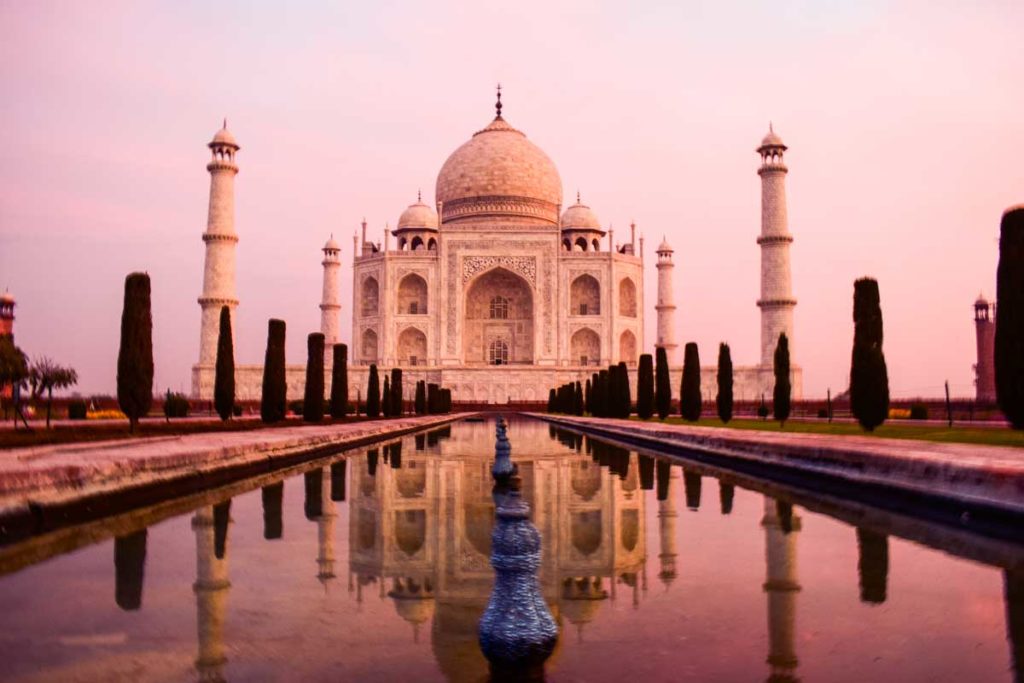
The Express Airport line of the Delhi Metro, and how to use it!
The Delhi Airport express line is the biggest blessing or wonder in urban India. We cannot wait till this joy reaches us in Bengaluru!
Connecting 6 stations between New Delhi to Dwarka Sector 21, the Delhi airport metro runs at 15 minute frequency. You can reach the heart of the city in a jiffy, literally! Just to give you a context of this excitement, earlier it would take a grueling 1 hour trudging through traffic etc.
Allways, a Hongkong based company runs a premium porter and indoor buggy service, priced at 300 rs, inside the Airport Metro Express Line’s Terminal 3 station.
In case you are commuting from the new Delhi Metro station to the IGI (New Delhi) airport, you may consider checking in your luggage and getting the boarding pass from New Delhi Metro Station and Shivaji Stadium Metro Station. Visatara, Air Asia have opened their check in counters at these stations. This service is available from New Delhi Metro Station from 6 hours to 2 hours before the schedule departure.
You can now enjoy seamless complimentary wifi connection at the Airport metro. Connect at airport express free wifi Oui DMRC Free Wi-Fi.
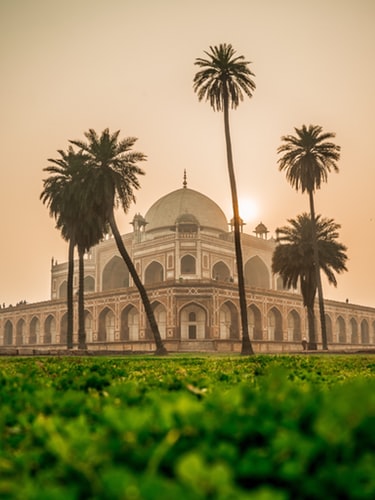
Simple Etiquette for using the Delhi Metro Line!
Many stations are equipped with coffee vending machines, cafeteria and small cafes.
ATM from different banks are available at every metro station or located at walking distance.
Washrooms for both the genders are available at Metro station.
Major stations with interlinks are Rajiv Chowk, Central Secretariat and Kashmiri Gate. Expect rush at every hour of the day.
Passengers can carry upto 15 KG of luggage in Delhi Metro.
You cannot carry a bike/cycle in Delhi metro
The doors at carriages open on both the sides. You are not allowed to lean over them.
Pets are not allowed to be carried inside the metro coaches. Not even tiny fishes. Not even plants. However, bouquets are allowed.
In the big bad metropolis of Delhi, lovers might steal a moment or two at the overtly populous Delhi Metro. It might strange however you will be surprised to know how often it actually happens. let them be. Don’t ogle. And don’t even think of creating the ruckus as they did in Kolkata metro!
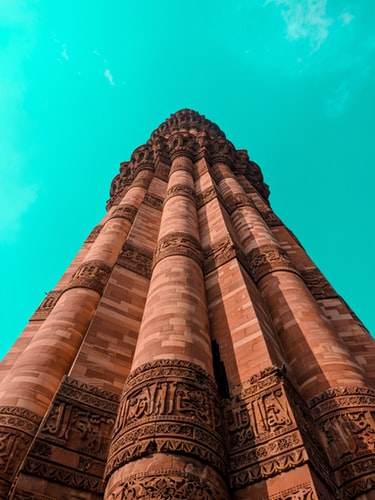
Delhi Metro Stations near the Prominent Landmarks of Delhi!
Please remember the metro stations are strategically located near a bunch of historical sites. They will bring you closest to it, but not opposite the doorway! You need to walk your bit and explore the places. Considering the exorbitant prices of Uber and never ending traffic jam, I would happily walk from the Metro gate.
1. Chandni Chowk (Yellow line)
The heart of Purani Dilli, the city of Djins! You take leave out of the swank new world metro sttaion and be time transported into an old chaoytic and beautiful place! Minarets, stones houses, kebab scented streets, azan from Juma Masjid, all come forward to greet you! You know you have arrived at Delhi!
The Red Fort is a mere 10 minutes walk.
Also read, The Karims by the Jama Masjid, where Mughal Kitchen lives till date!
2. Rajiv Chowk (a Node between yellow and blue lines)
One of the major nodes of Delhi Metro line, the Rajiv Chowk brings you close to janpath. The Mecca of street shopping, Janpath is the place to be if street shopping is your forte.
Consider visiting the Connaught Place, the commercial business and financial hub of Delhi. I remember seeing India’s first revolving restaurant at the Connaught place. A marvel from vintage era!
3. Hauz Khas (the yellow line)
Noone has ever lived and loved in Delhi and has not visited the hauz khas. A village like set up at the heart of Lutyens Delhi, Hauz Khas village ushers a hip star vibe which you will seldom find in any other metro city! The wall graffiti make up for interesting Instagram spots as well.
4. Nehru Place (the violet line)
Loacted near the Lotus Temple, one of the eight Bahai temples in teh world. A temple shaped like a lotus where pin drop silence resides.
5. Central Secretariat (the yellow and violet lines)
Located close to the Ganchi Memorial, Indira Gandhi Memorial, Lodhi Garden, India Gate, the Parliament House, this metro link lets you come closest to the seat of power that Delhi is!
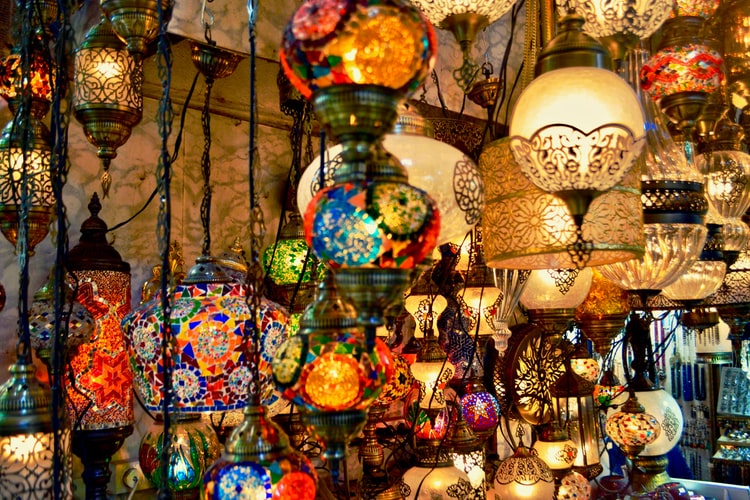
Apart from a few stray incidents of power failure, slowing down or petty crimes, Delhi metro has served a lofty task to the citizens by saving money, precious time and reducing emissions of greenhouse gas to a substantial measure!
Pin it for later!
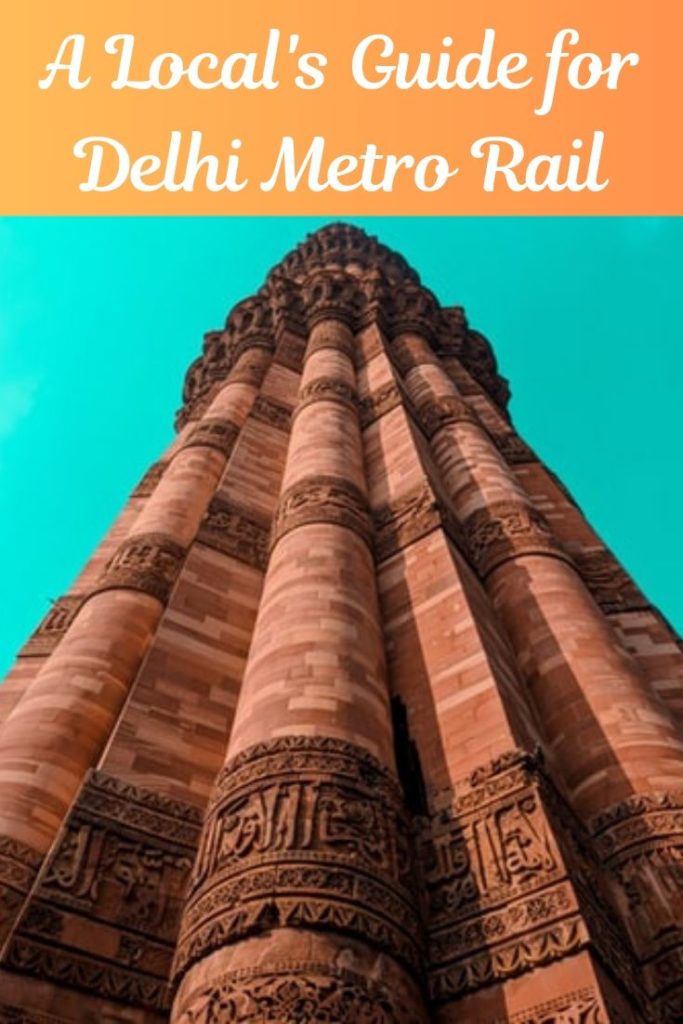
Want to get real time updates of my travels?
Get updates and read additional stories on the Orange Wayfarer Facebook page .
Follow Orange Wayfarer on Instagram .
Follow Orange Wayfarer on Twitter .
You may also subscribe to my weekly newsletter!
14 Responses
I’m a Pakistani with Indian origin. Have visited India once and really want to visit it again. Very informative post and Delhi looks like a must visit destination 🙂
This is really relevant and helpful information. I am yet to get here with my family but it’s on the bucket list.
oh wauw! I didn’t even know about this! Would love to visit India again one day and spend more time in Delhi!
This is very helpful! I haven’t been to Delhi yet but I do prefer to use public transport, so this can definitely come in handy when I go!
Great advice! I wish I would have read this before visiting Delhi last year.
Lovely! Interesting and quiet detailed information compiled and presented in an easy to grasp manner. Thank you!
This is a very useful article with a lot of useful information. Thanks for sharing.
This makes me less intimidated to take the public transport! Thank you!
Very informative post! I will definitely be referencing this if/when I visit. Thanks!
I didn’t realise that Delhi had such a modern and clean metro system with state of the art security. I have only ever seen the crowded trains on tv!
Really it very helpful while being in Delhi. can I carry cigarette and lighter inside delhi metro.
yes. it is possible.
Very informative…. Good…… Is it possible to catch metro for IGI airport from NDLS after arriving DEHRADUN shatabdi @ 23.15? is it possible to reach metro line & get tickets with in 15 minutes as last metro departs at 23.30? Small tips will be useful.
My brother studied at Dehradun and he says Jan Shatabdi will be at least 15 to 30 minutes late. Best is to book a car to reach airport. Otherwise, 15 minutes sounds too rushed since a substantial amount of walking in involved. Keep at least half an hour to one hour in hand to reach NDLS and further getting transferred to airport metro line.
Leave a Reply Cancel reply
Your email address will not be published. Required fields are marked *
Public Transportation and Metro Rail Information
Delhi Metro Rail
The Delhi Metro is an integrated transport system serving the city of Delhi and its neighbouring districts. Operated by the Delhi Metro Rail Corporation Limited (DMRC) – a State-owned company overseen by both the central and state governments – the metro extends over a total length of 296.1 kilometres (184 miles). The system has 214 stations spread over eight different lines. There is also an integrated line, the Airport Express, which provides direct service to the airport. The metro was inaugurated on 24 December 2002 with the inauguration of the Red Line, and has been expanding ever since, making it the second largest metro system in India. The metro operates from 6:00 am to 11:00 pm, with ticket prices starting at 10 rupees (approximately $US 0.14).
The system carries an impressive 1,500,000 passengers daily. Fares are set at 0.12. Unfortunately, it does not operate 24 hours a day, but on the plus side, there is air conditioning. It is possible to walk between platforms and the trains are not driverless.
The platforms do not have screen doors. It is operated by the Delhi Metro Rail Corporation Ltd (DMRC). Operating hours are from 6:00 am to 11:00 pm from Monday to Sunday. Fares range from Rs. 8.00 to Rs. 50.00.
More information can be found on the Delhi Metro Official Website .
Delhi Metro Map
Map of Delhi Metro showing different lines. Click on the map to enlarge it.

Delhi: The Indian Metropolis
The capital of India, New Delhi, is part of the larger National Capital Territory of Delhi (NCT) and is a key city in the country. Located in the north-central part of India, the city is home to around 12 million people, making it the second most populous city in the country. Including the wider metropolitan area, the population reaches 26 million. The total area of the city is 1484 square kilometres (573 square miles).
The city is known for its myriad of traditional structures, which led to its candidacy for the UNESCO World Heritage designation in 2014.
Delhi has a hot climate with average summer temperatures reaching 39°C (89.6°F) and winter temperatures peaking at 8°C (46.4°F).
Metro System in Detail
The Delhi Metro spans 296.1 kilometres (184 miles) and covers large parts of the city and surrounding areas. The system was officially inaugurated on 24 December 2002, with the first phase comprising the Red Line with six stations.
Over the years, the metro system has significantly expanded its coverage and has become one of the most important metro networks in the country. The types and models of trains have been modified and upgraded with each phase of expansion. Hyundai Rotem, a company specialising in rail manufacturing, supplied the vehicles for Phase 1. However, for subsequent phases, vehicles from the Canadian company Bombardier were used.
The Delhi Metro Rail Corporation Limited (DMRC) is the public sector operator of the system, which is estimated to carry 1 billion passengers a year.
- Name: Delhi Metro
- Total Length: 296.1 kilometers (184 miles)
- Rail Gauge: 1,435 mm (4.71 ft)
- Number of Lines: 8
- Number of Stations: 214
- Maximum Speed: 72 km/h (44.7 mph)
- Website: www.delhimetrorail.com
- Operator: Delhi Metro Rail Corporation Limited (DMRC)
- Daily Ridership: 2,760,000
- Inaugurated: December 24, 2002
A Brief History
The origins of Delhi’s public transport can be traced back to 1969, when the government conducted a study that highlighted the city’s need for a railway system. However, it was not until 1984 that the Urban Arts Commission proposed an integrated transport system, including underground sections. However, it took another 12 years before the actual construction of the metro began. On 3 May 1995, the government set up the Delhi Metro Rail Corporation (DMRC) with a mandate to revolutionise the city’s decaying transport system.
With renewed interest from the government and private investors, plans for a metro capable of accommodating Delhi’s massive population were revived. As a result, construction of the metro began in 1998, culminating in its inauguration on 24 December 2002.
Lines and Stations
The Delhi Metro comprises a total of eight lines, the first six of which were built during Phases I and II, and the remaining two during Phases III and IV. The Orange Line, also known as the Airport Express Line, is a prominent feature of the first two phases, providing a direct link to the airport. The entire system comprises 214 stations strategically located throughout the city and some of its surrounding areas.
The Red Line runs mainly east-west, with a deviation in the north-east of the city, where it runs diagonally. The line has 21 stations, with termini at Dishad Garden and Rithala. The Red Line runs 25.1 kilometres (15.6 miles) underground and is recognisable by its red colour.
Yellow Line
Stretching 45 kilometres (28 miles) from north to south across the city, the Yellow Line is one of the longest and most extensive lines in the system. It has 34 stations, with termini at Jahangirpuri and HUDA City Centre in the neighbouring city of Gurgaon. The line is recognisable by its yellow colour.
The Blue Line, the system’s first line, was designed to connect the city’s interior with the outskirts. It runs for 56.6 kilometres (35.2 miles) along the city’s east-west corridor, splitting into north and south branches in the far east. It has 50 stations, with termini at Dwarka Sector and Noida. Its distinctive colour is blue.
The Green Line, one of the shortest lines in the Delhi Metro, runs just 19 kilometres (11.8 miles) through the city’s east-west corridor. It has 18 stations and terminates at Inderlok and Ashok Park Main Stations. The colour of the line is green.
Violet Line
The Violet Line runs along the east-west corridor of the city, forming a diagonal curve. The 20 kilometre line has 16 stations, with termini at Central Secretariat and Badarpur. It was commissioned in 2010.
Orange Line/Airport Express Line
The Orange Line provides a direct link to the Indira Gandhi International Airport. With a total length of 22.7 kilometres (14.1 miles), the line begins at Dwarka Sector 21 station. Since it doesn’t have any intermediate stops, it can reach speeds of 135 km/h (83.9 mph), which is much faster than other lines that run at 80 km/h (49.8 mph). The distinguishing colour of this line is orange.
Magenta Line
The Magenta Line, which opened on 25 December 2017, was the first to be launched in the third phase of the system. This underground line consists of 25 stations, spanning 28.92 kilometres (18 miles) from Janakpuri West to Botanic Garden station. It provides a direct link to the Airport Express Line and is identified by the colour magenta.
The Pink Line is the latest addition to the system. Inaugurated on 14 March 2018 as part of the third phase, the first section runs from Majilis Park to Lajpat Nagar station, covering a total of 12.54 kilometres (7.8 miles). It consists of 38 stations and extends from Majilis Park to Shiv Vihar.
Connections to Other Systems
The DMRC has strategically designed Delhi’s transport system to facilitate access to non-metro locations by bus. The city operates 12 bus routes, with 30 routes authorised by the state-owned subsidiary and additional private transport routes.
Each of the government-owned vehicles has a total capacity of 27 passengers, with 18 seats. There are 149 of these buses in operation in central Delhi and its surrounding areas. The service runs from 6:00 am to 10:00 pm with a frequency of 10 to 15 minutes between stops, depending on traffic conditions.
Bus fares on the DMRC line vary according to the distance travelled. The basic fare for a 4-kilometre (2.5-mile) journey is 5 rupees ($US 0.07), rising to 10 rupees ($US 0.14) for distances between 4 (2.5) and 10 kilometres (6.2 miles), and 15 rupees ($US 0.21) for distances over 10 kilometres (6.2 miles).
Other forms of private intercity transport, such as auto-rickshaws, are also popular. These motorised tricycles, which can be hired in various parts of the city, especially near metro stations, are a convenient alternative to dealing with traffic.
Airport Connections
The Indira Gandhi International Airport, located 16 kilometres from the centre of Delhi, serves as one of the major air terminals in the region and the country’s main global gateway. With a capacity of 12.5 million passengers per day, the airport serves approximately 7.15 million travellers per day.
While private companies operate bus routes from the airport to the city, the main link is the Airport Express metro line, also known as the Orange Line. The line is 22.7 kilometres (14.1 miles) long, of which 15.7 kilometres (9.8 miles) is underground and the rest is elevated.
The line is elevated from its starting point at Buddha Jayanti Park station to Mahipalpur station, after which it runs underground.
The Airport Express Line connects with several transport systems, offering passengers various transfer options. From New Delhi Railway Station, passengers can transfer to India’s main interstate railway station or to the Yellow Line of the metro. The Dhaula Kuan station provides a direct link to the Pink Line. Delhi Aerocity station connects to Terminal 1 of the bus system and finally Dwarka Sector 21 station connects to the Blue Line.
Operating Hours and Frequency
The Delhi Metro operates continuously from 6:00 am to 11:00 pm, with slight variations depending on the day of the week. On average, trains arrive at each station every 8 minutes, although this can vary depending on the time of day.
The first train departs from Dilshad Garden station at 5:45 a.m. and the last train arrives at Rithala station at 11:20 p.m. On Saturdays, Sundays and holidays, trains run from 6:00 a.m. to 10:50 p.m. Trains usually arrive every 5 minutes during peak hours and every 13 minutes during off-peak hours, weekends and holidays.
The first train leaves Samaypur Badli station at 5:50am and the last train arrives at Huda City Centre station at 11:13pm. Trains run from 6:05am to 11:00pm on Saturdays, Sundays and public holidays. Trains arrive every 4 minutes during peak hours and every 8 minutes during off-peak hours, with a frequency of every 11 minutes on Saturdays, Sundays and public holidays.
The first train departs from Noida City Centre station at 5.40 am and the last train arrives at Vaishali station at 11.20 pm. On weekends, the timetable remains the same but the service ends at 23:00 hrs. This line has a frequency of 3 minutes during peak hours and around 8 minutes during off-peak hours. On Saturdays, Sundays and holidays, it usually runs every 12 to 13 minutes.
The Green Line starts at 6:05 am, with the first train departing from Inderlok station. The last train arrives at Kirti Nagar station at 23:00. The schedule is the same on weekends and holidays. Trains arrive every 5 minutes during peak hours and every 13 minutes during off-peak hours, weekends and holidays.
The first train departs from Kashmere Gate station at 6:00 a.m. and the last train arrives at Escorts Mujesar station at 11:00 p.m. On Saturdays, Sundays and holidays, the service runs from 6:10 a.m. to 10:40 p.m. Trains usually arrive every 5 minutes during peak hours and every 10 minutes during off-peak hours. On Saturdays, Sundays and public holidays the frequency is reduced to every 12 to 13 minutes.
Orange Line
The Orange Line runs from 5.50am to 11.00pm on weekdays, weekends and public holidays. This line has the longest waiting time between stops, with trains arriving every 10 minutes during peak hours and every 18 to 20 minutes during off-peak hours.
The first train departs from Botanical Garden station at 6:00 a.m. and the last train arrives at Janakpuri West station at 11:00 p.m. On Saturdays, Sundays and holidays, the service runs from 6:10 a.m. to 10:50 p.m. Trains usually arrive every 6 minutes during peak hours and every 10 minutes during off-peak hours. At weekends and holidays the frequency is reduced to every 12 minutes.
The Pink Line runs from 6.00am to 22.50pm on weekdays, weekends and public holidays. Trains arrive every 7 minutes at peak times and every 13 minutes at off-peak times.
Fares, Tickets and Cards
The Delhi Metro has a sophisticated and fully automated ticketing and fare collection system. Fares are based on distance travelled, time spent in the system and type of ticket. The minimum fare for a single journey is 10 rupees ($US 0.14), increasing by 10 units for every two consecutive stations. Interestingly, fares are reduced by 10 units on weekends and public holidays.
Though the DMRC sets the ticket prices, the fares vary across the different transport systems controlled by the subsidiary, with metro fares being slightly higher.
Below are the different types of tickets and their respective price variations:
- Tokens: These are the simplest form of payment on the Delhi Metro. They can be purchased for 10 rupees ($US 0.14) and are valid for one day. Tokens can be purchased from ticket machines or customer service centres at each station. Passengers can request a refund if the token is not used within 60 minutes of purchase. Each token is valid for 170 minutes. A penalty of 10 rupees ($US 0.14) will be charged if the time limit is exceeded.
- Travel and Smart Trip Cards: These are recommended for frequent users of the metro. The cost is 150 rupees ($US 2.14), which includes a refundable deposit of 50 rupees ($US 0.71). These cards can be recharged at various locations with a minimum of 200 rupees ($US 2.85).
- Compared to individual tickets, travel cards offer a 10% discount on each journey. Choosing these cards over tokens can save considerable time as queues to buy tokens can be long. In addition, travel cards allow unrestricted travel within the system, regardless of destination or origin.
- Smart cards are transferable as they are not personalised. However, they can only be used by one person once they have been activated at one of the stations. These cards can be recharged at customer service centres, ticket machines, authorised outlets and online.
- Tourist Cards: These are specially designed for short term visitors to the city. There are two options: a 1-day tourist card and a 3-day tourist card, both of which offer unlimited travel on all metro lines. The 1-day card costs 200 rupees ($US 2.85) and the 3-day card costs 500 rupees ($US 7.13).
Future Expansions
The Delhi Metro continues to expand. As part of Phase IV, the Pink and Magenta lines are being extended and are expected to be fully operational by the end of 2018. In addition, the Moss Green Line is expected to be completed by 2022, along with the extension of the Red Line by more than 100 kilometres.
With several projects already underway, transport officials are considering launching Phase V once Phase IV is complete.
- As the Delhi Metro is one of the busiest metros in Asia, it is advisable to remain alert while using the system and keep a close eye on personal belongings to avoid theft.
- Penalties are imposed for exceeding the allotted time within the system or for making journeys that do not correspond to the type of ticket. It’s therefore important to understand and adhere to the terms and conditions of each ticket type.
- Ensure that tickets are purchased and recharged only at officially designated locations.
- The standard written languages for the Delhi Metro are English and Hindi. It is advisable to have a basic understanding of both languages.
Interesting Facts
- Ticket prices are reduced by 10 units on public holidays, Saturdays and Sundays.
- There are no discounts for children, students or senior citizens.
- Children under 90 centimetres tall can travel for free.
- Parking facilities for bicycles and vehicles are available at almost every station.
- The Delhi Metro is the only metro in South Asia to have a museum detailing the entire history of the system, located near other major city museums such as the National and Parliament Museum.
Sightseeing via the Delhi Metro
Delhi, one of India’s most diverse cities, offers a rich architectural tapestry and a unique blend of people, creating a truly fascinating experience. In just a few minutes, you can travel from bustling, modern spaces to cosmopolitan vistas and tranquil spots with majestic temples dedicated to serenity and spirituality. The following are some of the metro-accessible and distinctive places in Delhi:
Deer Park: One of the city’s most beautiful natural spaces, it offers a respite from the hustle and bustle of the city. Amongst its many maple trees, the park has walking paths, artificial lakes and an abundance of greenery. The park is a short walk from R.K. Puram station on the Magenta line.
Central Park: Known for its large number of trees and covering an area of over 41,500 square metres, it’s one of Delhi’s most famous parks. Its flowering plants and water features, including a waterfall, beautify the park throughout the year. The park also has an amphitheatre where small cultural events are held. To reach Central Park, take the blue or yellow line to Rajiv Chowk station.
Tibet House: One of the most modern and architecturally valuable buildings in the city, it serves as a cultural centre and space for artistic development. It houses a permanent exhibition on Tibetan heritage and traditions. Tibet House is a short walk from Khan Market station on the Purple Line.

Save my name, email, and website in this browser for the next time I comment.
Airport Information
Delhi Metro Airport Express Train Essential Guide
:max_bytes(150000):strip_icc():format(webp)/10947453_10153084623948270_8191342691038933499_o-591d1e8d3df78cf5fa731909.jpg)
mathess/Getty Images
Parnika electrical works solution
The Delhi Metro Airport Express train line, known as the Orange Line, opened in February 2011. A much anticipated part of Delhi's expanding Metro train network , it cuts travel time to Delhi airport from at least one hour to about 20 minutes. Trains, imported from Spain, travel the 22 kilometers (13.7 miles) at 120 kilometers per hour. Almost 16 kilometers (10 miles) of the track are underground. It's the fastest metropolitan train ride in India.
Here's what you need to know about the Delhi Airport Metro Express.
Where are the Stations?
The Airport Metro Express Line runs from New Delhi Metro Station to Dwarka Sector 21. New Delhi Metro Station is situated opposite New Delhi Railway Station on the Ajmeri Gate side (to the east). Walking time between the two stations is around two minutes. However, there are a couple of important things to keep in mind.
When exiting New Delhi Metro Station, you'll end up near Platform 16 at New Delhi Railway Station. This is convenient if your train is departing from a higher numbered platform (there are 16 platforms) but less so if your train is departing from Platform 1 on the Paharganj side of New Delhi Railway Station. The walk between Platform 1 and Platform 16 will take about 15 minutes. You'll find porters, wearing red shirts, at the exit to assist and carry your luggage though (be prepared to pay around 100 rupees per bag). Alternatively, if you have a lot of luggage or young children, you may find it easier to take a prepaid taxi from Delhi airport to the Paharganj entrance of New Delhi Railway Station.
If you want to get to the Paharganj backpacker area by Airport Metro Express, you'll need to walk across the bridge at New Delhi Railway Station, and it will be in front of you. The other option is to take an auto rickshaw from New Delhi Metro Station to Paharganj. (See where to stay in Paharganj ).
The Airport Metro Express Line has two stations in the vicinity of Delhi Airport: Delhi AeroCity (the airport's new hospitality precinct) and international Terminal 3. The station at Terminal 3 is an underground station that's connected to the terminal building. After clearing customs, you'll see signs in the arrivals area pointing to it. A lift will take you down to the level where the station is. It's within short walking distance, and you can carry your luggage there on a trolley.
The airport's recently refurbished domestic Terminal 2 (which handles all GoAir flights, and some IndiGo and SpiceJet flights) also has access to the Terminal 3 station. It's possible to walk between the two terminals in under five minutes.
Domestic Terminal 1 (which handles some IndiGo and Spice Jet flights) is now connected to the Delhi Metro train but on the Magenta Line . This line is NOT part of the Delhi Metro Airport Express Line and doesn't have the same facilities. In addition, baggage limits apply. (The Magenta Line runs from Janakpuri West to Botanical Garden. People who are staying in South Delhi may find this train line useful. Key stations are Vasant Vihar, RK Puram, Hauz Khas, Panchsheel Park and Greater Kailash).
If your low-cost carrier flight arrives or departs from Terminal 1 and you wish to travel on the Delhi Metro Airport Express, there are a couple of options. Transfer buses operate between Terminal 1 and Terminal 3. Alternatively, there are also shuttle buses between the station at Delhi AeroCity and Terminal 1. The buses depart every 15 minutes from 6 a.m. to 11 p.m.
Other stations on the Airport Metro Express Line are Shivaji Stadium and Dhaula Kuan.
All stations are fitted with extra security, including explosive detectors, X-ray baggage scanners, CCTV cameras, and dedicated response teams with dog squads.
How Much Does it Cost?
Fares have been reduced a couple of times since the Airport Metro Express opened to encourage commuters from Dwarka to travel by the Airport Express Line instead of the congested Blue Line of the Delhi Metro.
The minimum fare is now 10 rupees. The fare from New Delhi Metro Station to Delhi Aerocity is 50 rupees, and 60 rupees to Terminal 3.
When Do Trains Run?
The first train departs at 4:45 a.m. from New Delhi Station and at 4.45 a.m. from Dwarka Sector 21. The last train departs at 11:40 p.m. from New Delhi Station and at 11.15 p.m. from Dwarka Sector 21.
The frequency of trains is every 10 minutes during peak times (from 8 a.m. to 8 p.m.), and every 15 minutes during non-peak times.
Baggage Check-In
If you're departing from Terminal 3 and traveling on Air India (including domestic sectors) or Jet Airways, it's possible to check your baggage in and get your boarding pass at New Delhi Metro Station and Shivaji Stadium Metro Station. The airlines have check-in counters at these stations on the Airport Metro Express Line. Vistara also opened a check-in counter at New Delhi Metro Station in mid July 2017.
The check-in facility means that passengers will be able to travel baggage free on the Airport Metro Express, enabling two layers of security checks to be avoided.
The checked-in baggage is transferred to Terminal 3 of the airport through a secure baggage handling system. Passengers can check in up to 12 hours before departure. Counters close two hours before departure.
Porter Services
A new premium porter and indoor buggy service has been introduced at the Airport Metro Express Line's Terminal 3 station. The service is provided by Allways, a Hong Kong-based company. It particularly aims to assist elderly passengers as well as those who are carrying a lot of baggage. The cost of the service is 300 rupees per porter.
The 14-mile Airport Metro Express Line runs from New Delhi Metro Station to Dwarka Sector 21.
The minimum fare is now 10 rupees (about 13 cents). The fare from New Delhi Metro Station to Delhi Aerocity is 50 rupees, and 60 rupees to Terminal 3.
Delhi Metro Map for Train Travel
Getting Around Delhi: Guide to Public Transportation
Delhi Indira Gandhi International Airport Guide
How to Get From Heathrow to Gatwick: The Complete Guide
Quick Guide to Delhi Metro Train Travel
Mumbai Chhatrapati Shivaji International Airport Guide
How to Travel From Indira Gandhi Airport to Delhi by Train, Bus, and Car
A Guide to Major Airports in India
Kolkata Netaji Subhash Chandra Bose Airport Guide
Tan Son Nhat Airport Guide
Colombo Bandaranaike International Airport Guide
Sydney Airport Guide
Trips to Delhi: A Complete Guide
Guarulhos International Airport Guide
Matheran Hill Railway Toy Train: Essential Travel Guide
Charleston International Airport Guide
- TN Navbharat
- Times Drive
- ET Now Swadesh
How To Book Delhi Metro Tickets Online Using DMRC Travel App

Updated Mar 2, 2024, 21:18 IST
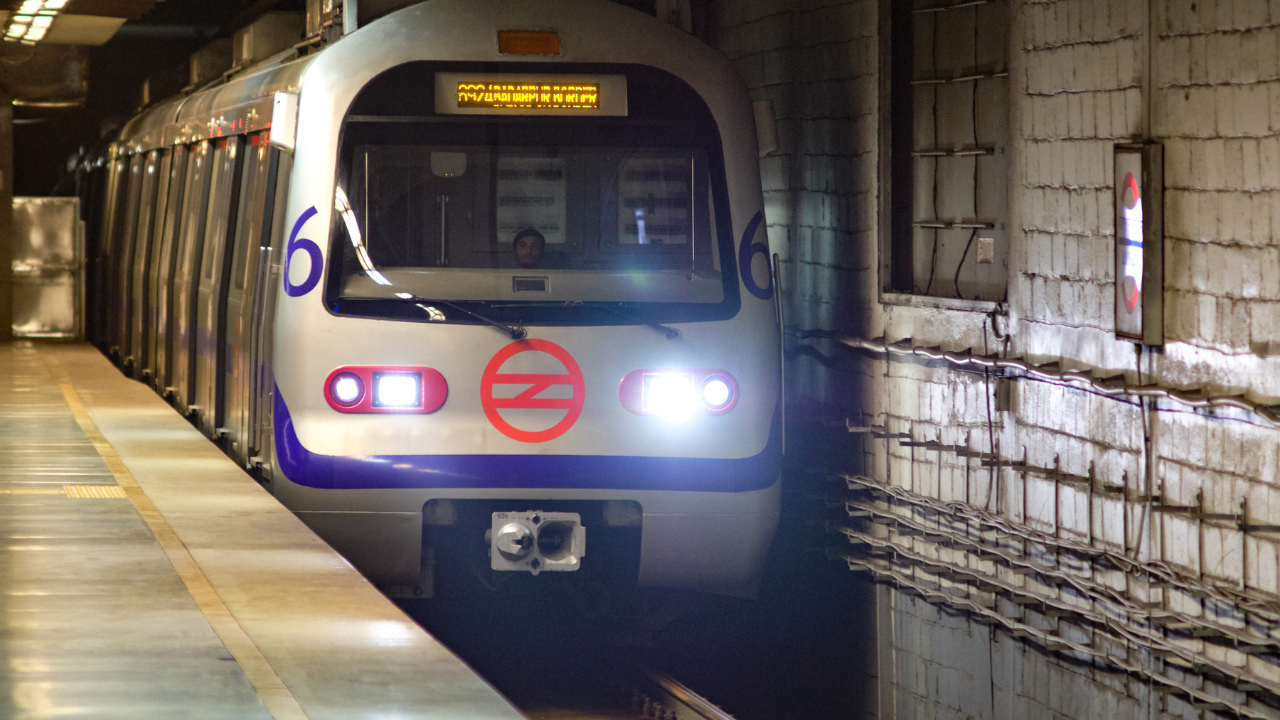
Parts Of Hyderabad To Face Water Supply Cut On Thursday, Check List Of Affected Areas

Javed Akhtar Buys New Property In Juhu For Whopping Rs 7.76 Crore

Anvadhan and Ishti: Date, Time, Tithi And Significance Of The Festival

Argentina vs Ecuador, Quarter-Final: Will Lionel Messi Play Copa America 2024 Match Against Ecuador?

Dog 'Obsessed' With Timothee Chalamet Rejects Barbie, Actor Simu Liu Reacts

'Haven't Seen Anyone Like This': Chandrababu Naidu Brands Jagan Mohan Reddy 'Mental Fellow' In Strong Rebuke

Peacock on Board: Woman's Unique Pet Shocks Airline Passengers | Video

Shweta Tiwari RARE INTERVIEW: 'Wahi Saas Ke Taane, Kaun Dekh Raha Hai?'
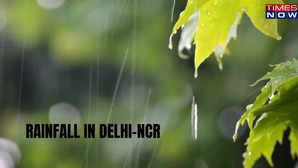
Rain Lashes Delhi-NCR, More Showers Expected In Next 2 Hours: IMD

'Built After Whatever Left Post Income Tax, GST...': Doctor As Wife's Clinic In Delhi's 'Posh GK' Submerges

WATCH: Was Shatabdi Better? Chaos Inside Delhi-Varanasi Vande Bharat, Railway Says It’s 'Slight...'

Delhi Traffic Alert: Vehicle Flow Affected On MB Road As DMRC Carries Out Construction Work

How Delhi Plans to Ply 9-Metre-Long E-Buses on Encroached Roads; DETAILS
- AU: 1-800-665-977
- UK: 0-808-189-1339
- Global: 86-29-8526-9897
- Destinations
- Middle East
- South America
- Central America
- North America
- Tailor My Trip
- Weather & Best Time
- Attractions
- Transportation
- Nightlife in Delhi
- Things to Do
- 10 Best Places to Visit
- Facts about Delhi
- Souvenirs & Shopping

Delhi to Noida Metro – How to Travel, Timings, Fare
Delhi Metro Line 3 (Blue Line) operated by Delhi Metro Rail Corporation (DMRC) runs from Dwarka Sector 21, passes by central New Delhi and reaches Noida City Centre and Noida Electronic City.
Travel Plan by Metro from New Delhi to Noida City Centre
Noida greater noida metro, noida metro route & stations, noida metro timings – first and last trains, noida metro fare.
The fare is calculated based on the stations you take.
Noida Metro doesn’t support the use of Delhi Metro Card, and you can only buy the ticket by cash. The other way is to use SBI NMRC – CITY 1 Card to take Noida metro.
You May Like:
- About Agate
- In the Media
- Affiliate Program
- Customer Service
- Loyalty & Referral
- Terms & Conditions

Copyright © 1997-2024 All rights reserved
Swatantrya Veer Savarkar Box Office Collection
How to find the perfect haircut for your face shape, enhancing literary appreciation through performance, miyapur nearest metro station.
Metro LookUp

List of Top Government Jobs After B.Com

Some Basic Concepts of Chemistry Notes for NEET
Delhi metro card – how to buy, use, and recharge.

Table of Contents:
In current time it is very important to buy a Delhi metro card to easily travel in Delhi metro and not just for locals also for travellers too. It will make your journey in Delhi metro very smooth and you must take benefits of a completely automatic fare collection system. Anyone can buy Delhi metro card at any Customer Care Centers present at metro stations. Delhi Metro provides two types of this smart cards: travel smart card for locals and tourist smart card for travellers. It is more convenient and economical to buy Delhi metro smart card than token for each single journey.
Delhi Metro Tourist Card – for short duration of time
This kind of card is very suitable for travellers because they can take Delhi Metro for unlimited trips on all metro lines within the valid time period. However, the Airport express line is not included in this, so you have to buy the metro token separately if you use airport line in your journey.
Two Types of Tourist Cards:
- Tourist Card for 1-Day, it will cost you Rs 200/-
- Tourist Card for 3-Day, it will cost you Rs 500/-
Note* : When you return your smart card to Delhi Metro Customer Center, you will get Rs 50 refund.
How to Use Delhi Metro Tourist Card:
First you need to enter metro station after security check you need to swipe your tourist card at the entrance gate to open it for the metro station platform. Swipe your card at the exit gate, travelling cost will automatically deduct the balance from your card.
Delhi Metro Smart Card Purchase from:
This smart card is readily available to buy at any metro station’s ticket counter or customer service centre. The minimum amount that must be paid at the time of purchase is Rs 150, which includes a Rs 50 deposit that is refunded when you return the card.
- Customer Care Centre
- Smart Card vending machine
- For Rs. 150/- (Rs. 50/-Security Deposit plus Rs. 100/- Add value)
How to Refund Delhi Metro Card:
Card balance plus security deposit for the smart card of Delhi Metro is refundable but it will charge you Rs.5 regardless of whether the card is intact or not damaged. If your smart card is undamaged and clean, then the balance and deposit will be refunded after 4 working days from the time of submitting the application. Keeping your card receipt safely is the most important thing. When you will go to take refund, you have to provide it.
Delhi Metro Travel Card – For Daily or frequent commuters, or tourists stay for a long time
The Delhi Metro Smart Travel Card is valid for the following ten years from the moment of purchase or, subsequently, from the date of the last top-up. This smart card is readily available to buy at any metro station’s ticket counter or customer service centre. The minimum amount that must be paid at the time of purchase is Rs 150, which includes a Rs 50 deposit that is refunded when you return the card.
Discounts provided when using the Travel Card:
Users of the Delhi Metro Card receive a 10% discount. Passengers will be rewarded with an additional 10% discount if they travel the metro during off-peak hours. Passengers therefore can take advantage of a total 20% discount during certain hours.
How to Use Delhi Metro Travel Card:
This Smart Card can be used similarly to the Delhi Metro Tourist Card. To purchase a ticket, walk up to the counter, then swipe your card at the metro station’s entrance or exit.
- Where to Get the New Delhi Metro Travel Card Recharged:
- Customer service centre: All metro stations only accept cash for card top up.
- Token Vending Machines: These are present at many stations and require a minimum recharge of Rs 100.
- Point of Sale: In a few stations, customers must reload using a credit or debit card from any bank.
- Online: Log in to www.dmrcsmartcard.com and proceed with the top-up procedures.
- SMS: The Add Value Machines in most metro stations allow customers with ICICI accounts to top up cards through SMS. Visit www.dmrcsmartcard.com to see the stations that are accessible.
- Auto Top up: DMRC-ICICI Bank Combo Card users at some stations can top up their cards via the automatic fare collection entry gates. When the balance on the Delhi Metro Card falls below Rs. 100, a Rs. 200 auto-recharge will occur.
Benefits of Delhi Metro Smart Card:
- Avoid standing in queue
- Freedom of choice of originating and destination station.
- Minimum discount of 10% on every journey.
- Used in DTC, Cluster & Metro feeder buses
Leave a Reply Cancel reply
Your email address will not be published. Required fields are marked *
Save my name, email, and website in this browser for the next time I comment.
Related News

How to Avoid Plagiarism with 4 Simple Steps

Tourist Smart Card: You can do unlimited tour for just Rs 200 on Delhi Metro through this card; check rules, benefits and how to buy
M any of us don't know about Delhi Metro's one-day tourist card facility. There is a very good option for people who don't travel frequently in the metro. For those people, The Delhi Metro launched special 'Tourist Smart Cards', offering "unlimited rides" in the metro network in September 2023.
Tourist Smart Card: Types
There are two types of travel cards: One-day card and three days card.
How to buy a Tourist Smart Card
You can get this tourist card at any of Delhi's metro stations. With this card which has a validity of one day or three days, you can travel unlimited times inside Delhi Metro. You will not have to pay any extra charge for this.
Tourist Smart Card: How much you need to pay
The price of a tourist card with a validity of one day is Rs 200, of which Rs 50 is refundable and the price of a three-day tourist card is Rs 500. This card also includes a refundable security deposit of Rs 50. This tourist card can be used unlimited times at all metro stations except the Airport Express Line.
Tourists can also download the official app of 'Delhi Metro Rail' (DMRC App) to plan their travel. The app also includes a dedicated section called 'Tour Guide' on the home page. In this, tourists can see the list of all the stations around any tourist destination in Delhi.
Delhi Metro is closely connected to practically all of Delhi's main tourist attractions, including the Red Fort, Jama Masjid, Akshardham Temple, and Kalkaji Temple. In such cases, travellers may easily access these tourist destinations by travelling via various corridors of the Delhi Metro using these passes.
Meanwhile, The Delhi Metro Rail Corporation (DMRC) said on Sunday, June 30 that more than half of the work on the three key lines for Delhi Metro's fourth phase extension project has been completed.
"The Phase 4 expansion project is moving quickly, to launch all three priority routes, totaling 65 kilometers of additional lines, by 2026," said DMRC authorities.
"At present, more than 50 per cent progress has already been achieved on all three corridors. On the Majlis Park-Maujpur corridor, about 80 per cent of civil work has been completed," the DMRC's principal executive director of corporate communications Anuj Dayal said. Read more on this zeebiz.com/india/news-dmrc-whatsapp-number-qr-code-ticket-fourth-phase-extension-50-per-cent-work-completed-on-all-3-corridors-majlis-park-maujpur-aerocity-tughlakabad-janakpuri-west-rk-ashram-marg-298900

- India Today
- Business Today
- Harper's Bazaar
- Brides Today
- Cosmopolitan
- India Today Hindi
- Reader’s Digest
- Aaj Tak Campus
Delhi Metro's Magenta Line transitions to fully driverless trains
Delhi metro joins only 7 per cent of the world's metro networks capable of autonomous train operation, as the magenta line goes driverless..
Listen to Story

- Delhi Metro joins 7% of global metro networks with autonomous trains
- Entire operation on Magenta Line now becomes fully driverless
- It increases passenger space, advanced safety features introduced
The Delhi Metro's Magenta Line has transitioned to fully driverless trains. With 29 trains now operating without driver cabins, passenger space has increased, enhancing the commuter experience.
Attendants will be phased out gradually, but they will still be present between every 3-4 trains for the time being, the Delhi Metro Rail Corporation (DMRC) said.
By initiating driverless operations, the Delhi Metro joins only 7 per cent of the world’s metro networks capable of running trains autonomously.
This advancement reduces human error and improves the availability and reliability of train services, according to the officials. These driverless trains automate pre-induction checks and parking at depots, effectively reducing the workload on human operators and streamlining operations.
The Magenta Line, stretching approximately 37 km and encompassing 25 stations from Janakpuri West to Botanical Garden, first saw driverless train operation in December 2020. Similar technology was implemented on the Pink Line (Majlis Park to Shiv Vihar) in November 2021. Initially, a train operator remained onboard, but the trains have now transitioned to complete automation.
The removal of driver's cabins has been complemented by redesigned grab poles, increased standing capacity, and CCTV surveillance for security. Real-time track monitoring, digital route maps with LCD displays, and LED backlighting enhance commuter convenience and safety. A live video streaming feature has been introduced, offering real-time insights for passengers.
IN THIS STORY
- Logout Login
- Adventure Holidays
- Weekend Getaways
- Driving Holidays
- Travel News
Top Searches
Kerala Destinations
India Forest Destinations
Madhya Pradesh Places
India Beaches
Malaysia Travel Program
Leopard Types
Coming soon: Direct metro connectivity from Greater Noida to Delhi Airport, Railway Station
Times of India TIMESOFINDIA.COM / Updated : Jun 28, 2024, 12:06 IST
You're Reading
The Noida Metro Rail Corporation (NMRC) hailed this Cabinet approval as a ‘pivotal step’ in enhancing the city's Metro network, promising ‘substantial benefits to the region.’ NMRC Managing Director Lokesh M described the state ca … Read more
The Noida Metro Rail Corporation (NMRC) hailed this Cabinet approval as a ‘pivotal step’ in enhancing the city's Metro network, promising ‘substantial benefits to the region.’ NMRC Managing Director Lokesh M described the state cabinet's nod as a significant step that will ensure "seamless public transportation. Read less
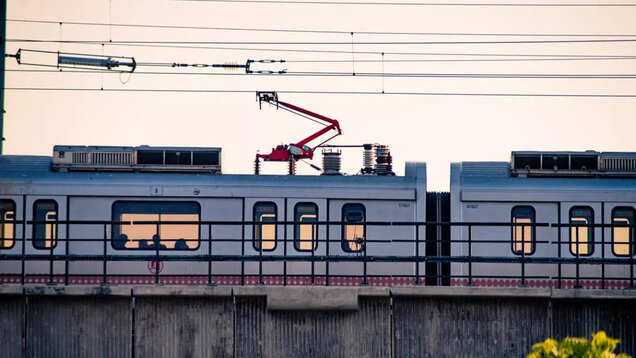
Popular countries with no railway network!
More from travel news.

Addressing the demand for efficient mobility

Seamless connectivity to Delhi
About the project, comments (0).

Refrain from posting comments that are obscene, defamatory or inflammatory, and do not indulge in personal attacks, name calling or inciting hatred against any community. Help us delete comments that do not follow these guidelines by marking them offensive . Let's work together to keep the conversation civil.
Comments ( ) Sort: Newest UpVoted Oldest Discussed Down Voted closecomments

SIGN IN WITH
Or post without registration.

Visual Stories
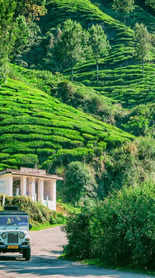
Popular Galleries
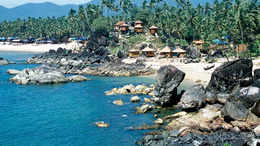
The most beautiful beaches in India you must at least visit once in your lifetime TRAVEL TRENDS , INDIA

India's best forest vacations TRAVEL TRENDS , INDIA

The least populated cities in the world TRAVEL TRENDS , WORLD
Trending stories.
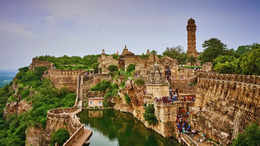
9 places to visit in Rajasthan during monsoon

- No visa fees for Malaysians visiting India under new travel program

The most beautiful beaches in India you must at least visit once in your lifetime

- What is Pranam Sewa at airports and who can avail it?

- 10 hidden gems of Madhya Pradesh we are missing out on
- 1 Coming soon: Direct metro connectivity from Greater Noida to Delhi Airport, Railway Station
- 2 Melting Abraham Lincoln: Heatwave turns DC statue into viral sensation
- 3 Bannerghatta Biological Park introduces leopard safari and afforestation efforts
- 4 Will Delhi get drenched this weekend? Find out here
- 5 Iceland’s volcanic eruptions likely to last for decades, say researchers

THE DEFINITIVE GUIDE TO DESTINATIONS, ITINERARIES, THINGS TO DO, RESTAURANTS, NIGHTLIFE and LOTS MORE!
FOLLOW US ON
Places to visit.
- Places to visit in Bangalore
- Places to visit in Mumbai
- Places to visit in Delhi
- Places to visit in Goa
- Hotels in Goa
- Hotels in Jaipur
- Hotels in Shimla
- Hotels in Mumbai
Things To do
- Things to do in Goa
- Things to do in Mumbai
- Things to do in Bangalore
- Things to do in Delhi
Travel Inspiration
- Visa on arrival for Indians
- Honeymoon Places in india
- Hill Stations in India
- Weekend getaways in Mumbai
- Weather in Delhi
- Weather in Chennai
- Weather in Bangalore
- Weather in Mumbai
Best Beaches
- Goa Beaches
- Mumbai Beaches
- Pondicherry Beaches
- Kerala Beaches
- Restaurants in Bangalore
- Restaurants in Chennai
- Restaurants in Pune
- Restaurants in Jaipur
- Hill Station near Delhi
- Winter trip to Ladakh
- Places to visit in Kerala
- Winter Honeymoon Destinations
- UK visa guide for Indians
- Winter Trip to Manali
- Vaishno Devi Yatra
- Special Train Ticket Booking
- HP inter-state Bus
- Honeymoon Destinations India
Latest News
- What are the rules for carrying alcohol on domestic Indian flights?
Congratulations!
You have been successfully added to the mailing list of Times of India Travel. To complete the subscription process, kindly open your inbox and click on the confirmation link which has been emailed to you.
Share with friends
Thank You for sharing! Your friend will receive the article link on email mentioned.
- (For more than one recipient, type addresses separated by commas)
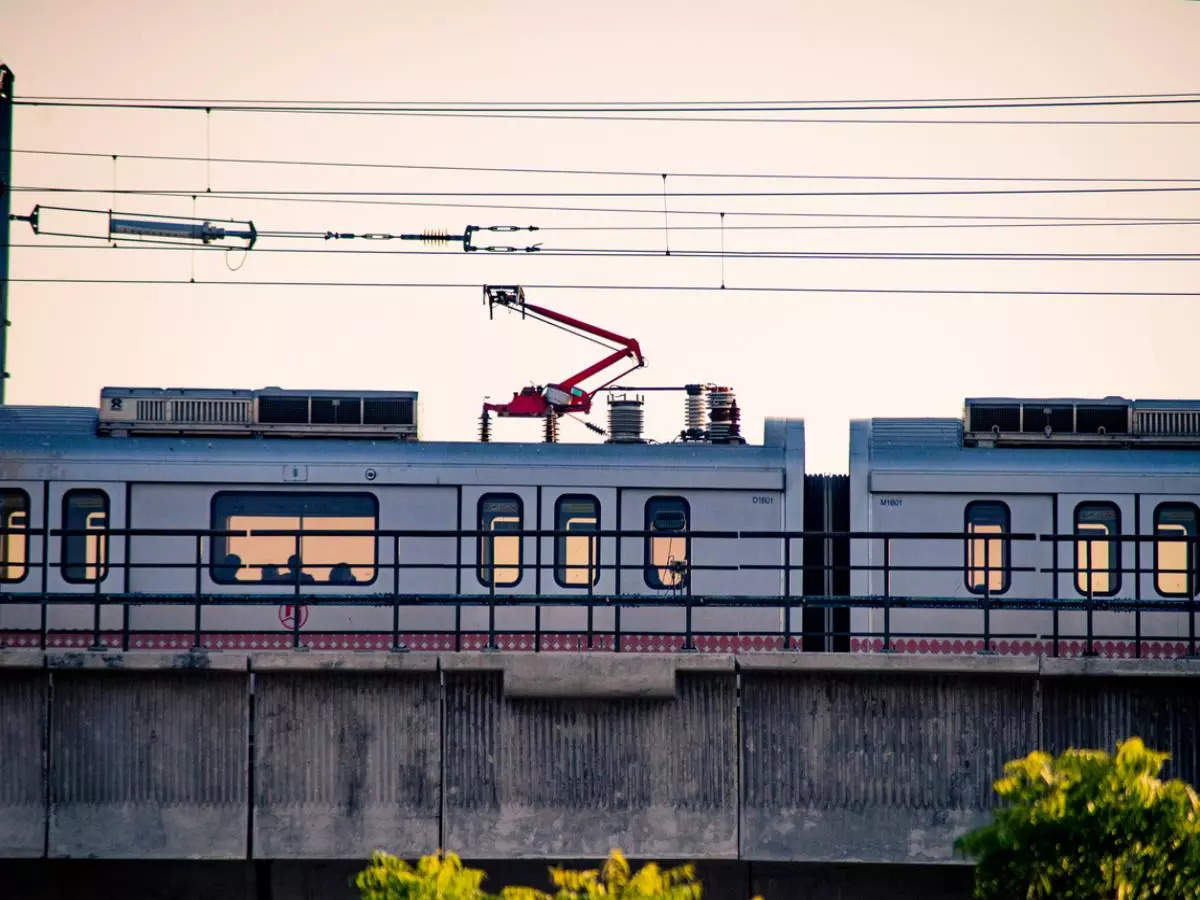
The Noida Metro Rail Corporation (NMRC) hailed this Cabinet approval as a ‘pivotal step’ in enhancing the city's Metro network, promising ‘substantial benefits to the region.’ NMRC Managing Director L...

- Market Trends
- Current News
- Infrastructure
- Locality Trends
- Seller Corner
- Commercial Realty
- Budget 2022
- Budget 2023
- Budget 2024
- Coronavirus
- Citizen Services
- Personal Finance
- Construction Know-How
- City Transport
- PG / Co-Living
- Celebrity Homes
- Famous Monuments
- Green Homes
- Home Automation
- Home Improvement
- Shopping Hubs
- Rent Receipt Online
- Pay Rent Online
- Rent Agreement Online
- Personal Loan
- Personal Loan EMI Calculator
- Personal Loan Eligibility Calculator
- Web Stories
Home » Current News » Three Delhi Metro Phase 4 priority corridors to open by 2026
Three Delhi Metro Phase 4 priority corridors to open by 2026

July 3, 2024: The Delhi Metro Rail Corporation (DMRC) has announced that it plans to open all three priority corridors of the Phase 4 expansion project spanning 65 kilometre by 2026. Over 50% of the work on all the priority corridors has been completed. The Phase 4 expansion project, which started in December 2019 after finalising tenders, witnessed major hurdles from 2020 to 2022 due to the Covid-19 pandemic and delays in regulatory permissions.
The DMRC said that 80% of the civil work at Majlis Park–Maujpur section has been completed while tunnelling operations are underway on stretches of the Aerocity–Tughlakabad (Golden Line) and Janakpuri West–RK Ashram Marg (Magenta Line) corridors.
A section from Janakpuri West to Krishna Park Extension on the Magenta Line is nearing completion and is expected to open by August 2024. Currently, the Magenta Line operates between Botanical Garden and Janakpuri West, and the line is being extended from Janakpuri West to RK Ashram. The Majlis Park–Maujpur corridor is also expected to commence operations by next year. The remainder of the priority corridors is scheduled for phased openings by 2026, pending final approvals for tree cutting and land acquisition at specific sites, according to DMRC as cited in media reports.
The project is being monitored at various levels on a day-to-day basis. Site visits are also taken up at the highest level to expedite the work. Tree-cutting permissions are being pursued at appropriate levels, DMRC posted on X.
Two new corridors, Inderlok-Indraprastha and Saket G Block-Lajpat Nagar, have recently received approval. DMRC is navigating statutory clearances and land acquisition procedures alongside efforts to secure forest clearances and tree-cutting permissions.
- 😃 ( 0 )
- 😐 ( 0 )
- 😔 ( 1 )
Harini is a content management professional with over 12 years of experience. She has contributed articles for various domains, including real estate, finance, health and travel insurance and e-governance. She has in-depth experience in writing well-researched articles on property trends, infrastructure, taxation, real estate projects and related topics. A Bachelor of Science with Honours in Physics, Harini prefers reading motivational books and keeping abreast of the latest developments in the real estate sector.
Related Posts
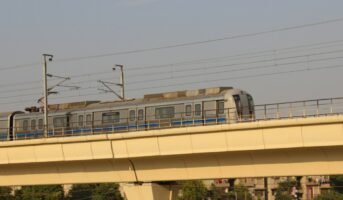
Delhi govt approves Janakpuri – RK Ashram metro corridor; grants permit for removal, transplantation of trees.

Noida, south Delhi closer, as PM inaugurates Delhi Metro’s Magenta Line.

Delhi CM seeks CBI enquiry into alleged corruption in Airport Express Metro Line.

NGT orders sealing of illegal borewells operated by DMRC.

Delhi Metro Phase 4 upcoming projects, stations list, latest updates.

12 more Delhi Metro stations get e-rickshaw facility, to boost last-mile connectivity.
Recent Podcasts

- Delhi Metro Phase 4
- Delhi Metro Rail Corporation
- Business Today
- India Today
- India Today Gaming
- Cosmopolitan
- Harper's Bazaar
- Brides Today
- Aajtak Campus

- Budget 2024
- Magazine Cover Story Editor's Note Deep Dive Interview The Buzz
- BT TV Market Today Easynomics Drive Today BT Explainer
- Market Today Trending Stocks Indices Stocks List Stocks News Share Market News IPO Corner
- Tech Today Unbox Today Authen Tech Tech Deck Tech Shorts
- Money Today Tax Investment Insurance Tools & Calculator
- Mutual Funds
- Industry Banking IT Auto Energy Commodities Pharma Real Estate Telecom
- Visual Stories

INDICES ANALYSIS
Mutual funds.
- Cover Story
- Editor's Note
- Market Today
- Drive Today
- BT Explainer
- Trending Stocks
- Stocks List
- Stocks News
- Share Market News
- Unbox Today
- Authen Tech
- Tech Shorts
- Tools & Calculator
- Commodities
- Real Estate
- Economic Indicators
- BT-TR GCC Listing
Delhi Metro Magenta Line becomes driverless; 29 trains running with no manual intervention
Delhi metro rail corporation’s (dmrc’s) driverless operations on the magenta line makes it part of the elite 7 per cent of the world's metro networks capable of running trains autonomously..
- Updated Jul 03, 2024, 1:04 PM IST

The Delhi Metro's Magenta Line has introduced fully driverless trains, marking a significant development in urban transportation. With 29 trains now operating without driver cabins, passenger space has increased. Attendants will be phased out gradually but will be present on every 3-4 trains for now.
Delhi Metro Rail Corporation’s (DMRC’s) driverless operations on the Magenta Line makes it part of the elite 7 per cent of the world's metro networks capable of running trains autonomously. This development enhances flexibility, reduces human error, and improves the availability and reliability of train services.
Related Articles
- Delhi Metro introduces seamless travel experience with 'One Delhi' app integration
The driverless trains automate pre-induction checks and parking at depots, reducing the workload on human operators and streamlining operations.
The Magenta Line, covering around 37 km with 25 stations from Janakpuri West to Botanical Garden first introduced driverless train operations in December 2020. Following this, the Pink Line (Majlis Park to Shiv Vihar) adopted similar technology in November 2021. Initially, a train operator was onboard for support, but with growing trust and advanced technology, the trains have now fully transitioned to automation.
In an effort to enhance passenger comfort and space, driver cabins and partition walls have been removed. This redesign includes new grab poles, increased standing capacity, and advanced CCTV surveillance for security. Commuter convenience and safety are further improved with real-time track monitoring, Digital Route Maps with LCD displays, and LED backlighting. Additionally, live video streaming has been introduced, offering passengers real-time insights.
The DMRC will enhance its transit system by procuring 312 metro coaches (52 trains) for driverless operations in Phase IV's priority corridors. This initiative aims to set new standards for urban transit in India and aligns with DMRC's vision for a smarter, more efficient, and safer public transport system.
TOP STORIES

- Advertise with us
- Privacy Policy
- Terms and Conditions
- Press Releases
Copyright©2024 Living Media India Limited. For reprint rights: Syndications Today

Add Business Today to Home Screen
You are using an outdated browser. Please upgrade your browser to improve your experience and security.
Wednesday, 03 July 2024

Agenda - The Sunday magazine
- Cover Story
State Editions
Monsoon rain causes flooding, massive traffic jams in delhi-ncr.
Amid monsoon marking its arrival in the national Capital in the wee hours of Friday, heavy rain wreaked havoc in Delhi causing waterlogging in many areas of the city which led to a flood-like situation forcing vehicles to crawl amid massive traffic jams.
The Delhi Traffic Police issued alerts to notify the affected carriageways, advising commuters to plan their journey accordingly. Visuals coming from various parts of the city showed several areas inundated with water, leading to long traffic jams which affected commuters, especially, office-goers.
The Delhi Police said they received several calls regarding traffic issues, waterlogging and uprooting of trees since the morning. Visuals emerged of Delhi Traffic Police standing in knee deep waters trying to help commuters navigate their ways amid flooding on the city roads.
At the New Delhi Railway Station, people had to walk through knee-deep water, carrying children to navigate the flooded roads. Water also filled metro stations in some areas, adding to the discomfort of the commuters. According to the police, traffic is affected on Anuvrat Marg in both the carriageways from 100 Foota Red Light and Lado Sarai Red Light and vice-versa due to waterlogging. The Delhi Metro announced the temporary closure of entry and exit points at Yashobhoomi Dwarka Sector - 25 Metro station while shuttle services from Delhi Aerocity Metro station to Terminal 1 of Indira Gandhi International (IGI) Airport have been suspended.
Several MPs who were in the capital due to the ongoing Parliament session shared visuals of waterlogging outside their residences in Lutyen’s Delhi. Congress MP Shashi Tharoor said his entire home was under a foot of water and the carpets and furniture inside his residence were ruined. Samajwadi Party MP Ram Gopal Yadav was lifted to his cars by his staff to carry him to his car the road outside his bungalow in the Lodhi Estate area was inundated.
Delhi Water Minister Atishi’s residence was also submerged as visuals showed severe flooding outside the residence of the AAP leader. On Ring Road, waterlogging caused slow traffic in both directions from Naraina towards Moti Bagh and vice-versa under the Dhaula Kuan Flyover. Traffic is also affected in both the carriageways on Vir Banda Bairagi Marg due to waterlogging at the Azad Market underpass.
On Aurobindo Marg, traffic was stuck in both directions from INA towards AIIMS and vice-versa due to waterlogging under the AIIMS Flyover. It was also slow on the Outer Ring Road in both directions from Shantivan towards ISBT and vice-versa due to waterlogging near Y-point Saleemgarh and Nigambodh Ghat.
Due to waterlogging below Tilak Bridge W-point, traffic was disrupted on W-Point Tilak Bridge road in both the carriageways from A-Point to W-Point and vice-versa. On Rohtak road, traffic was affected in both the carriageways from Rajdhani Park towards Mundka and vice-versa due to waterlogging.
The uprooting of a tree has disrupted traffic on Mathura Road in the carriageway from Ashram towards Badarpur. Traffic was affected on Road No. 13 in both directions from Kalindi Kunj towards Crown Plaza and vice-versa due to waterlogging at the Okhla underpass.
Due to a canopy outbreak at Terminal 1 Departure, the area remained non-functional. All passengers heading towards Terminal 1 departure were advised to use the arrival section of Terminal 1. Additionally, there was waterlogging at the Mehram Nagar underpass towards Terminal 3.
Traffic was affected in both the carriageways from Akshardham towards Ghaziabad and vice-versa due to waterlogging at roundabout Murga Mandi, Ghazipur Border. The uprooting of a tree opposite Jwala Heri Market disrupted traffic in the carriageway from Jwala Heri Market towards Madipur.On Minto Road, traffic was stuck in both directions from Kamla Market towards Connaught Place and vice-versa due to waterlogging at the Minto Bridge underpass. Traffic was affected on the Outer Ring road in the carriageway from Bhera Enclave Roundabout towards Peeragarhi due to waterlogging near Peeragarhi Village road.
It was also affected on IP Marg, BSZ Marg and Vikash Marg due to waterlogging and breakdown of vehicles at Tilak Bridge underpass (W-Point). Due to waterlogging near Park Rose Garden, Feroz Shah Kotla (IG Stadium Bus Stop), traffic got affected on MGM (Ring Road) in the carriageway from IP Flyover towards Rajghat and on Mathura Road in the carriageway from Badarpur towards Sarita Vihar due to waterlogging near Tughlakabad Metro Station.
In the NCR area, the traffic was also affected at Noida-Greater Noida Expressway in the morning. Many commuters also took to social media platform X (formerly Twitter) to share updates regarding the traffic situation across the national capital. Some of them claimed that the Barapullah Elevated road was completely choked, while the traffic was also heavy near Mundka-Nagloi road.
Trending News

INDvsZIM: Gill-led new-look Team India lands in Harare for T20Is against Zimbabwe

Colombia draws Brazil 1-1 and will play Panama in quarterfinals

Austria Vs Turkey: Demiral's double helps Turkey beat Austria 2-1

Shah Rukh Khan to receive career achievement award at Locarno Film Festival

US eliminated from Copa America with 1-0 loss to Uruguay

Lot of time for me to sleep, for now I want live every second of this win: Rohit

Australia doubles visa fees for international students; Indians to be hit

Would be an honour to be running mate of Trump: Ramaswamy

Pakistan court rejects appeals by Imran Khan & wife to suspend sentence in illegal marriage case

Former Honduran president sentenced for helping traffickers get tons of cocaine into US

Imran Khan appeals to Pakistan Supreme Court for swift hearing in Toshakhana case

With roots in India, Yoga unites people with its values of balance, mindfulness & peace: UN chief Guterres
Delhi lg, aap govt at loggerheads over removal of ddcd’s non official members, maliwal accuses aap ministers of working to weaken dcw, delhi govt issues flood control order, couple injured as hotel shed collapses, aap targeting women after poll rout: vijender, bjp leaders demand apology from rahul, sunday edition, on a fun filled pawcation, from the pen of a grounded poet, journey to an expanded self awareness, tangra tales, disappointing service mars fine dining experiences, guruspeak | do you pray, e-mail this link to a friend..


COMMENTS
Delhi Metro is a world-class metro. To ensure reliability and safety in train operations, it is equipped with the most modern communication and train control system. It has state-of-art air-conditioned coaches. Ticketing and passenger control are through Automatic Fare Collection System, which is introduced in the country for the first time.
A Brief History. For starters, the metro system in Delhi is still relatively new; it opened in December 2002. One of the most important facts about it is that it's the first railway system in the entire world to get a United Nations certification for reducing greenhouse gas emissions. This is huge for Delhi, and, as a result, locals are very ...
Enter the Airport Express Line, one of Delhi Metro's gems. 1. Where to Find the Airport Express Line at the Airport: As soon as you exit the baggage claim area, follow the signs for the metro. The Delhi Airport Metro Station is strategically located at Terminal 3. If you happen to land at Terminal 1 or 2, don't fret.
Metro Tickets, Timetable, and Security. Trains on the five regular lines run from about 5.30 a.m. until 11.30 p.m. A listing of last train departures is available on the Delhi Metro Rail website. The frequency of trains ranges from every couple of minutes during peak hours, up to 10 minutes at other times. This journey planner provides details ...
Presently there are 231 active stations in Delhi Metro network. Find important and useful information like Delhi Metro route, metro lines, service operation timings, first train, last train, route map, fare chart, top attractions near metro station, metro station nearby, news and more. Operator. Delhi Metro Rail Corporation (DMRC) Operation start.
Tips for Getting Around Delhi. Public transport widely shuts down at night in Delhi, although night service buses continue to operate on prominent routes. Avoid traveling on the Metro during peak hours from around 9-10 a.m. and 5-6 p.m. Buses get super crowded during peak hours as well, from 8-10 a.m. and 5-7 p.m.
Delhi Metro is an urban Mass Rapid Transit System (MRTS) built with 10 lines and 254 stations to serve India's capital along with other towns in the National Capital Region (Gurgaon, Noida and others) by the Delhi Metro Rail Corporation (DMRC). ... • Tourist Pass - 2 types available for travel on all lines except the Airport Express Line ...
Airport Express Line. It's easy to get to all terminals of the airport using the metro. The Orange Line is the Airport Express Line and it stops at Indira Gandhi International Airport, Terminal 3. These trains operate from 5:30 am to 11:30 pm daily. It takes 23 minutes to travel from New Delhi station to the airport.
Delhi Metro is one of the largest metro systems in the world and certainly the best in India. It has 8 Color Coded lines and 231 stations, building more than 300 Kilometers (190 miles) of network ...
Not all Delhi metro rail gates will be open for passengers for making an entry to the station. For example, stations like Rajiv Chowk, Kashmiri Gate, Central Secretariat, Hauz Khas will have two gates open for passengers entry. (Of a total of 671 gates of Delhi Metro, only 257 will remain open during this period. that is 38% of the entry points).
The Delhi Metro is an integrated transport system serving the city of Delhi and its neighbouring districts. Operated by the Delhi Metro Rail Corporation Limited (DMRC) - a State-owned company overseen by both the central and state governments - the metro extends over a total length of 296.1 kilometres (184 miles).
Get In Touch. Metro Bhawan Fire Brigade Lane, Barakhamba Road, New Delhi - 110001, India EPABX - 011-23417910/11/12
Delhi Metro Rail Corporation (DMRC) has launched a new DMRC Travel app to help users book metro tickets online. The dedicated app will essentially generate a QR code that needs to be scanned while entering the station, following the security check.
How to Travel in Delhi Metro || Delhi Metro Guide, Interchange, Timings, Token || दिल्ली मेट्रोHello Friends, In this video, i am giving you all the info...
The Delhi Metro Rail Corporation (DMRC) on Thursday issued an advisory for travellers in view of increasing cases of the Omicron in the national capital. ... - DMRC in its advisory requested Delhiites to travel via metro only if essential. - A single Delhi Metro coach is allowed to accommodate only 25 passengers. Therefore, an 8-coach train ...
The Delhi Metro Airport Express train line, known as the Orange Line, opened in February 2011. A much anticipated part of Delhi's expanding Metro train network, it cuts travel time to Delhi airport from at least one hour to about 20 minutes. Trains, imported from Spain, travel the 22 kilometers (13.7 miles) at 120 kilometers per hour.
Available for free on both Google Play for Android and the App Store for iPhones, the DMRC Travel app lets you book metro tickets hassle-free. Just download the app, create an account, and log in. Once you are in, hit the "Book tickets" option on the homepage and enter your start and end destinations. The app will then show you the ticket price ...
Hello Doston, Welcome to our YouTube Channel Vlogs "Traveller Naveen Pahadi"I hope you enjoyed this video.Our Yoga YouTube Channel Link: 👇https://www.youtub...
Delhi Metro Timings - First and Last Train Timetable. Delhi metro serves Old and New Delhi, and its satellite cities of Gurgaon, Faridabad, Noida, and Ghaziabad. The Delhi Metro operates approximately from 5:00 a.m. to 23:30 p.m., with slightly difference according to different lines and stations. For example, the airport express line ...
The Delhi metro fare is around Rs 10-Rs 80 for one-way trip. Locals prefer to use Delhi metro travel card, while travelers are suggested to buy tourist card. US & Canada: 1-800-315-3949
Delhi Metro Line 3 (Blue Line) operated by Delhi Metro Rail Corporation (DMRC) runs from Dwarka Sector 21, passes by central New Delhi and reaches Noida City Centre and Noida Electronic City. Travel Plan by Metro from New Delhi to Noida City Centre From New Delhi Station, take the Metro Line 2 (Yellow Line) towards Huda City Centre, for one ...
How to Use Delhi Metro Travel Card: This Smart Card can be used similarly to the Delhi Metro Tourist Card. To purchase a ticket, walk up to the counter, then swipe your card at the metro station's entrance or exit. Where to Get the New Delhi Metro Travel Card Recharged: Customer service centre: All metro stations only accept cash for card top up.
Tourist Smart Card: Types. There are two types of travel cards: One-day card and three days card. How to buy a Tourist Smart Card. You can get this tourist card at any of Delhi's metro stations.
Delhi Metro joins 7% of global metro networks with autonomous trains Entire operation on Magenta Line now becomes fully driverless It increases passenger space, advanced safety features introduced The Delhi Metro's Magenta Line has transitioned to fully driverless trains. With 29 trains now ...
The Noida Metro Rail Corporation (NMRC) hailed this Cabinet approval as a 'pivotal step' in enhancing the city's Metro network, promising 'substantial benefits to the region.' NMRC ...
July 3, 2024: The Delhi Metro Rail Corporation (DMRC) has announced that it plans to open all three priority corridors of the Phase 4 expansion project spanning 65 kilometre by 2026. Over 50% of the work on all the priority corridors has been completed. The Phase 4 expansion project, which started in December 2019 after finalising tenders, witnessed major hurdles from 2020 to 2022 due to the ...
Delhi Metro Rail Corporation's (DMRC's) driverless operations on the Magenta Line makes it part of the elite 7 per cent of the world's metro networks capable of running trains autonomously.
Delhi ..#shortsfeed #shorts #viral #viralvideo #youtubeshorts #travel #delhi #song #delhivlog #city #abhayvlogs64
The Delhi Metro announced the temporary closure of entry and exit points at Yashobhoomi Dwarka Sector - 25 Metro station while shuttle services from Delhi Aerocity Metro station to Terminal 1 of ...